Introduction
Automation is revolutionizing the banking industry, driven by the need for enhanced efficiency, cost reduction, and improved customer experience. Financial institutions are increasingly turning to advanced technologies like robotic process automation (RPA) and artificial intelligence (AI) to streamline operations, reduce manual errors, and minimize operational costs. Banks such as M&T Bank and Capital One have embraced digital transformation, leveraging technologies to maintain high standards in code quality, regulatory compliance, and innovation.
AI’s impact on the financial sector is profound, with significant potential to automate and augment tasks across all levels of a bank. This transformation not only improves operational efficiency but also enhances customer experiences by providing real-time, personalized services. However, the journey towards automation is not without its challenges.
Banks must navigate employee resistance, complex system integrations, and stringent regulatory requirements to successfully implement these technologies.
By adopting a strategic approach to automation, including thorough process analysis, proactive employee engagement, and strong partnerships with technology providers, banks can harness the full potential of AI and automation. This ensures they remain competitive in an evolving digital landscape, ultimately driving long-term success and innovation.
Key Drivers of Automation in Banking
Automation in banking is primarily driven by the need for enhanced efficiency, cost reduction, and improved customer experience. Financial institutions are increasingly recognizing that mechanization can streamline operations, reduce manual errors, and minimize operational costs. The incorporation of sophisticated tools, such as robotic process automation (RPA) and artificial intelligence (AI), enables financial institutions to manage large quantities of transactions effortlessly.
For example, M&T, a leading full-service U.S.-based commercial institution, has embraced digital transformation to maintain high standards in code quality and regulatory compliance, ensuring smooth and secure operations. Capital One, another major player in the financial sector, leverages cloud technology and collaborative platforms like Slack to promote a culture of innovation and efficiency.
AI has become a game-changer in the financial industry. Based on Accenture’s analysis, 73% of the time utilized by U.S. financial institution staff has a high potential to be affected by generative AI, with 39% by mechanization and 34% by enhancement. This potential reaches virtually every part of a bank, from the C-suite to the front lines of service.
Moreover, the increasing demand for real-time services and tailored financial experiences drives organizations to embrace mechanized solutions that deliver prompt, precise responses to customer requirements. Transparent communication about the capabilities and limitations of automated systems is vital for building trust and managing customer expectations. Continuous staff training and development are also crucial to strike the right balance between digital and human-led experiences.
In summary, automation in financial services not only enhances operational efficiency and reduces costs but also significantly improves customer experience, positioning financial institutions for long-term success in an evolving digital landscape.
Benefits of Automation in Banking
Automation in banking offers profound benefits that extend far beyond mere operational efficiency. By automating routine tasks, financial institutions can reallocate human resources to more strategic roles, fostering a culture of innovation and enhancing customer-centric services. Automation plays a pivotal role in ensuring data accuracy and minimizing processing time, which also aids in meeting stringent regulatory standards more effectively. Furthermore, the ability to examine extensive datasets with effectiveness offers financial institutions crucial understandings of consumer behavior and preferences. These insights allow financial institutions to customize their services, thereby enhancing client relationships and satisfaction.
Incorporating machine learning models, such as supervised and unsupervised learning, has revolutionized financial operations, making data structuring and analysis more systematic and accessible. This shift has been significantly supported by tools like Python for Data Analysis and other machine learning libraries, which have laid the groundwork for more advanced analytical frameworks. According to Accenture’s analysis, 73% of the tasks performed by U.S. bank employees could potentially be influenced by generative AI, highlighting the expansive reach of automation within the financial sector.
Moreover, the application of AI in financial services is not just a future concept but a present-day game-changer. Banks that strategically implement AI stand to gain substantial competitive advantages. This transformative technology spans across various financial functions, from the C-suite to frontline services, impacting virtually every part of the value chain. For instance, occupations representing 41% of financial institution employees are engaged in tasks with higher potential for mechanization, underscoring the significant productivity improvements that early adopters can achieve over the next few years.
Ultimately, the strategic application of technology and artificial intelligence in financial services not only enhances operational efficiency but also drives greater value through improved customer experiences, compliance, and data management. This technological evolution positions banks to better navigate the complexities of the modern financial landscape while fostering a more innovative and customer-focused approach.
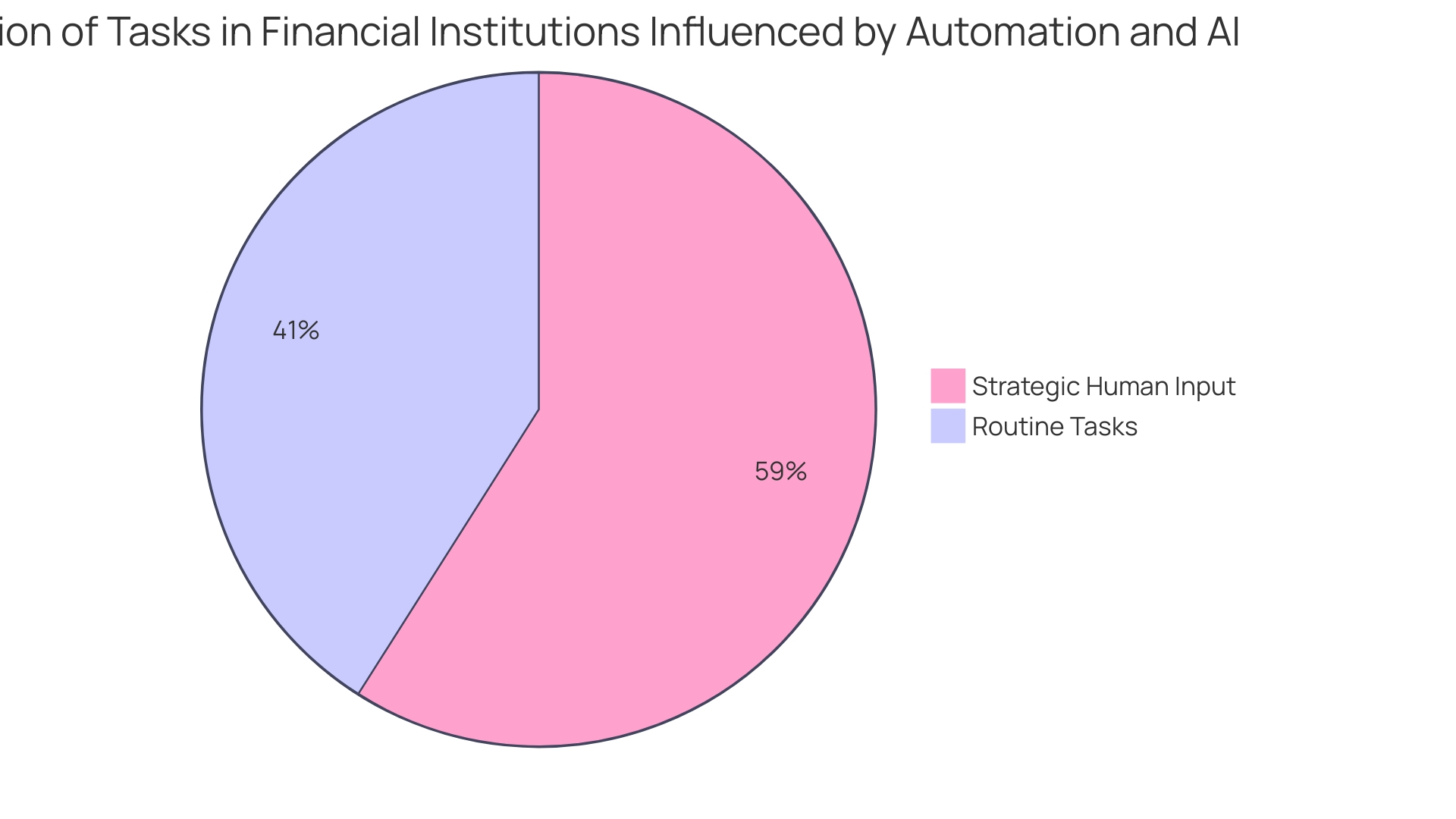
Challenges in Implementing Automation
Implementing automation in financial services, while advantageous, presents significant challenges. One of the primary hurdles is employee resistance. Staff members often fear job displacement or struggle to adapt to new technologies, which can impede the adoption process. For instance, TBC Bank, Georgia’s leading financial institution, faced such challenges while transforming their operations to offer a seamless digital banking experience.
Another major challenge is the complexity of integrating automation with existing systems. This integration often necessitates substantial investments in both systems and training. M&T Financial Institution, one of the leading U.S.-based commercial entities, acknowledged these challenges as they endeavored to create organization-wide Clean Code standards to enhance software maintainability and performance. Such efforts are critical in ensuring the smooth running of operations and maintaining high levels of security and compliance.
Compliance with regulatory requirements adds another layer of complexity. Banks must ensure that their automated processes meet industry standards to avoid penalties and maintain customer trust. The financial sector, heavily reliant on data, must adhere to stringent regulatory requirements to protect sensitive information. The rapid adoption of new technologies necessitates that banks continuously update their systems to remain compliant, as highlighted in a recent issue of the e-journal Ethics & Armed Forces, which emphasized the importance of robust regulatory frameworks in industries integrating advanced technologies.
In summary, while mechanization promises enhanced efficiency and innovation in financial services, overcoming employee resistance, managing complex integrations, and ensuring regulatory compliance are critical to successful implementation.
Best Practices for Automation in Banking
To successfully execute mechanization in banking, a strategic approach is essential. Start with a thorough examination of current procedures to identify areas ready for mechanization. ‘This methodical assessment is critical, as it allows institutions to identify and prioritize the most impactful opportunities for mechanization, ensuring a targeted and efficient implementation.’.
Engaging employees throughout the transition period is equally important. This engagement can mitigate resistance and foster a culture of innovation. As experts emphasize, combining mechanization with AI can significantly boost creativity and productivity, but it also presents challenges related to employment displacement and skill development. Therefore, inclusive communication and training programs are vital to help employees adapt and thrive in an automated environment.
‘Establishing clear metrics for success is another cornerstone of a strategic mechanization approach.’. By establishing and monitoring specific objectives, banks can assess the effect of mechanization on operational efficiency and make data-informed modifications as necessary. ‘According to a McKinsey study, companies that effectively harness digital and AI tools not only generate value more quickly but also create a significant competitive edge over their peers.’.
Collaborating with service providers can enhance the seamless incorporation of mechanization solutions. Partnering with knowledgeable suppliers guarantees that the selected innovations correspond effectively to the particular requirements of the financial sector, from transaction processing to adherence with Anti-Money Laundering (AML) regulations. ‘Real-world instances, such as Capital One’s method for system rollouts, highlight the significance of engaging varied stakeholders and applying quantitative planning methods to manage the intricacies of large-scale mechanization projects.’.
In summary, a strategic method for mechanization in financial institutions entails comprehensive process examination, proactive staff involvement, clear success indicators, and robust collaborations with service providers. This multi-faceted strategy not only improves operational efficiency but also enables banks to utilize the full potential of AI and automated systems.
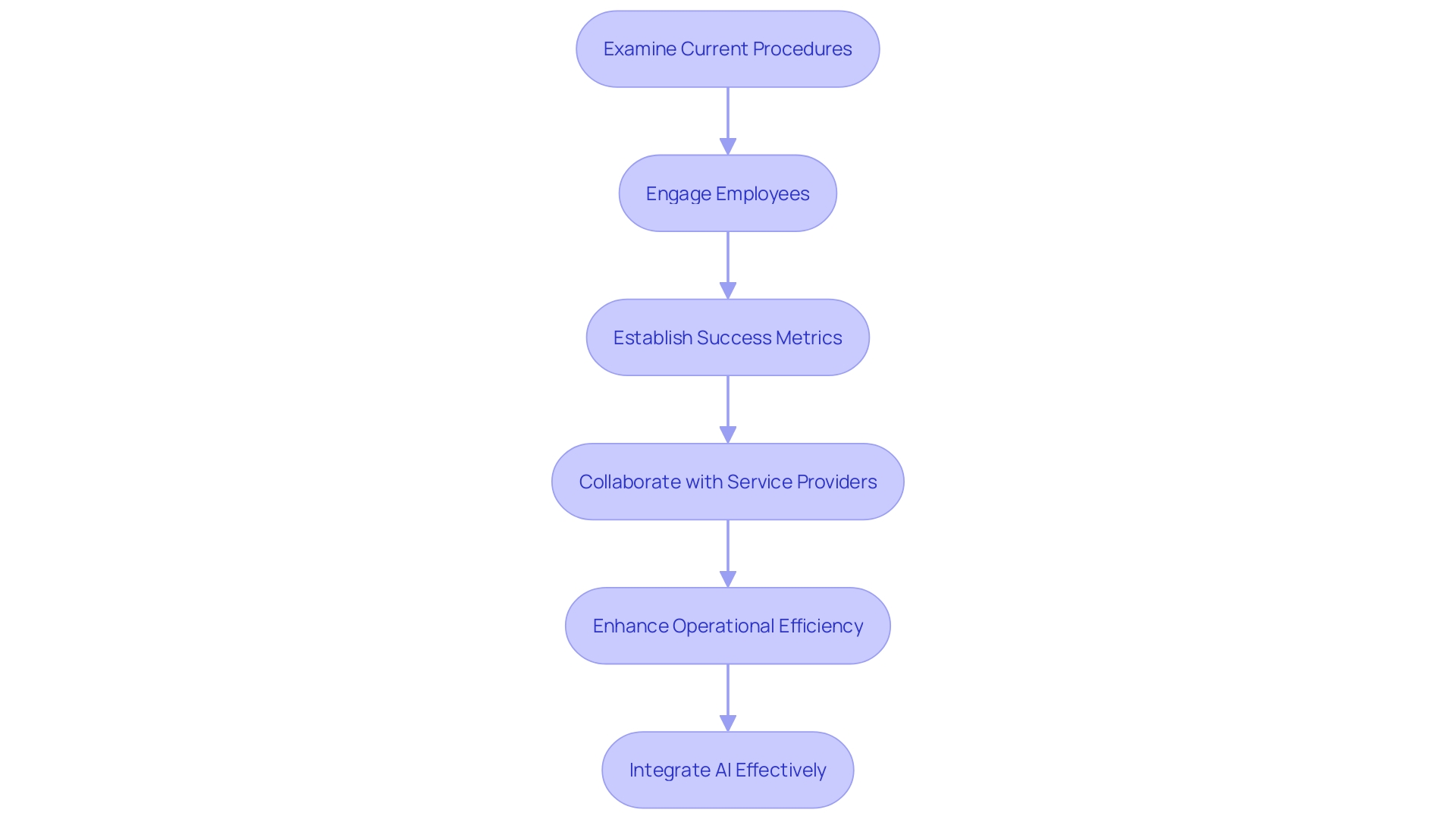
Trends in Banking Automation for 2024
As the financial environment changes, several trends are arising in mechanization for 2024. AI-driven chatbots are increasingly adopted for customer service, offering 24/7 support and handling multiple languages. This technology can manage peak workloads, reducing the need for large customer service teams. For instance, ING’s generative AI chatbot, developed with McKinsey, significantly cuts the number of customer queries requiring live agents.
The emergence of open banking will drive financial organizations toward more cohesive technological solutions, facilitating smooth data exchange and service provisions. Predictive analytics will also become more prevalent, allowing financial institutions to anticipate customer needs and enhance service delivery. Accenture’s analysis indicates that 73% of the time utilized by U.S. financial institution employees could be influenced by generative AI, with 39% by mechanization and 34% by enhancement. This potential spans from the C-suite to front-line services, promising significant productivity improvements.
Regtech, involving tools like AI and blockchain for compliance tasks, will gain prominence due to increasing regulatory complexities. These trends highlight a transformative journey, balancing innovation with responsibility, and setting a stage for a more efficient, customer-centric, and ethical financial future.
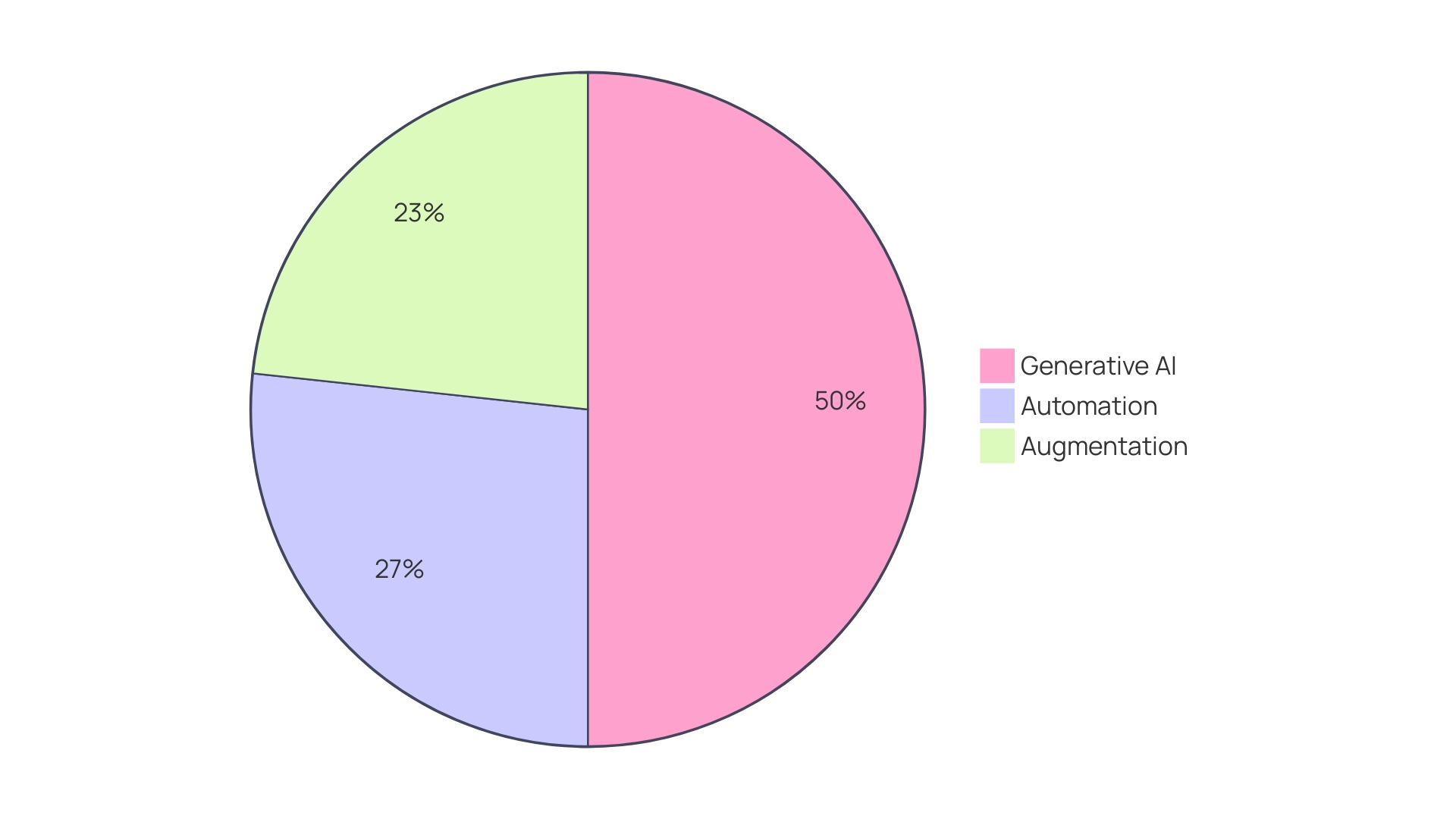
The Role of AI and Gen AI in Banking Automation
Artificial intelligence, especially generative AI, is set to revolutionize financial tasks. With Ai’s ability to analyze vast data sets for actionable insights, and generative Ai’s capacity to generate personalized customer interactions, the potential for innovation is immense. This technology allows financial institutions to automate intricate tasks like risk assessment and fraud detection with unprecedented accuracy. As stated by Accenture, 73% of the time utilized by US financial institution personnel could be affected by generative AI—39% via mechanization and 34% through enhancement, emphasizing its extensive influence across all roles in finance. Ing’s collaboration with McKinsey to develop a sophisticated customer-facing chatbot exemplifies the practical application of generative AI, resolving 40-45% of customer queries in their core market. As financial institutions continue to invest decisively in AI, they stand to gain significant advantages, enhancing efficiency, customer satisfaction, and overall operational productivity.
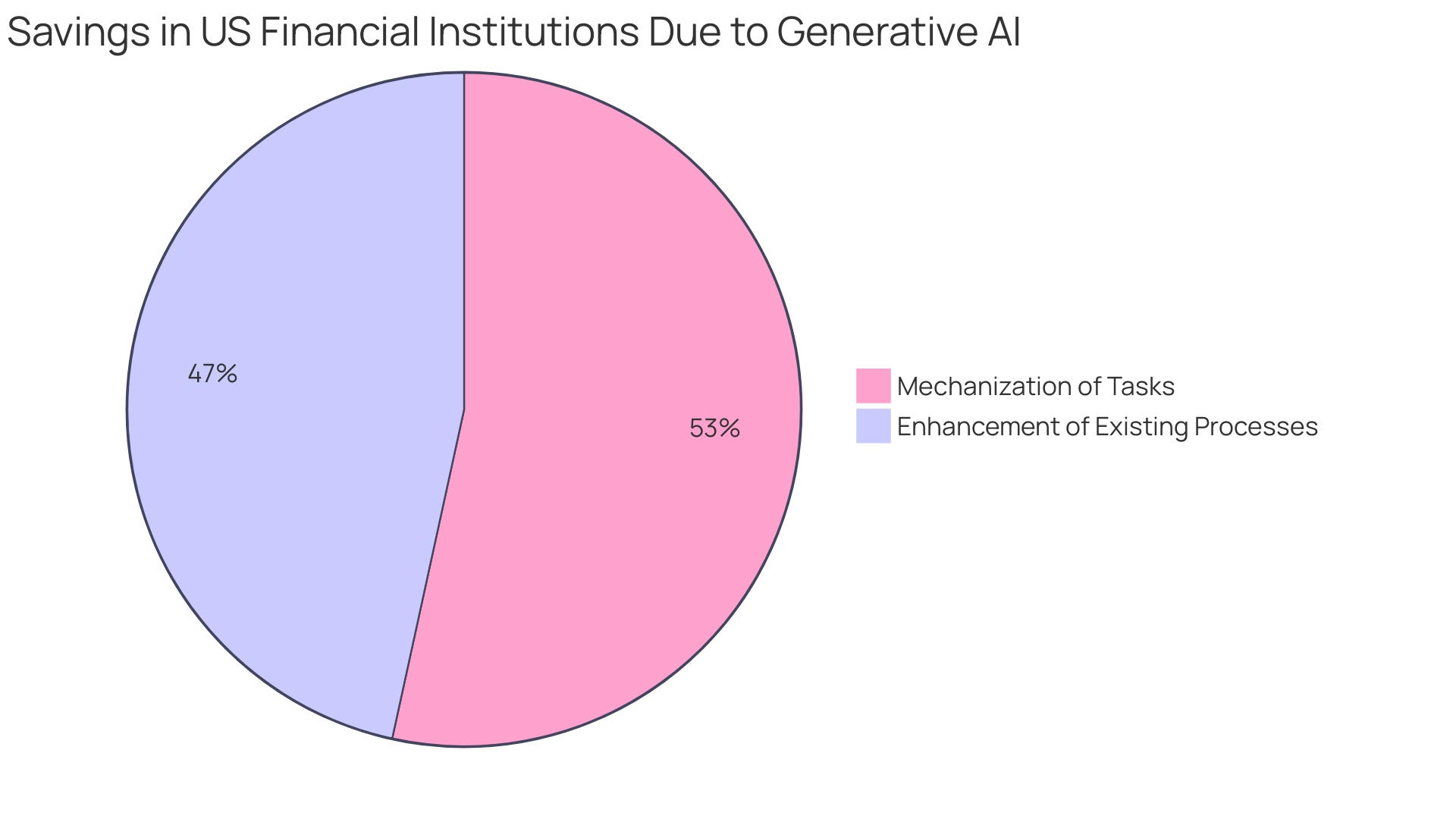
Strategic Insights for Effective Automation
To harness the full potential of mechanization, banks need a strategic vision that aligns with their overarching business goals. This approach is illustrated by TBC Bank, which has successfully transformed its large-scale operations into a flexible, continuous delivery model, thereby enhancing time-to-market for digital products and improving the banking experience for both customers and employees.
Continuous monitoring and iterative improvements are paramount, as evidenced by M&T Bank’s commitment to maintaining high-quality software and compliance standards. Their experience underscores the importance of adapting to technological advancements and market shifts to avoid costly security breaches and operational disruptions.
Moreover, developing a workforce proficient in technologies related to automated processes is essential. This is emphasized by the fact that over 73% of the time utilized by US financial institution employees has high potential for impact through generative AI, with 39% attributed to automation and 34% to augmentation. By fostering a culture of innovation and embracing change, banks can not only streamline operations but also deliver superior wealth management solutions.
A clear example of this can be seen in the increased investment in digital initiatives across the financial sector. Despite the challenges of digital transformation, a set of leading companies have managed to harness digital and AI technologies more effectively, gaining significant competitive advantages. This trend towards comprehensive digital adoption is transforming every aspect of banking, from risk management and operations to HR and customer service, demonstrating the broad benefits of a well-executed automation strategy.
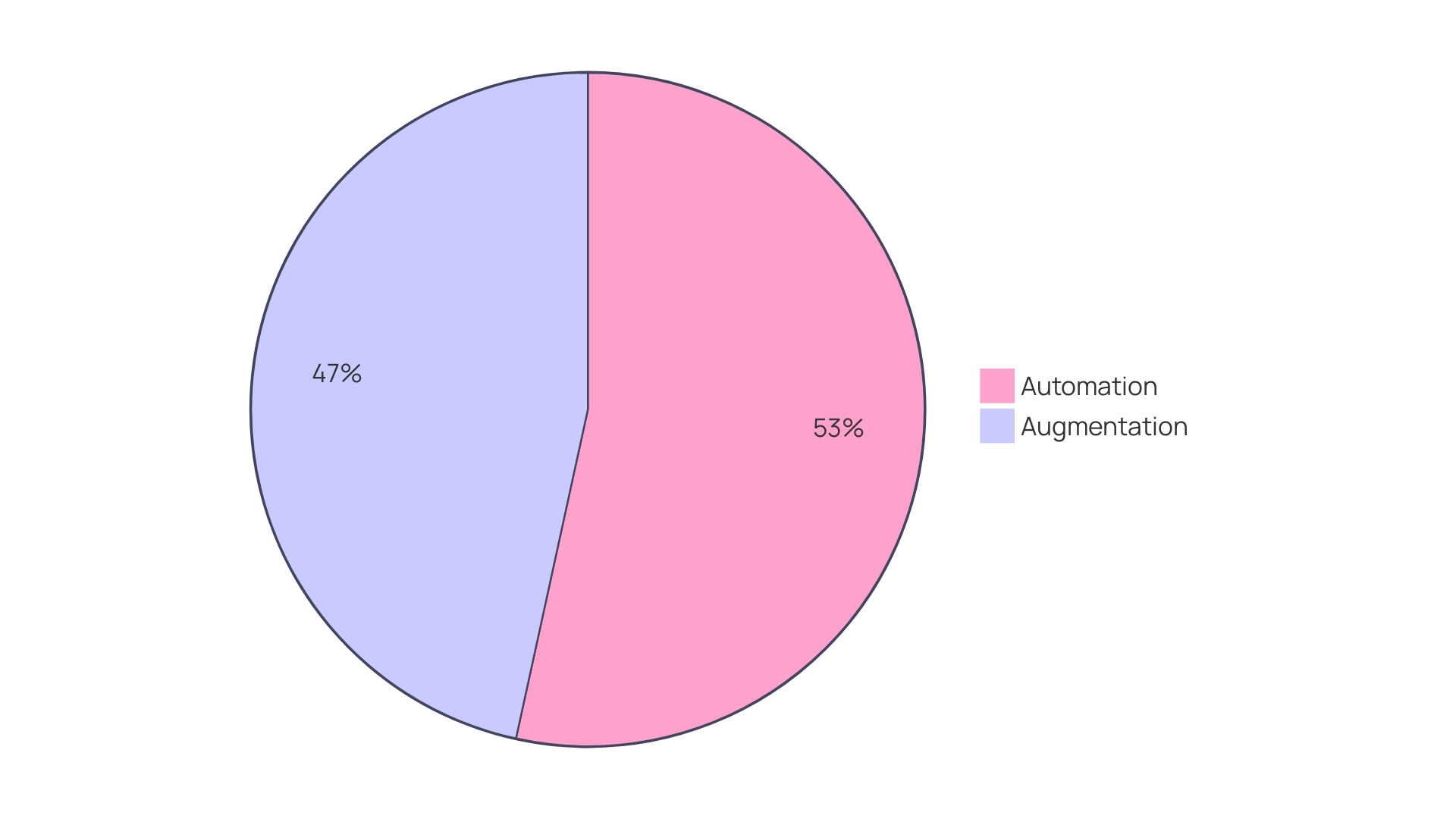
Conclusion
The banking industry’s shift toward automation is driven by the need for greater efficiency, cost reduction, and improved customer experiences. Financial institutions are increasingly leveraging technologies like robotic process automation (RPA) and artificial intelligence (AI) to streamline operations and minimize errors. Success stories from banks such as M&T Bank and Capital One illustrate how digital transformation can enhance compliance and innovation, positioning these institutions competitively.
Automation not only improves operational efficiency but also fosters a culture of innovation and customer-centric services. By reallocating human resources from routine tasks to strategic roles, banks can strengthen customer relationships through personalized services. AI further enhances this by providing valuable insights into customer behavior.
However, challenges like employee resistance, complex integrations, and regulatory compliance must be addressed. A strategic approach that includes thorough process analysis, employee engagement, and partnerships with technology providers is crucial for overcoming these obstacles and maximizing the benefits of automation.
Looking ahead, trends such as AI-driven chatbots, open banking, and regtech will redefine customer interactions and compliance practices. By embracing these innovations and investing in workforce development, banks can navigate the complexities of modern finance, enhance operational efficiency, and deliver exceptional value to customers, paving the way for a more innovative and customer-focused banking future.
Introduction
The banking industry is undergoing a transformative journey, driven by the adoption of automation and artificial intelligence (AI). These advancements are not merely enhancing cost efficiency but are revolutionizing the entire operational framework of financial institutions. From significantly reducing transaction times to minimizing human errors, automation is paving the way for a more reliable and customer-centric banking experience.
Case studies, like that of Arab National Bank, demonstrate the remarkable efficiency gains achievable through digital transformation. Robotic Process Automation (RPA) is streamlining compliance processes, reducing penalties, and fostering a robust regulatory reputation. The integration of AI in fraud detection and risk management further underscores the critical role of these technologies in safeguarding the financial ecosystem.
As the industry looks ahead, the future trends in banking automation, including predictive analytics and sophisticated chatbots, promise to deliver personalized customer experiences and accelerated operational capabilities. By embracing these innovations, banks are not just keeping pace with technology but are setting new standards for efficiency, security, and customer satisfaction.
Benefits of Automation in Banking
The banking sector has undergone a significant change with the incorporation of AI and automated technologies, signaling a new period of productivity and improved service delivery. Beyond mere cost savings, mechanization offers significant advantages such as improved efficiency, where automated processes drastically cut down the time required for transactions and client services. This is further evidenced by SeatGeek’s experience, where AI-powered technology reduced expense management from 20 hours a week to just one hour.
Furthermore, mechanization reduces human mistakes, guaranteeing a more dependable and flawless service. Customer satisfaction has also seen a notable improvement as automation facilitates quicker responses and personalized services tailored precisely to client needs. Banks can now allocate their resources more strategically, focusing on innovation and strategic initiatives rather than mundane and routine tasks.
In the realm of risk management, AI plays a pivotal role by analyzing consumer behavior, market trends, and economic indicators, which helps financial institutions anticipate and manage potential risks more effectively. ‘This technological integration not only enhances operational efficiency but also fortifies the overall security and reliability of financial services.’.
The adoption of AI in fraud detection is particularly noteworthy. AI systems can swiftly process vast amounts of transactions, identifying and mitigating fraudulent activities with remarkable precision. This capability significantly bolsters the security framework within which banks operate, instilling greater trust and reliability in their services.
In essence, the infusion of AI and mechanization in the financial sector is not just about keeping pace with technological advancements; it’s about leveraging these innovations to create a smarter, more efficient, and customer-centric financial environment.
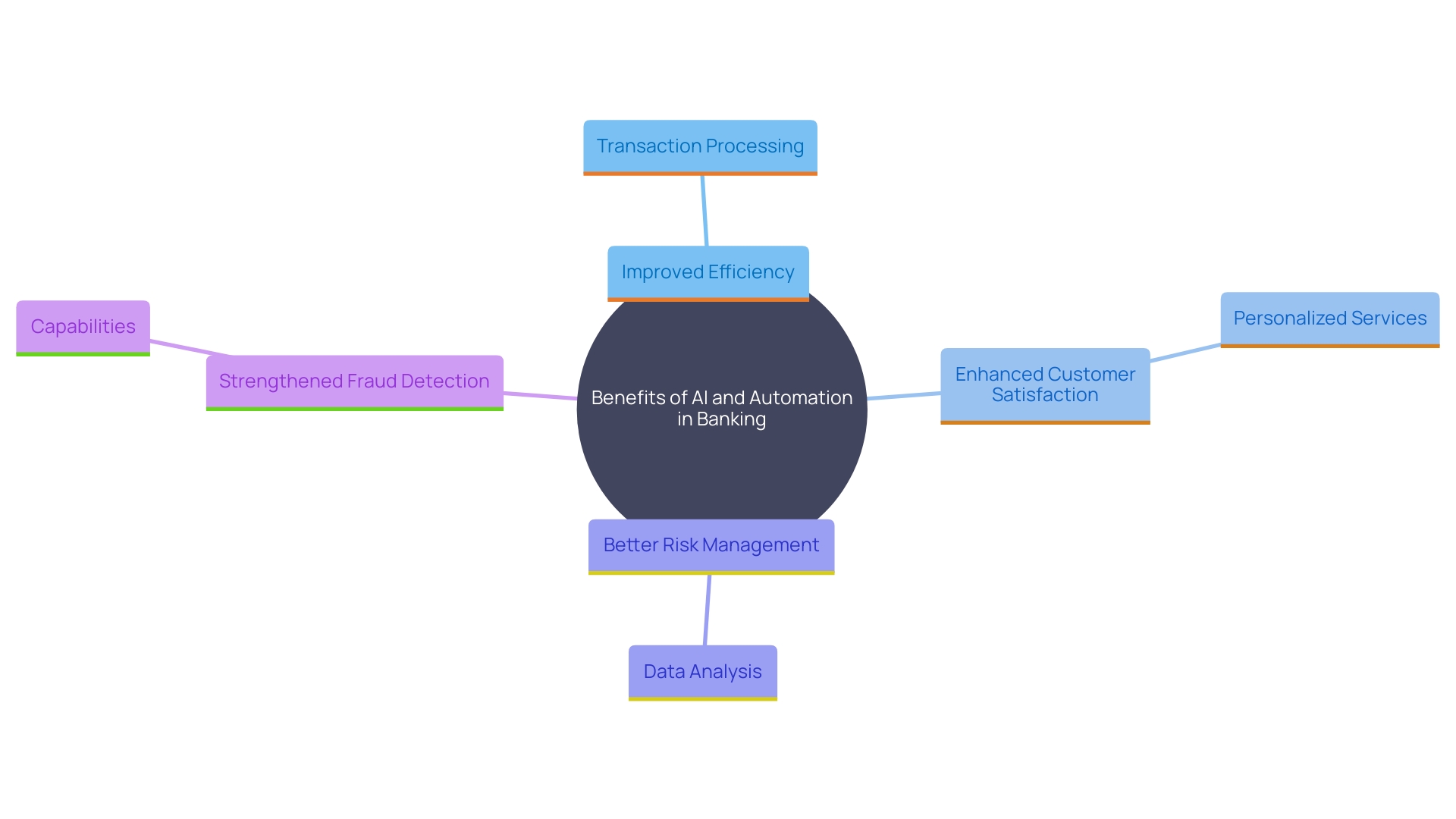
Case Study: Digital Transformation in Finance
Arab National Bank (anb), one of Saudi Arabia’s oldest financial institutions, embarked on an ambitious digital transformation journey to stay ahead in the rapidly evolving banking landscape. By utilizing robotic process systems (RPA) and advanced AI technologies, and reengineered its back-office workflows, significantly enhancing operational efficiency.
The implementation of RPA allowed automated bots to take over repetitive tasks such as data entry and verification, tasks traditionally performed by human employees. This shift resulted in a remarkable 60% reduction in processing times for loan applications, mirroring the success seen by a leading European bank. Moreover, the system reduced processing errors and allowed staff to concentrate on more valuable customer interactions, thus enhancing overall service quality.
This transformation was driven by the need to move away from legacy tools and platforms that had created operational silos and regulatory risks. By embracing modern digital technologies, and not only optimized its operations but also set a new standard for innovation and customer service in the financial sector.
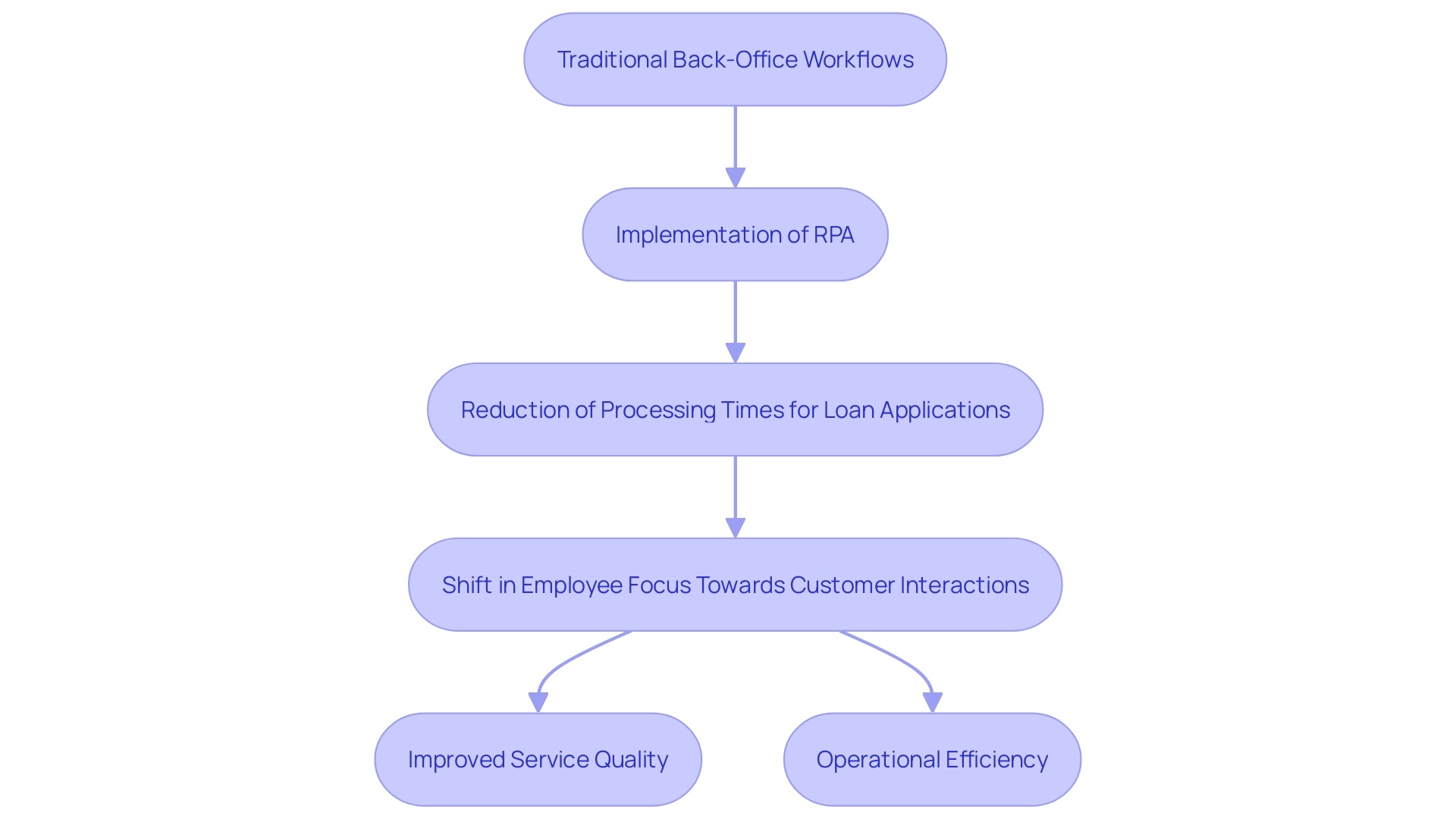
RPA Innovations in Banking
Robotic Process Automation (RPA) has revolutionized operational efficiency in the banking sector. By adopting RPA, a prominent financial institution was able to streamline its compliance processes significantly. ‘The mechanization of data collection and reporting for regulatory compliance not only ensured precision but also drastically reduced the time previously spent on manual tasks.’. This enhancement led to a notable decrease in compliance-related penalties and bolstered the bank’s reputation among regulators.
To put this into perspective, automated processes can be likened to the strategic craftsmanship of creating a suit that enhances efficiency and aligns with core operational needs. ‘The potential financial worth obtained from such mechanization is considerable, especially when comparing the time needed for manual completion of tasks versus automated processes.’. This approach provides a holistic view of operational maturity and readiness, enabling institutions to identify areas for improvement and trends over time.
Moreover, by utilizing technologies such as AI-driven systems, banks can confront the primary difficulties of implementing and incorporating new solutions with their current data framework, while also addressing data security and privacy issues. For instance, Temenos Generative AI solutions have demonstrated how transparency and explainability in AI can enable users and regulators to validate results, thereby changing effectiveness in banking operations.
In today’s ever-changing business environment, mechanization is not merely an instrument but an essential element that provides enhanced productivity by removing manual and repetitive duties. As stakeholders navigate through complex regulatory requirements and market dynamics, targeted automation proves to be a safeguard, reducing risks and maximizing operational integrity.
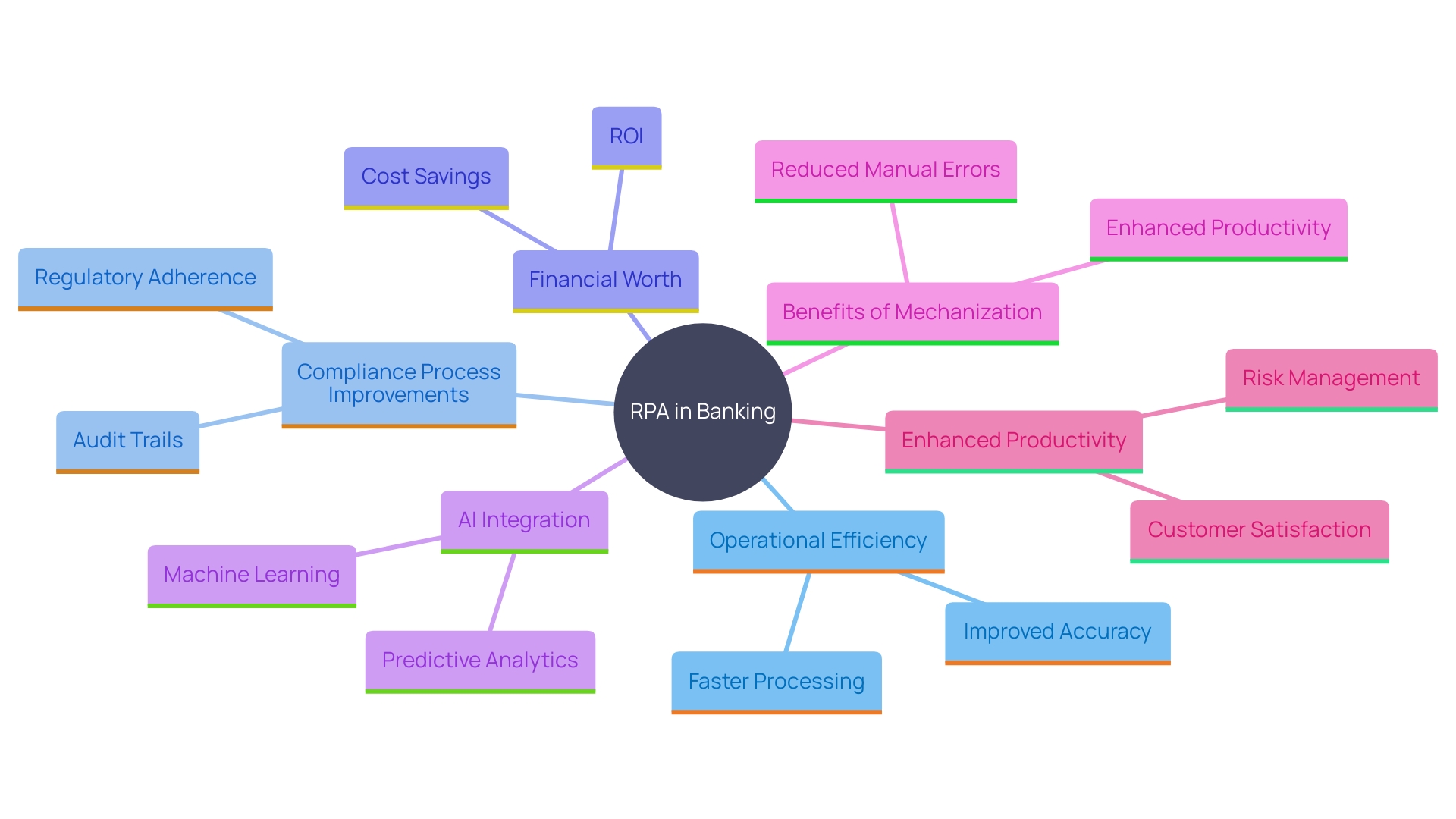
Use Cases of Automation in Banking
Automation in banking has revolutionized various processes, driving efficiency and improving customer experience. A standout example is the transformation of customer onboarding through automated identity verification systems. Leveraging machine learning algorithms, these systems swiftly analyze documents and verify client identities, streamlining the onboarding experience. In the realm of fraud detection, AI-driven systems oversee transactions in real-time to identify and flag suspicious activities, enabling financial institutions to respond proactively to potential threats.
Moreover, AI has significantly enhanced risk management by examining consumer behavior, market trends, and economic indicators, enabling banks to anticipate and mitigate risks effectively. The McKinsey report highlights the profound impact of AI in financial services, projecting a potential increase in productivity of 2.8% to 4.7% of the industry’s annual revenues, equivalent to an additional $200 billion to $340 billion. This transformation is not just limited to operational efficiency but extends to customer satisfaction and decision-making, ultimately safeguarding the financial ecosystem against fraud and other risks.
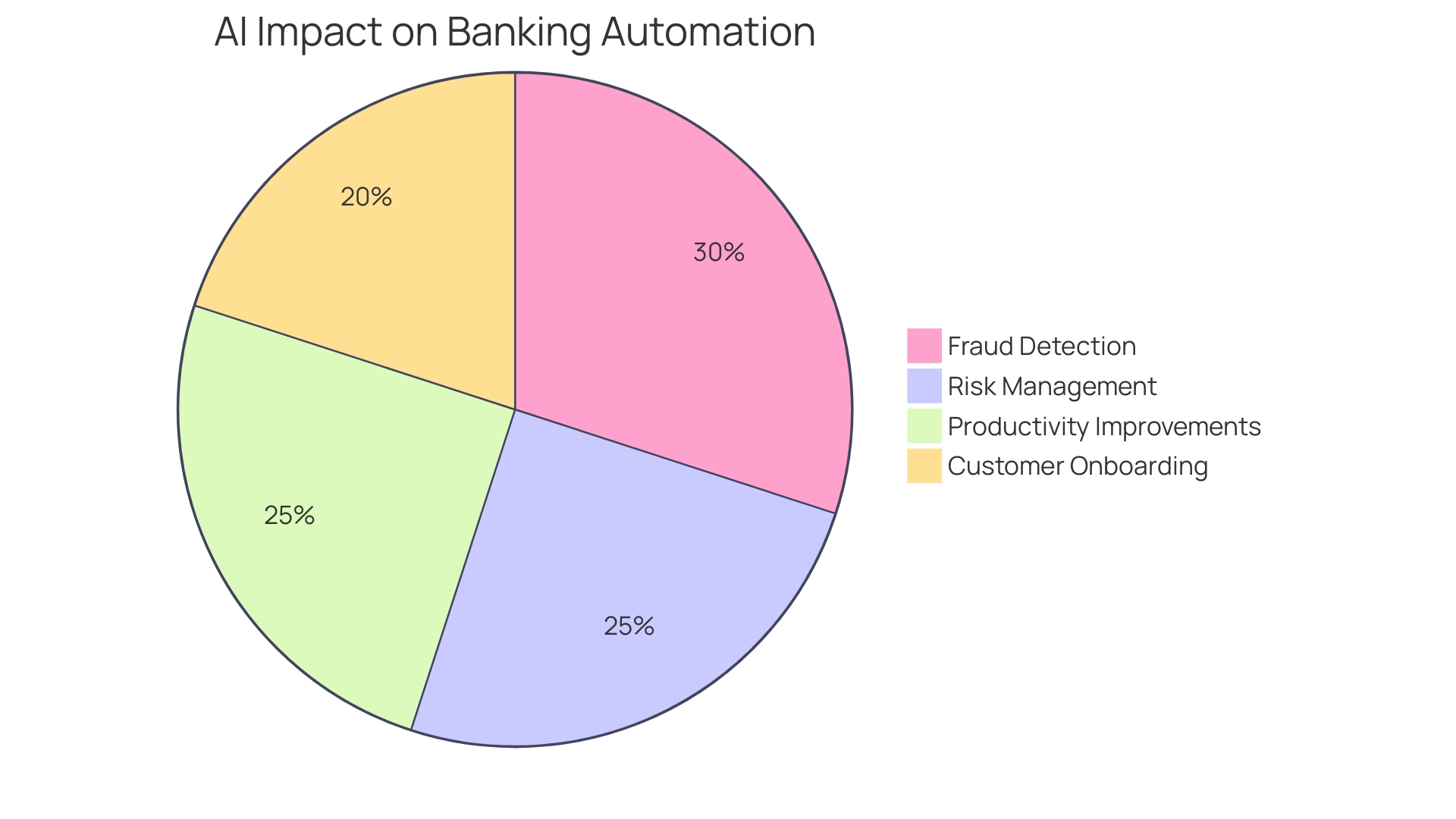
Future Trends in Banking Automation
The future of financial automation is set to revolutionize the industry through advancements in AI and machine learning. Predictive analytics will play a crucial role in personalizing customer experiences by allowing banks to anticipate needs and offer tailored solutions. This evolution is supported by Ai’s ability to analyze vast amounts of data to provide real-time financial advice and product recommendations precisely when customers need them.
Moreover, the integration of sophisticated chatbots for customer service will enable seamless and efficient interactions, significantly improving customer satisfaction. This technological shift is already evident, as AI systems have enhanced financial risk management by examining consumer behavior, market trends, and economic indicators to anticipate and manage risks effectively.
‘A notable case highlights how a financial group created a common data model and an analytical abstraction layer, enabling rapid deployment of use cases across multiple countries.’. This innovation shortened the timeline for implementing new analytics solutions from five months to six weeks, demonstrating AI’s potential to speed up financial operations.
Responsible AI deployment is essential to ensure fair, unbiased, and explainable models that stakeholders can easily understand and trust. As financial institutions continue to invest in these technologies, their focus will shift towards creating a more agile and responsive financial environment. This evolution promises enhanced operational efficiency and a superior customer experience, ultimately positioning banks to thrive in an increasingly digital world.
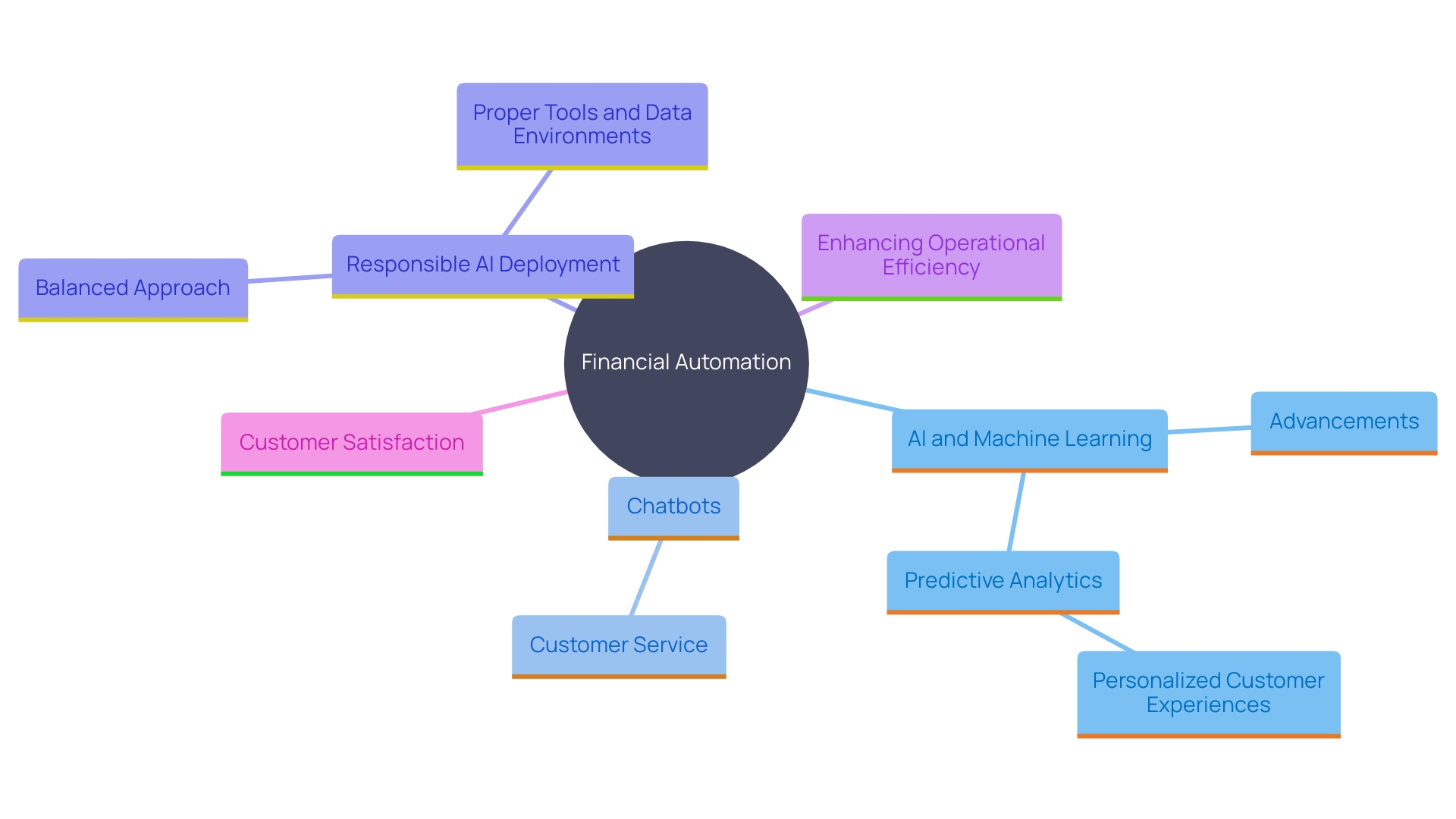
Conclusion
The integration of automation and AI within the banking sector is not merely a trend but a transformative movement reshaping the industry. Key benefits include enhanced operational efficiency, improved customer satisfaction, and a fortified security framework. By streamlining processes, banks can significantly reduce transaction times and human errors, leading to a more reliable service.
The case study of Arab National Bank exemplifies how digital transformation can optimize operations and elevate customer interactions, setting new benchmarks for the industry.
Robotic Process Automation (RPA) has emerged as a game-changer, particularly in compliance and risk management. Its ability to automate repetitive tasks not only minimizes processing times but also enhances accuracy, thereby reducing compliance-related penalties. As banks embrace these innovations, they are not just adapting to change but actively driving it, ensuring that they remain competitive in a rapidly evolving landscape.
Looking ahead, the future of banking automation promises further advancements with predictive analytics and sophisticated AI systems. These technologies will enable banks to deliver personalized services and proactive risk management, ultimately enhancing the customer experience. By prioritizing responsible AI deployment, financial institutions can ensure that their transformations are not only efficient but also ethical and trustworthy.
The journey towards a more agile and customer-centric banking environment is underway, positioning the industry for continued success in the digital age.
Introduction
Navigating the complexities of modern marketing demands innovative tools that streamline and enhance campaign effectiveness. Enter the Call-to-Action (CTA) Generator—a game-changer for marketers striving to craft compelling CTAs that resonate with their target audience and drive conversions. These advanced tools harness sophisticated algorithms and customizable templates to simplify the creation process, ensuring that every CTA is aligned with business objectives and audience needs.
In industries like healthcare, where precision and timely communication are paramount, CTA generators transform specialized knowledge into actionable content swiftly and efficiently. This capability ensures that marketing teams can maintain consistent, persuasive messaging throughout the sales process, ultimately boosting engagement and conversion rates.
The importance of optimizing marketing efforts cannot be overstated, as clear communication and strategic storytelling are essential for connecting with audiences. With mobile search on the rise, businesses have a significant opportunity to capture local customers through CTAs designed for mobile platforms. By incorporating CTA generators into their marketing strategies, businesses can navigate the intricacies of the digital landscape, optimize their marketing spend, and achieve sustainable growth.
What is a Call-to-Action Generator?
A Call-to-Action (CTA) Generator is an indispensable tool for marketers aiming to craft compelling and effective calls-to-action for their campaigns. Leveraging advanced algorithms and templates, these generators simplify the creation of CTAs, ensuring alignment with both the target audience and overarching business goals. By streamlining the design and wording process, these tools significantly enhance engagement and conversion rates.
In the healthcare sector, for example, where timely and precise communication is crucial, a CTA generator can swiftly produce content that addresses the nuanced needs of various stakeholders. It converts complex industry-specific expertise into practical material, facilitating the ability of teams to launch successful campaigns. This rapid content creation is critical, as it enables timely engagement with prospective decision-makers, ensuring that the messaging remains consistent and persuasive throughout the sales process.
Furthermore, grasping the return on investment (ROI) of your promotional efforts is essential. With the right tools, businesses can optimize their marketing spend, generate steady leads, and close deals more efficiently. As emphasized by industry experts, clear communication and storytelling are essential in engaging with the viewers and driving conversions.
The statistics underscore the importance of mobile-friendly design, with 57% of local searches conducted on mobile devices and tablets. This indicates a significant opportunity for businesses to capture local customers through well-crafted CTAs optimized for mobile platforms.
Ultimately, CTA generators empower marketers to create tailored, on-point content that resonates with their audience, driving higher engagement and conversion rates. By incorporating these tools into their promotional technology framework, businesses can better navigate the complexities of contemporary advertising and achieve sustainable growth.
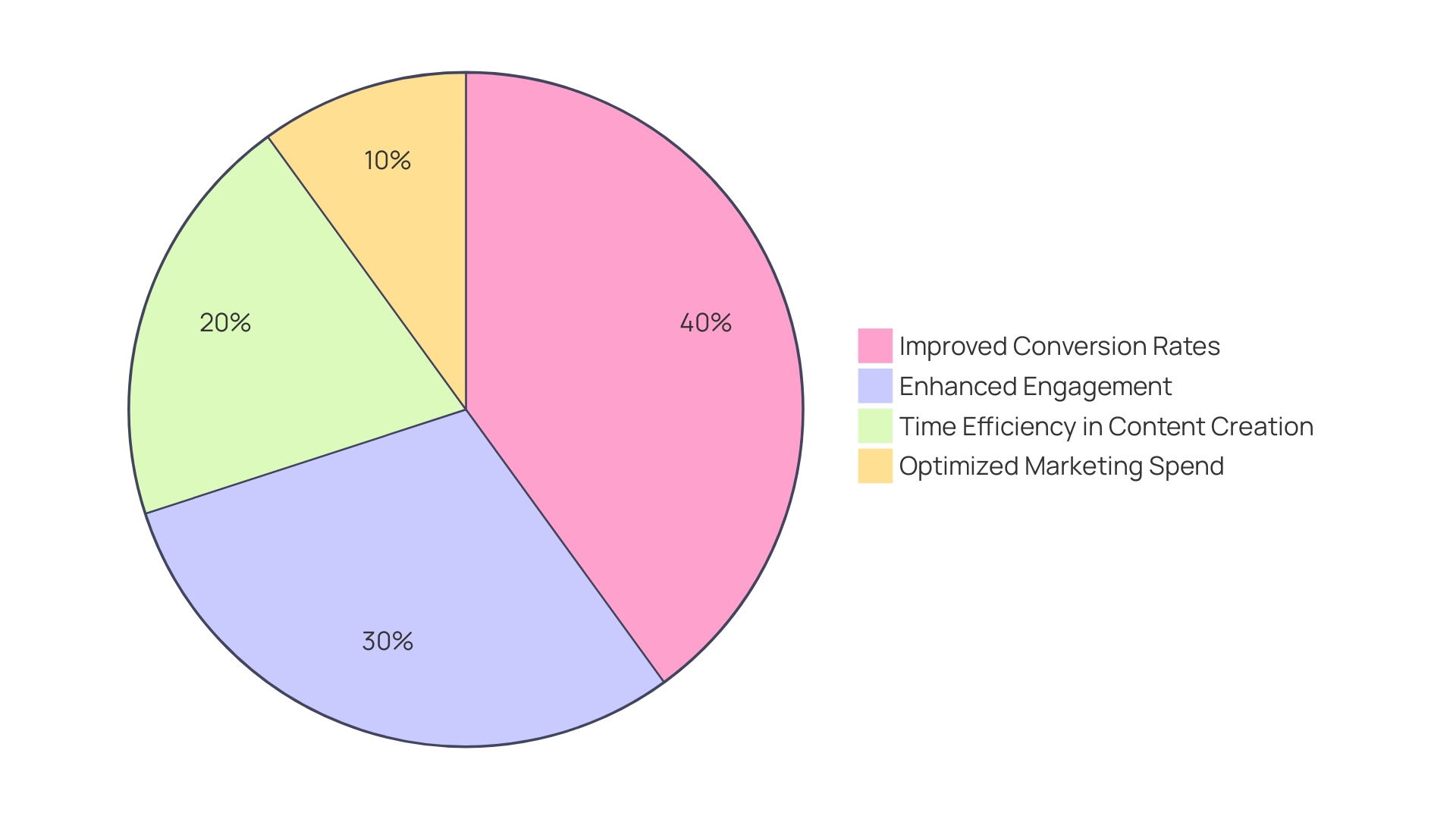
Benefits of Using a Call-to-Action Generator
Leveraging a Call-to-Action (CTA) Generator can significantly enhance marketing efforts, providing multiple key benefits. First and foremost, it streamlines the creation process by automating the design of engaging calls to action, allowing marketers to invest more time in strategic planning. This automation is essential given the intricate craft involved in writing effective calls to action, which blend both art and science to prompt readers to take the desired action.
Furthermore, a CTA Generator improves the efficiency of promotional campaigns through data-informed recommendations customized for particular demographic groups. As Jeff Bradford, a thought leader in marketing, emphasizes, understanding and leveraging data can create meaningful connections with your target group, making your calls to action more impactful. This ability to fine-tune calls to action based on audience behavior is crucial in today’s competitive landscape where personalized communication can significantly drive engagement.
Additionally, the inclusion of A/B testing features within these tools allows marketers to refine their approaches based on real-time performance data. This iterative process of testing and optimizing ensures that the calls to action are not only compelling but also yield the highest possible conversion rates. According to recent insights, businesses that systematically test and optimize their calls to action see a marked improvement in their overall conversion rates, directly impacting revenue growth.
Incorporating these features into marketing strategies offers a clear pathway to improving ROI. By automating the creation of calls to action, making data-informed adjustments, and continuously refining through A/B testing, marketers can achieve a more efficient and effective approach to driving customer actions.
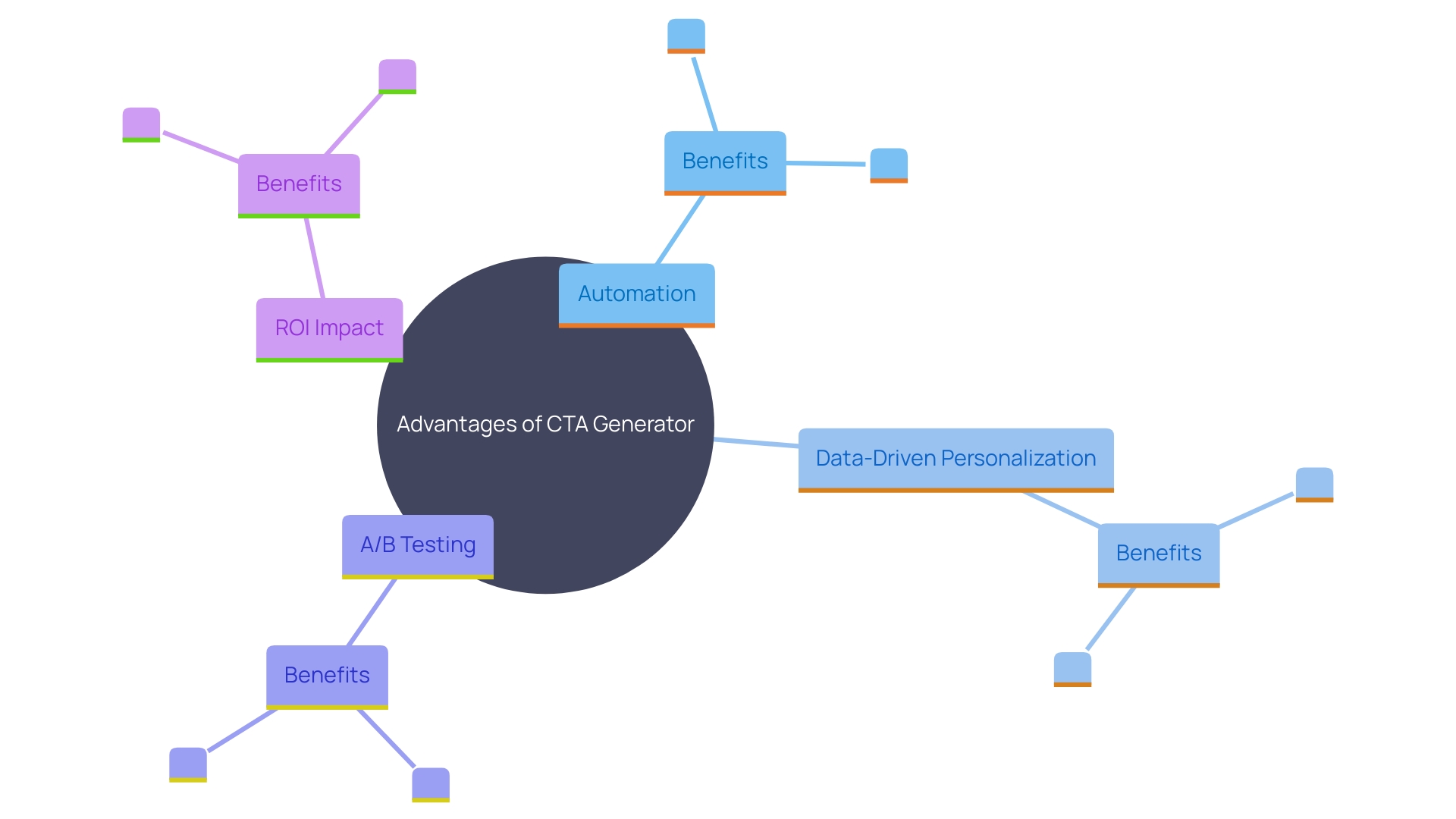
Key Features of Effective Call-to-Action Generators
Effective Call-to-Action (CTA) Generators come equipped with a suite of advanced features designed to enhance their usability and impact. Among these are customizable templates and intuitive drag-and-drop design interfaces, enabling marketers to craft compelling CTAs with ease. Integration capabilities with other promotional tools ensure a seamless workflow, allowing for a cohesive approach across multiple platforms.
Furthermore, these generators often include comprehensive analytics dashboards that provide real-time data on CTA performance, offering valuable insights into click-through rates and conversion metrics. ‘According to a survey of industry leaders, implementing AI in these tools has become both a top priority and a significant challenge, underscoring the importance of data-driven decision-making in today’s business landscape.’.
Jeff Bradford, a celebrated visionary in promotion, highlights the influence of narrative in establishing significant connections with listeners. This principle can be directly applied to CTA design, where authentic and engaging messages can significantly boost user interaction. Furthermore, David Apple, Chief Marketing Officer of Intuitive Health, emphasizes the significance of clear communication and authenticity, which are vital in creating calls to action that connect with target audiences.
Utilizing these advanced attributes and insights, marketers can refine their calls to action to increase engagement and conversion rates, ultimately improving their overall marketing effectiveness.
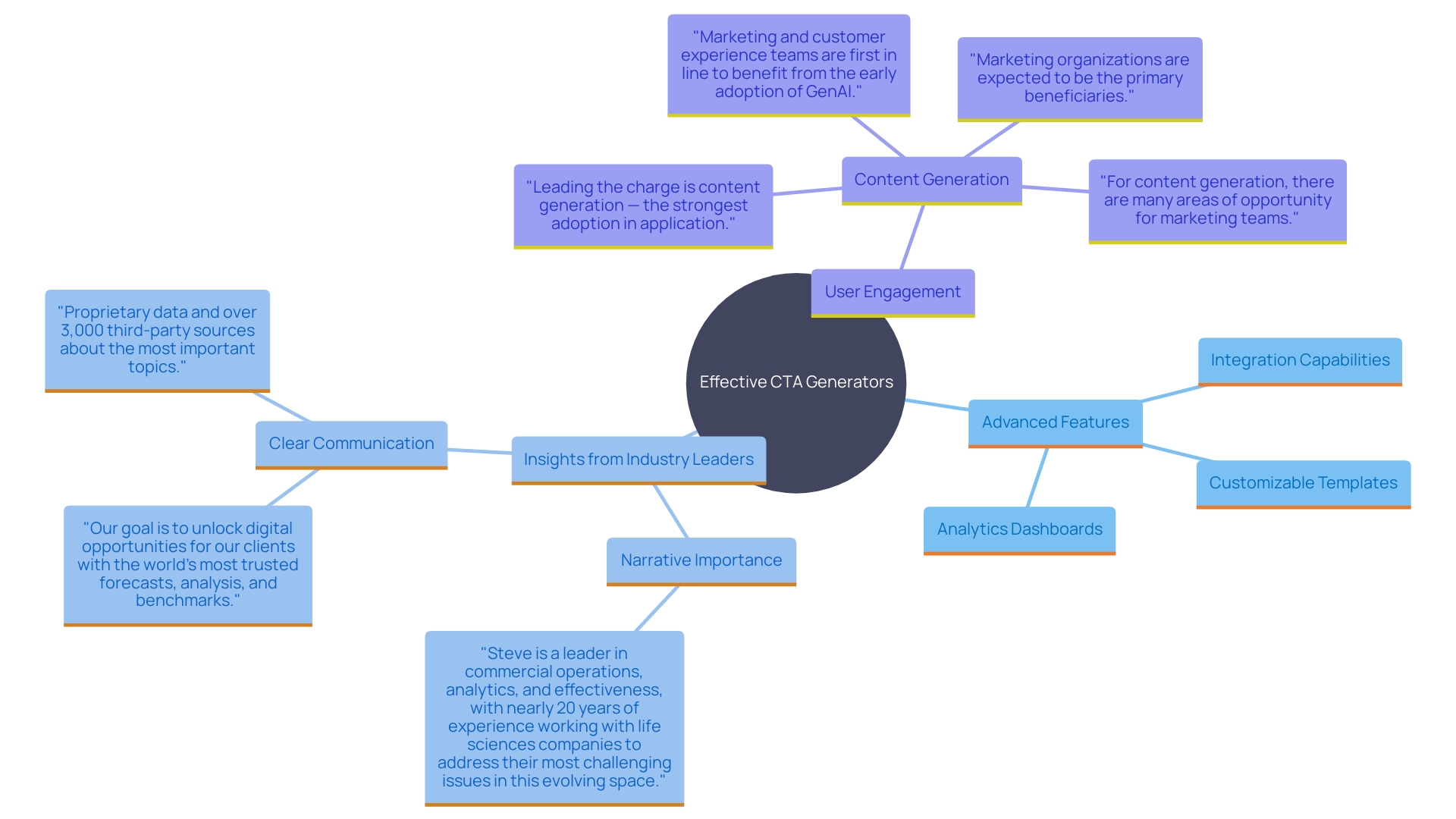
Common Mistakes to Avoid in Call-to-Action Creation
Marketers often encounter several pitfalls when designing effective calls to action. A common error is using unclear or uninspiring language, which fails to prompt user action. Ensuring that calls to action are mobile-optimized is essential, as a substantial number of users access content through mobile devices. Another common error is overloading calls to action with too much information, which can overwhelm potential customers and result in decision paralysis. As emphasized by industry specialists, comprehending your audience and customizing your calls to action accordingly can greatly enhance engagement. For instance, a well-crafted CTA that clearly explains who you are, what your product does, and its relevance to the content can be highly effective. This approach is not only explicit and transparent but also noninvasive, making it memorable for users who find the topic important. Steering clear of these typical errors is essential for improving the influence and efficiency of your calls to action.

Best Practices for Call-to-Action Placement and Design
Effectively placing and designing calls to action is crucial for maximizing user engagement and driving desired actions. Positioning calls to action in high-visibility areas, such as above the fold or at the end of blog posts, ensures they catch the user’s eye. The design should be simple yet striking, employing contrasting colors to grab attention. Statistically, effective calls to action can significantly boost conversion rates, as highlighted by various industry experts. For instance, the use of clear, action-oriented wording that conveys urgency can prompt immediate responses from users. This approach aligns with the EASY framework‘s principle of making content Expert, Actionable, Simple, and Yours, as emphasized by content marketing professionals.
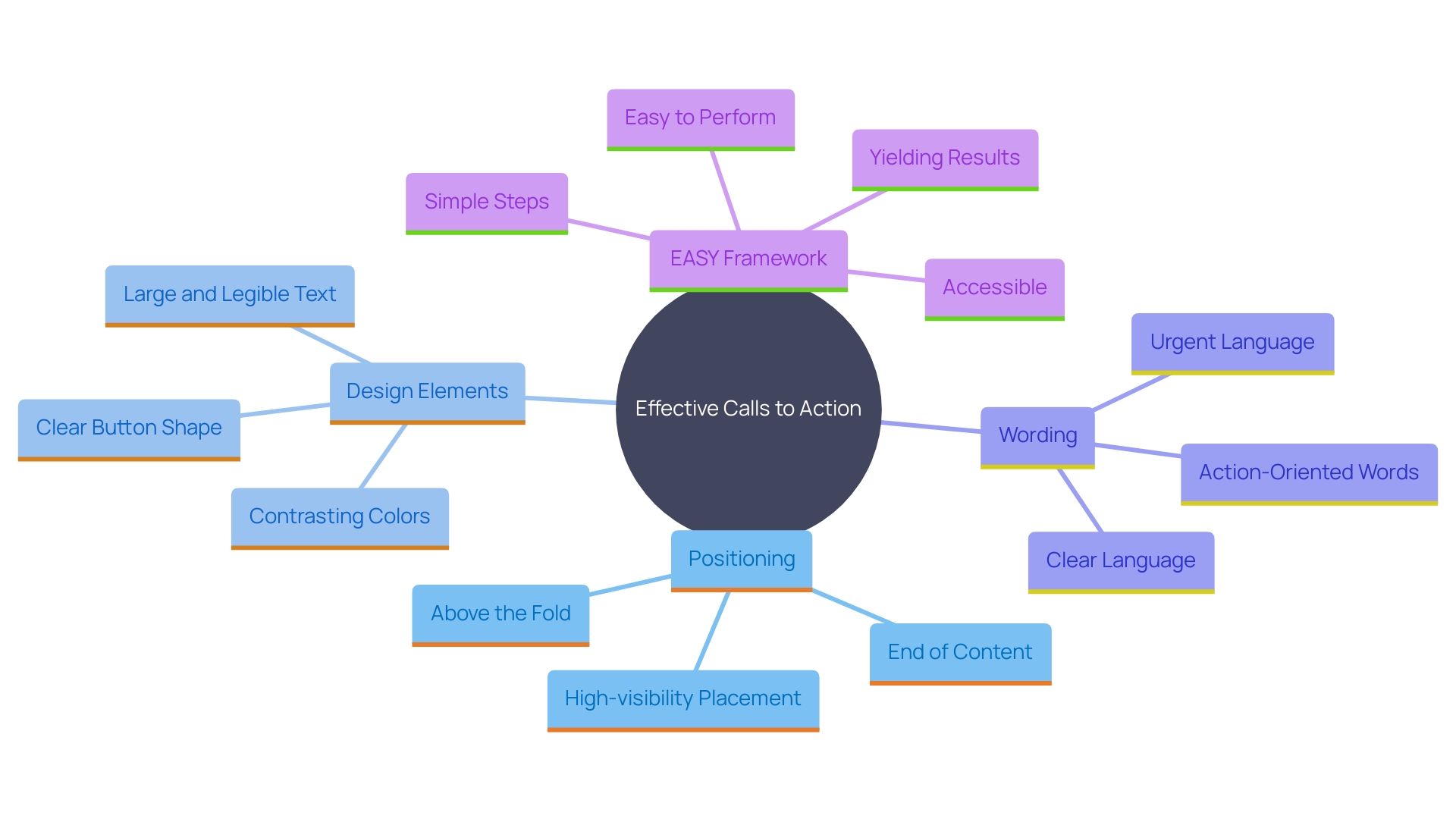
Measuring the Success of Calls to Action
To assess the effectiveness of calls to action, marketers should implement robust measurement strategies to track performance metrics. Key indicators to monitor include click-through rates, conversion rates, and user engagement levels. According to Amplitude’s industry benchmarks, these metrics are crucial in understanding digital behavior and optimizing campaigns. Employing A/B testing can further offer insights into which calls to action resonate best with the group. Jeff Smith, a seasoned expert in promotion, emphasizes that “the purpose of these pages (and forms) is to get your audience to take a specific action… Without these clicks, you can’t generate revenue.” By continually analyzing these metrics, marketers can refine their strategies, ensuring their CTAs drive the desired outcomes. Real-world case studies have shown that data-driven strategies empower more effective resource allocation and marketing efforts, bridging the gap between data science and business decision-making. This approach not only enhances operational efficiencies but also positions companies to thrive in a competitive landscape.
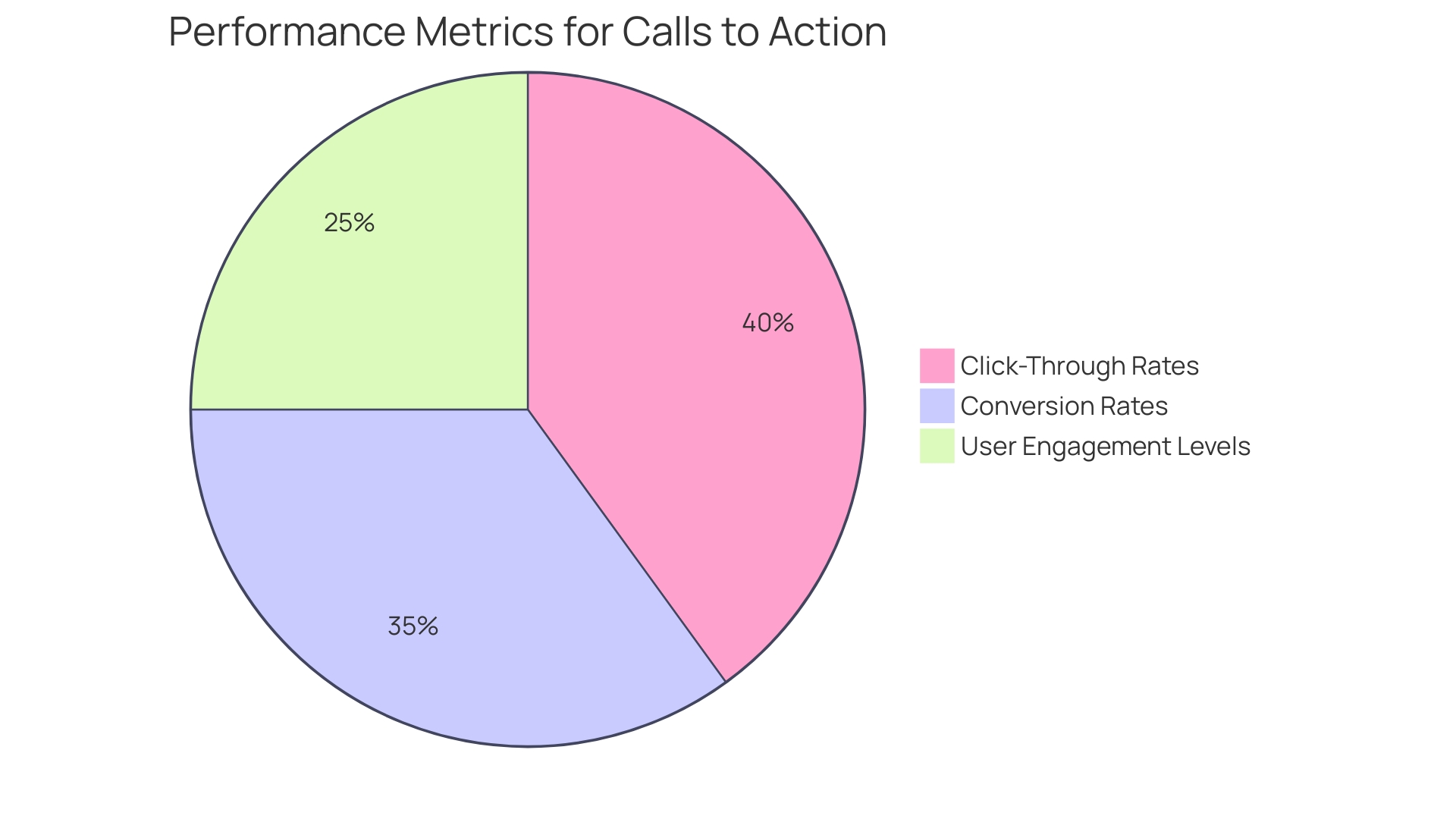
Conclusion
The integration of Call-to-Action (CTA) Generators into marketing strategies presents a transformative opportunity for businesses seeking to enhance engagement and drive conversions. By leveraging advanced algorithms and customizable templates, these tools simplify the creation of compelling CTAs that resonate with target audiences and align with business objectives. In sectors like healthcare, where precise communication is vital, CTA generators facilitate timely and effective messaging, ensuring that marketing efforts are both consistent and persuasive.
Utilizing a CTA Generator not only streamlines the creation process but also allows for data-driven adjustments that cater to specific audience segments. This personalized approach enhances the impact of marketing campaigns, leading to improved engagement and conversion rates. The inclusion of A/B testing features further empowers marketers to refine their strategies based on real-time performance data, maximizing return on investment and driving revenue growth.
However, it is essential to avoid common pitfalls in CTA creation, such as unclear language or cluttered designs. Best practices for placement and design, including strategic positioning and eye-catching aesthetics, can significantly boost user interaction. By measuring the success of CTAs through key performance metrics, marketers can continuously optimize their efforts, ensuring that every message prompts the desired action.
Incorporating CTA generators into the marketing toolkit not only simplifies the campaign creation process but also enhances operational efficiency. By adopting these innovative tools and strategies, businesses can effectively navigate the complexities of modern marketing, achieving sustainable growth and stronger connections with their audiences.
Introduction
In an increasingly data-driven world, the efficiency of operations hinges on the ability to manage and process information swiftly and accurately. Automated form processing stands at the forefront of this transformation, offering organizations a way to shift from manual, error-prone data entry to a streamlined, reliable system. By reallocating resources from routine tasks to strategic functions, businesses can boost productivity and foster innovation.
With industries like finance demonstrating the potential to automate up to 80% of operations, the impact is profound. The integration of AI into form automation further amplifies these benefits, ensuring compliance, reducing turnaround times, and enhancing decision-making. Real-world applications, from healthcare to financial services, showcase the tangible improvements in operational efficiency and accuracy, underscoring the importance of embracing these advanced technologies.
As businesses integrate automated forms into existing workflows, the promise of a more unified, productive, and compliant operational framework becomes a reality, paving the way for sustained growth and success.
Benefits of Automated Form Processing
Automated form processing alters information collection and management by significantly reducing the time and effort linked with manual entry. This reallocation of resources from repetitive tasks to more strategic functions not only boosts productivity but also empowers teams to engage in higher-value activities that foster innovation and growth. As stated by Rob Lawrence, Chief Operating Officer of Formstack, the incorporation of automated tools can enhance information management, enabling organizations to gather and use information more efficiently. Furthermore, the use of technology improves data precision and dependability by minimizing the chance of human mistakes, an essential element in preserving the integrity of information. This change is especially clear in sectors such as finance, where, as highlighted by Accenture, up to 80% of processes have the capacity for mechanization, allowing staff to concentrate on strategic initiatives. By embracing these advanced technologies, organizations can achieve a more efficient, accurate, and innovative operational framework.
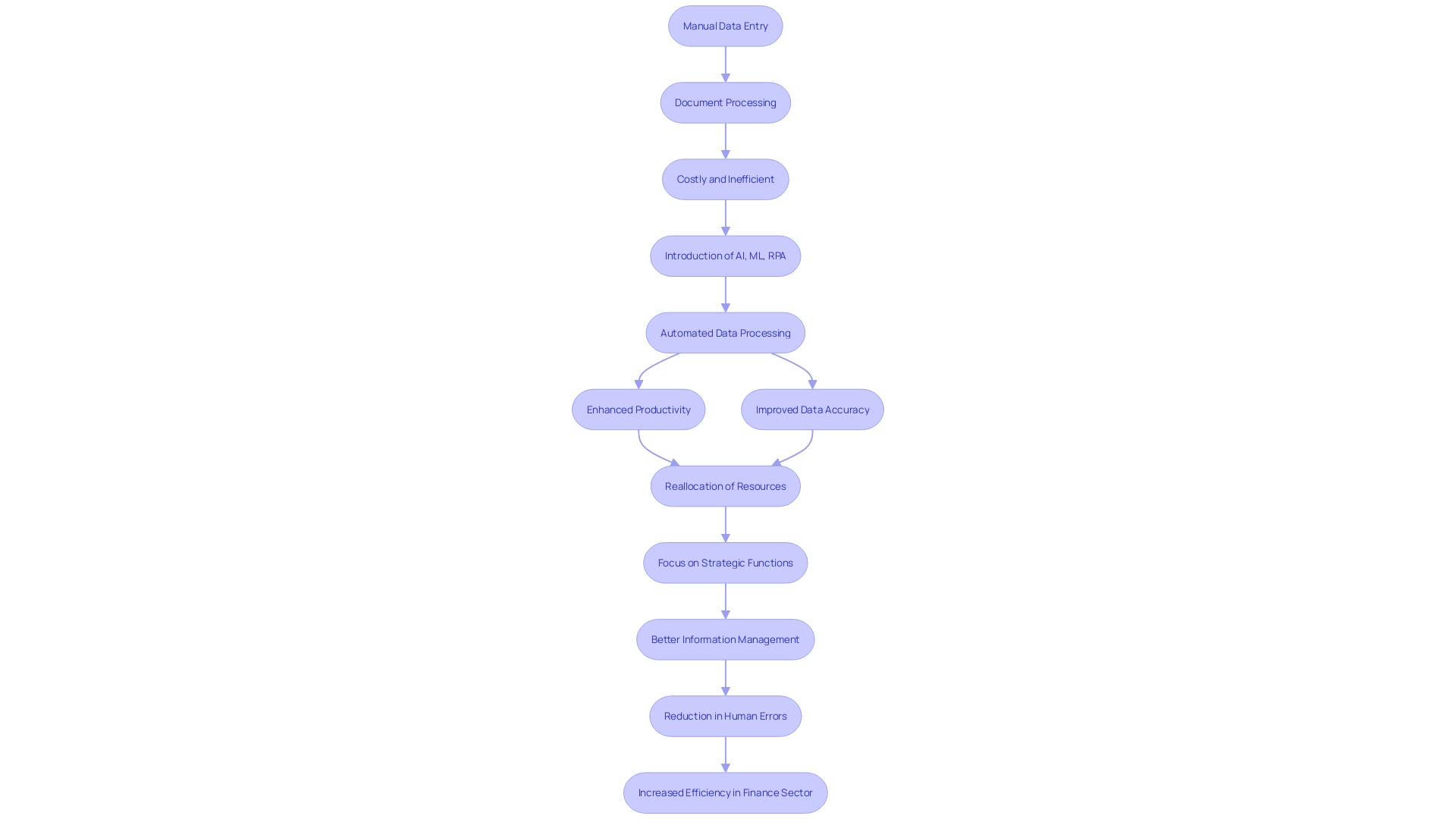
Key Advantages of Form Automation
Form mechanization provides numerous advantages, including increased efficiency and shorter turnaround times. Automated systems manage documents instantly, facilitating quicker decision-making and faster service delivery. Furthermore, mechanization strengthens adherence by making certain documents are precisely filled out and conform to regulatory standards, thus reducing the chance of fines or legal complications.
The incorporation of AI into form processing further enhances these advantages. In contrast to conventional mechanization, which functions on a straightforward cause-and-effect system, AI can understand intricate inputs. For example, rather than just responding to a ‘yes’ or ‘no,’ AI can analyze entire paragraphs to determine intent, making it highly effective in processing unstructured or random inputs.
The movement towards AI and mechanization is not merely a trend but a strategic priority for many companies. According to Forbes, 83% of companies consider AI crucial for their operations. This transition is supported by advancements in no-code AI platforms, which allow businesses to become data-driven without the need for extensive data science teams.
Practical uses illustrate the concrete advantages of mechanization. For instance, the use of PDFfiller in sectors requiring extensive documentation, such as medical, insurance, and banking, showcases how technology tools can simplify daily tasks and improve operational efficiency.
As technology keeps advancing, the importance of mechanization in business operations will only grow, providing a strong method to improve efficiency and adherence.
Integrating Automated Forms with Existing Workflows
Integrating automated forms into existing workflows seamlessly is essential to harness their full potential. Employing APIs and middleware options can link automated tools with existing systems, ensuring seamless data transfer between applications. This approach promotes a unified process management system, breaking down silos and significantly boosting overall operational efficiency. For instance, Nanonets provides strong options that automate the handling of invoices, bills, and receipts, saving countless hours for the workforce. By selecting an appropriate AI model and setting up an auto-import option, organizations can streamline document processing, whether from email inboxes, cloud storage, or physical scanners.
A practical illustration of effective integration is Automation Anywhere’s success in improving business operations through AI-driven systems. Their GenAI-powered solutions have contributed to 30% of bookings, reflecting an increasing customer preference for merging AI and automated technologies to address complex challenges. This success underscores the importance of using advanced tools to achieve seamless integration and improved productivity.
Moreover, incorporating automation tools can assist organizations in remaining compliant with growing privacy regulations, such as GDPR and CCPA. TikTok’s €345 million fine and Sephora’s $1.2 million settlement highlight the costly consequences of non-compliance. Automated systems can efficiently track, manage, and audit consumer information requests, ensuring adherence to legal requirements and safeguarding against penalties.
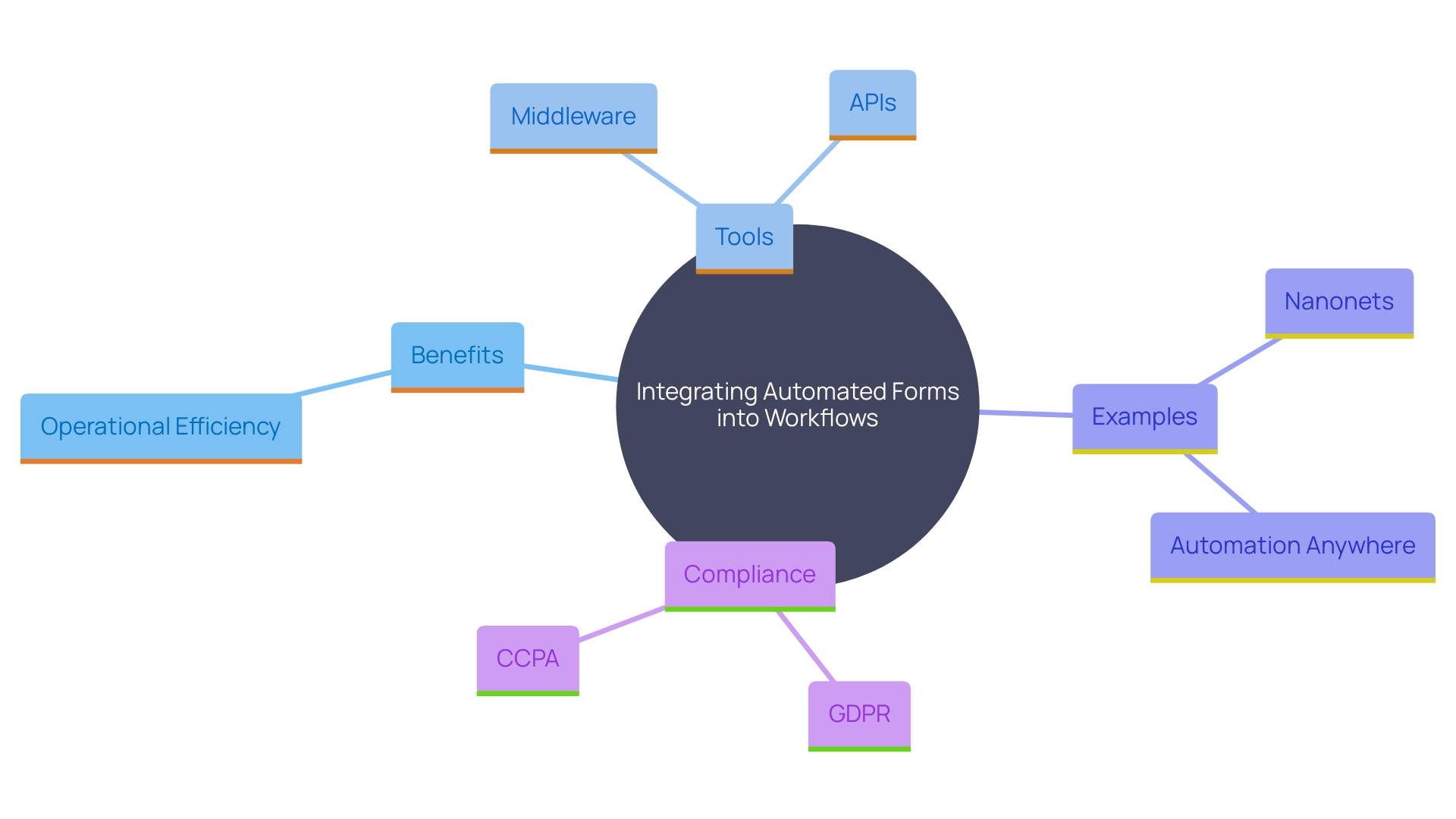
Real-World Examples of Automated Form Solutions
Enterprises in different industries have utilized the capabilities of automated document solutions to transform their operations. In healthcare, providers are utilizing automated patient intake documents to optimize information gathering, improving both efficiency and patient experience. This approach minimizes administrative burdens and speeds up the process, ensuring that healthcare professionals can focus more on patient care. In the financial sector, institutions have adopted automated loan application documents, which not only expedite the approval process but also maintain high data accuracy. This reduces the risk of errors and accelerates loan processing times, benefiting both the institution and the applicants.
Moreover, digital formats have become the new standard, especially post-pandemic. Unlike conventional paper documents, digital alternatives are created with human-centered principles to guarantee a smooth user experience. This shift is evident in government operations, where most forms have moved online, making processes more efficient and user-friendly.
‘The effect of these automated solutions is further emphasized by the fact that over 20,000 organizations, including industry leaders like Advent Health and Netflix, depend on platforms like Formstack for information collection and management.’. These platforms offer advanced workflow automation and a suite of capabilities that empower organizations to optimize their processes. As Rob Lawrence, Chief Operating Officer of Formstack, stated, ‘Formstack has a history of helping customers capture data and put it to work.’ This sentiment highlights the transformative potential of automated form solutions in driving operational excellence and innovation across industries.
Conclusion
Automated form processing is transforming operational efficiency by drastically reducing the time and effort required for manual data entry. This shift allows organizations to redirect resources toward strategic initiatives, enhancing productivity and fostering innovation. In industries like finance, the capacity to automate a large portion of operations enables employees to focus on higher-value tasks.
The advantages of form automation extend beyond mere efficiency. Organizations benefit from faster turnaround times, improved compliance, and enhanced data accuracy, which are crucial for navigating complex regulatory landscapes. The integration of AI further elevates these benefits by enabling the effective interpretation of intricate data inputs.
This strategic shift underscores the growing importance of automation and AI in modern business operations.
To fully leverage automated forms, seamless integration into existing workflows is essential. Utilizing APIs and middleware solutions fosters a unified system that streamlines data management and boosts overall efficiency. Real-world examples highlight significant operational improvements and compliance with evolving data privacy regulations across various sectors.
The impact of automated form solutions is evident, enhancing both operational efficiency and user experience. As organizations increasingly adopt these advanced technologies, they lay the groundwork for a more innovative and compliant operational framework, positioning themselves for sustained success in a competitive landscape.
Introduction
Artificial Intelligence (AI) models are the engines that power modern machine learning capabilities, and understanding their types, sizes, and features is crucial for leveraging their full potential. This article explores the different types of AI models, including supervised learning, unsupervised learning, and reinforcement learning, and their applications across various industries. It also delves into the implications of model sizes, highlighting the trade-offs between accuracy, resource requirements, and deployment challenges.
Additionally, the article emphasizes the importance of feature engineering in refining model features, enhancing their effectiveness, and improving computational efficiency. Lastly, it discusses the significance of understanding model features in terms of interpretability, bias detection, and feature importance analysis, as well as best practices for exploring and enhancing model functionality and accuracy. With the rapid growth of the machine learning market and ongoing research efforts, staying informed about AI model types, sizes, and features is essential for developers and businesses to harness the transformative power of AI and drive economic growth while prioritizing ethical considerations.
Understanding AI Model Types
Artificial Intelligence (AI) engines are the driving force behind modern machine capabilities, and comprehending their types is crucial for harnessing their potential. Supervised AI approaches, widely used in practice, rely on labeled datasets to train algorithms for classification or outcome prediction. These integral components are crucial for tasks such as image and speech recognition, as well as natural language processing.
Afterward, we explore unsupervised approaches, which operate with unannotated information to reveal concealed patterns or inherent structures. These approaches excel in clustering and association tasks, where they can identify groupings or relationships within data without prior knowledge of outcomes.
Lastly, reinforcement techniques are recognized by their capacity to make decisions. They learn through trial and error, using feedback from their own actions to optimize a specific reward function. This type of learning is instrumental in developing systems that must perform in uncertain or complex environments, such as robotics or game-playing AIs.
Each AI type is suitable for different applications and industries, as demonstrated by innovative uses in various sectors. For instance, in the field of public health, large language models are evaluated for their ability to classify and extract relevant information, which is essential for informed decision-making and resource allocation.
In the industrial sector, companies like ICL utilize AI for monitoring machinery in challenging environments, where the traditional sensor-based approach is impractical. By analyzing visual data, AI can detect anomalies and predict potential equipment failures, thereby enhancing operational efficiency and safety.
Moreover, the machine learning market is experiencing rapid growth, with projections indicating a rise to US$79.29 billion by 2024 and an anticipated CAGR of 36.08% from 2024 to 2030. The United States is expected to lead this expansion, with a market size of US$21.14 billion in 2024.
The development of AI systems is influenced by continuous research and cooperative endeavors, as well as by the necessity to tackle safety and ethical considerations. As AI continues to transform industries, its development is guided by a combination of innovation, regulation, and a commitment to societal benefit. By comprehending the unique characteristics and uses of various AI types, developers and businesses can utilize the complete potential of AI to stimulate economic growth and enhance our everyday lives.
Exploring Model Sizes
The scenery of AI development is characterized by a varied range of sizes, each customized for specific computational capabilities and tasks. From small-scale designs suitable for edge devices to massive architectures demanding substantial computational power, comprehending the implications of size is crucial. Significantly, smaller AI architectures, while less resource-intensive, may sometimes compromise on accuracy, whereas larger architectures deliver higher precision at the cost of increased training durations and deployment challenges.
Consider, for instance, the Mistral Medium, which embodies an intermediate size, skilled at managing tasks that necessitate moderate reasoning such as summarizing documents or creating job descriptions. This embodiment captures the balance between efficiency and performance, serving a wide range of language transformation applications without the excessive demand on resources usually linked with larger models.
The evolution of AI has seen a monumental rise in computational power usage, with a doubling every 3.4 months from 2012 to 2018. Despite the increase in investments in AI, this movement towards bigger and more resource-intensive structures is not feasible from a cost or hardware perspective. The conversation about AI safety and risks has also increased, especially with large language systems providing remarkable capabilities but introducing new challenges.
In reply, there is an increasing emphasis on creating more effective language systems. For example, research from arXivLabs emphasizes the scaling laws for large time-series systems, highlighting the significance of balancing performance with values like openness, community, excellence, and user data privacy. The conversation extends to the realm of embodied AI, where the neural scaling laws are critical for the development of AI systems that interact with the physical world.
As we dissect the intricacies of language model parameters, we observe that smaller language models may contain millions of parameters, while larger counterparts possess tens of billions. This stark contrast underscores the trade-offs between size, computational requirements, and capabilities, thus shaping the strategic decisions in AI development.
Analyzing Model Features
Artificial Intelligence (AI) utilizes a multitude of attributes derived from the data it processes, each crafted to capture unique characteristics crucial for the learning and performance of the AI system. Numeric characteristics, grouping characteristics, and written content are some of the most common, with each having a crucial part in the ability of the system to comprehend and analyze information. The process of characteristic manipulation is crucial in improving these attributes, enhancing a system’s capability to make precise forecasts or choices. By carefully choosing and developing characteristics, one can greatly enhance the efficiency of an AI system, making it more sensitive to the complexities of the data it is intended to examine. This precise design of characteristics frequently leads to a streamlined framework that not only functions more effectively but achieves this with increased efficiency, a critical benefit in a world where computational resources are both valuable and limited.
Importance of Understanding Model Features
Exploring the complexities of AI systems discloses that their achievement depends on a profound comprehension of their characteristics. Understanding, bias detection, and importance analysis play crucial roles in the development and deployment phases. Not only do these aspects impact performance, but they also affect how models are received and utilized in business environments. Effective feature selection can significantly enhance a model’s predictive power, and methods for assessing and improving feature importance are essential tools for today’s scientists.
Modern AI initiatives are steeped in complexities, often due to the intersection of uncertainties in both machine learning and product management. Achieving valuable and impactful solutions requires navigating these uncertainties with precision. The bizML framework, although not new to experienced data scientists, exemplifies the necessity of aligning business objectives with technical capabilities to maximize the benefits of AI. Fostering collaboration during the ‘preproduction’ phase of AI projects is vital for setting clear expectations and establishing criteria for performance evaluation.
As we expand the limits of artificial intelligence and aim for progress in AI, the significance of adaptability and openness cannot be emphasized enough. The evolution of AI is characterized by dynamic, non-deterministic applications, demanding a future where AI models are accessible and tailored to individual needs. In this context, the principles of transparency, reproducibility, accountability, and ethical responsibility are paramount. Recording the sources and methodologies of AI systems, including any synthetic information, establishes a basis for comprehending potential biases and ethical considerations.
The pursuit of feature engineering excellence is an ongoing journey, one where collaboration and community involvement are encouraged. Initiatives like arXivLabs demonstrate the commitment to openness and community-driven innovation. By embracing these principles, we can collectively enhance the capabilities of AI systems and bring forth solutions that not only serve the immediate needs of businesses but also contribute to the broader field of information science.
Best Practices for Exploring Model Features
To effectively utilize AI systems, it is essential to engage in practices that enhance their functionality and accuracy. Data preprocessing is a vital step that ensures the input information is clean and uniform, which aids in dependable performance of the model. Feature scaling is another practice that normalizes the range of independent variables, allowing the algorithm to converge more quickly during training. Moreover, feature extraction, which includes converting raw data into a group of characteristics that can be efficiently processed, is crucial for decreasing the dimensionality of data and enhancing efficiency.
A thorough evaluation of the comprehensive framework is crucial to grasp the predictive capability of the system and to pinpoint areas for enhancement. It is a multifaceted process that requires careful consideration of safety, industry application, political implications, and potential risks. As the AI Act highlights, human rights are central to AI development, necessitating risk assessment from the standpoint of potential harm to individuals. Adhering to these best practices not only streamlines the workflow but also ensures that the AI models developed are robust, ethical, and have a positive impact on society and technology.
Conclusion
In conclusion, understanding the types, sizes, and features of AI models is crucial for leveraging their potential in various industries. Supervised, unsupervised, and reinforcement learning models have diverse applications and contribute to the rapid growth of the machine learning market.
Model size is an important consideration, balancing efficiency and accuracy. Smaller models may compromise accuracy, while larger models pose deployment challenges. Efforts are focused on developing more efficient language models to address scalability and safety concerns.
Feature engineering refines AI models, enhancing their predictive power. Understanding model features is essential for interpretability, bias detection, and feature importance analysis. Effective feature selection and assessment methods improve model performance.
Flexibility, openness, and ethical responsibility are paramount as AI models evolve. Transparency and reproducibility are critical for understanding biases and ethical considerations. Embracing openness and community-driven innovation enhances the capabilities of AI models.
Engaging in best practices, such as data preprocessing, feature scaling, and feature extraction, improves model functionality and accuracy. Comprehensive model evaluation considers safety and industry application, ensuring the development of robust and ethical AI models.
By understanding AI model types, sizes, and features, developers and businesses can harness the transformative power of AI, drive economic growth, and prioritize ethical considerations. Staying informed and implementing best practices will maximize the benefits of AI and overcome challenges.
Introduction
Large Language Models (LLMs) have revolutionized natural language processing and business problem-solving. These models, such as GPT-3.5 and GPT-4, possess intricate components that enable them to understand and generate human language accurately. The architecture of LLMs, built upon layers that process and produce language patterns, is a foundational element.
Training data and fine-tuning techniques, like prompt engineering and retrieval-augmented generation, further refine the models’ capabilities. However, challenges such as model token constraints and associated costs need to be addressed. By dissecting these components, we enhance our comprehension of LLMs and pave the way for more effective and safe applications in various domains.
In this article, we explore the key components, training, applications, architecture, transformers, embedding layers, attention mechanisms, fine-tuning and prompt-tuning techniques, evaluation, and ethical considerations of LLMs.
Key Components of LLMs
Large Linguistic Models (LLMs) like GPT-3.5 and GPT-4 are revolutionizing the field of natural language processing (NLP) and problem-solving in business. They are made up of complex elements that allow them to comprehend and produce human communication with impressive precision. The structure of these architectures is a fundamental component, constructed upon layers that analyze and generate language patterns. Training data is another crucial aspect, involving extensive amounts of diverse text to prepare the systems for a wide range of questions and prompts. Fine-tuning methods, including prompt design and retrieval-enhanced generation, additionally enhance the capabilities of the models, offering more relevant and precise responses to particular queries. These techniques, however, come with their own set of challenges, including limitations due to model token constraints and associated costs. By analyzing these components, we not only improve our understanding but also open up opportunities for more efficient and secure applications in various fields.
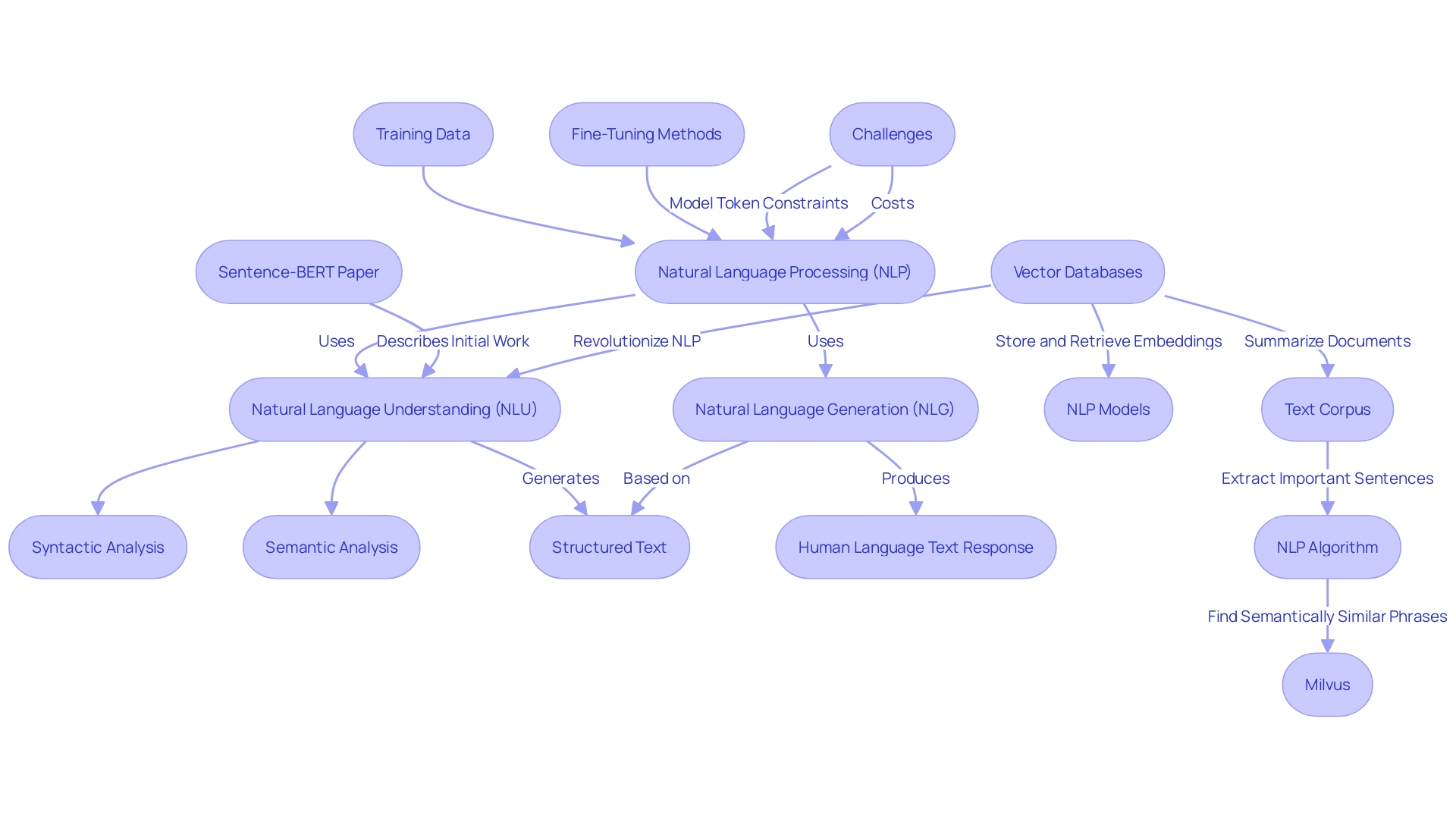
Training and Fine-Tuning LLMs
Creating extensive language models requires a careful training process that involves a combination of methods such as pre-training, fine-tuning, and reinforcement learning. The initial phase, pre-training, involves exposing the LLMs to vast amounts of text, enabling them to learn language patterns and structure. The subsequent fine-tuning phase adjusts these structures to perform specific tasks by training on a smaller, task-focused dataset. This process ensures the model’s performance is optimized for its intended application.
The education of advanced legal studies isn’t without its challenges. The selection of training data must be approached with caution, considering the guidelines that govern the use of LLMs, as well as the ethical implications of the data implemented. This is crucial to avoid emergent abilities that may lead to unpredictability in the behavior of the system. Moreover, the intricate character of these frameworks requires significant computational resources, raising concerns about privacy and the ecological consequences of their creation.
The development of language models is characterized by advancements like the Transformer architecture, which has transformed the domain by offering both contextual and positional comprehension to text. Meanwhile, case studies highlight the importance of domain-specific training, where models are tailored to comprehend and analyze lengthy, complex documents such as legal texts or regulatory frameworks.
In the dynamic landscape of AI research, the continuous open-sourcing of projects and collaborative efforts are propelling advancements. Research papers such as ‘Large Language Models for Education: A Survey’ demonstrate the wide range of uses of large language models across different sectors, from the educational sphere to legal matters. As research teams impact technology on a global scale, the incorporation of language and learning models into products and services is becoming increasingly commonplace, demonstrating their practical utility and relevance in today’s digital ecosystem.
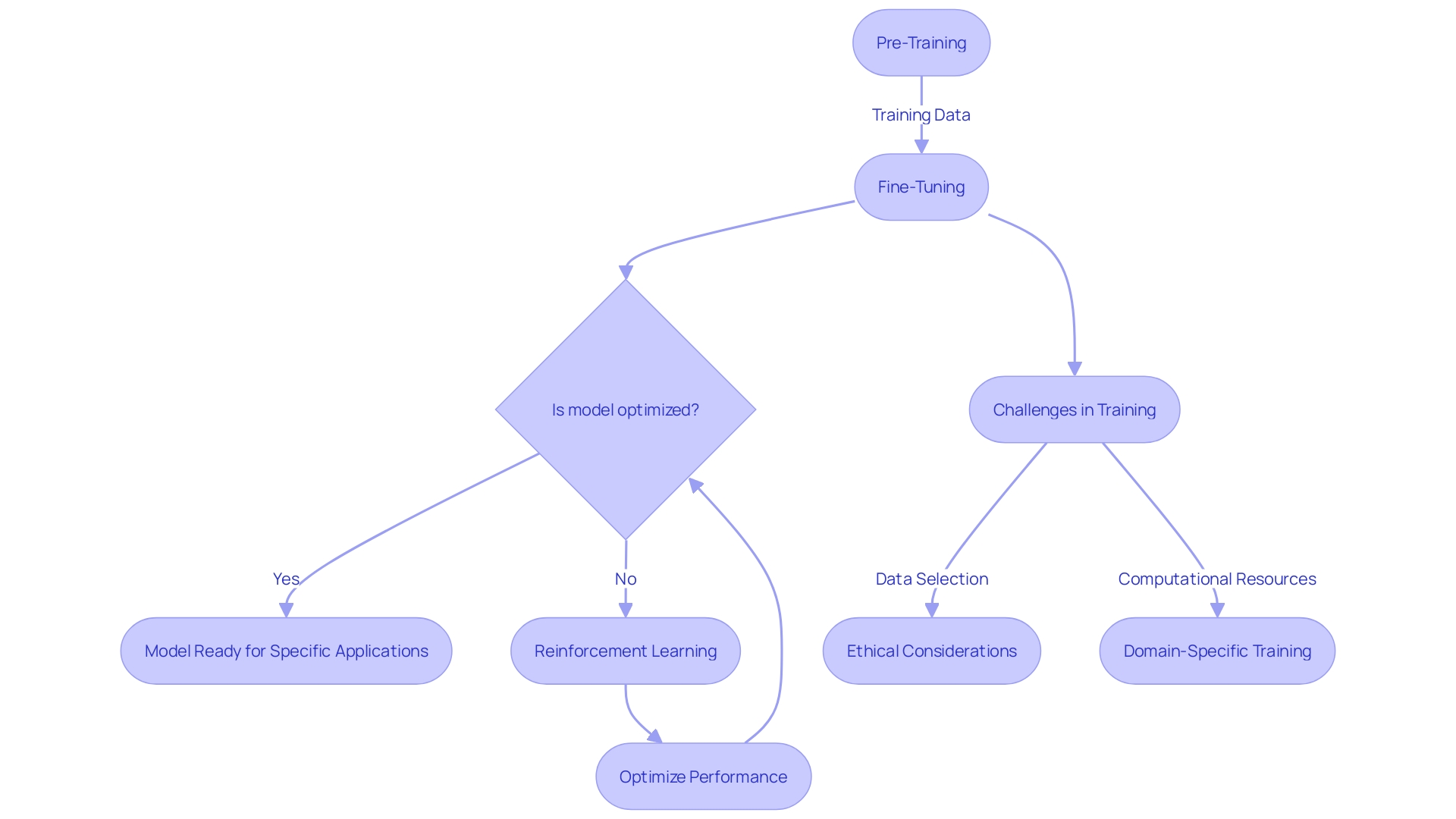
Applications of LLMs
Big Language Models are changing the way we engage with technology, providing transformative solutions in various industries. These advanced AI systems excel in a variety of tasks, including understanding of human speech (NLU), generating human-like text (NLG), and facilitating dynamic interactions through chatbots and sophisticated machine translation services. Language models possess the ability to process and analyze large volumes of data, allowing them to comprehend natural language with impressive accuracy. This is not only driving advancements in areas such as smart education, where language learning models are becoming an integral component, but also shaping tools for cyber defenses, public health classification, and extraction tasks.
In the field of education, for instance, researchers such as Hanyi Xu are investigating the educational uses of language models, which are demonstrating to be effective supplementary tools integrating technologies such as deep learning and reinforcement learning. The smart utilization of advanced learning methods in education is becoming a priority worldwide, as they can customize learning, offer automated assessment, and provide intelligent tutoring systems.
In the field of cybersecurity, authors such as Mohammed Hassanin have provided comprehensive overviews on leveraging language models for cyber defenses, highlighting opportunities where these approaches can identify and counteract threats, improving the security landscape significantly.
Moreover, the implementation of language learning models in public health is demonstrated by the research conducted by Joshua Harris and his team, who assessed the effectiveness of these models in categorizing and retrieving public health data, showcasing the capacity of these models to assist healthcare practitioners in improving information management.
These applications are just the tip of the iceberg. According to industry experts, sounding boards are beneficial in enhancing our understanding of intricate subjects, acting as aids in brainstorming, and aiding in the effective expression of content. They remind us to begin with clear business objectives and metrics, selecting the appropriate LLM tool that aligns with business needs while taking into account aspects such as computational resources and cost-effectiveness.
Adopting a culture of ongoing experimentation and keeping up with the latest advancements is essential for fully leveraging the potential of language models. As research into the inner workings of AI models like Claude Sonnet reveals, our understanding of these systems is deepening, leading us towards more reliable and safe AI applications. With these insights, it’s evident that language models are not only academic curiosities but practical tools prepared to address real-world challenges.
Understanding the Architecture of LLMs
Exploring the complexities of Large Language Models (LLMs), one must recognize the crucial function their structure serves in processing and generating textual data. At the heart of these formidable AI constructs lies the transformer, a groundbreaking neural network structure that has revolutionized how machines understand text. Transformers are adept at handling sequences of data, making them ideal for the complex task of language modeling. With multiple layers of interconnected neurons, these systems are trained to recognize patterns in text, enabling them to predict subsequent words and generate coherent passages.
The efficiency of legal language models depends on their capacity to assess responses within context. Consider the example of Claude Sonnet, a state-of-the-art LLM that has been dissected to reveal the representation of millions of concepts within its digital neural web. This advancement in AI interpretability opens the door for more dependable and credible approaches. Just as Claude Sonnet’s inner workings have been unveiled, other LLMs are evaluated using a trusted scoring system, rating responses to ensure unbiased, logical, and high-quality outputs.
One of the recent advancements in LLM architecture is the introduction of Infini-attention, a method that extends a system’s ‘context window’—the span of data it can consider at any given time. ‘This innovation allows systems to maintain performance even when dealing with extensive text sequences, ensuring that no part of the conversation is lost or disregarded due to limitations in processing capacity.’.
Furthermore, advanced linguistic models are not just focused on generating text; they are concerned with comprehending and analyzing the extensive quantities of information that encapsulate human communication. For instance, Computational Mechanics, a theory developed to study prediction limits in complex systems, reveals that optimal prediction requires intricate structures within the model—structures that are often more complex than the data-generating process itself.
Basically, the structure of the machine learning models is a carefully coordinated arrangement of data processing tiers, each adding to the model’s capacity to understand, anticipate, and produce speech with a continuously growing degree of complexity. As the field develops, it is essential to stay updated on these advancements to fully utilize the complete potential of language models for a wide range of applications.
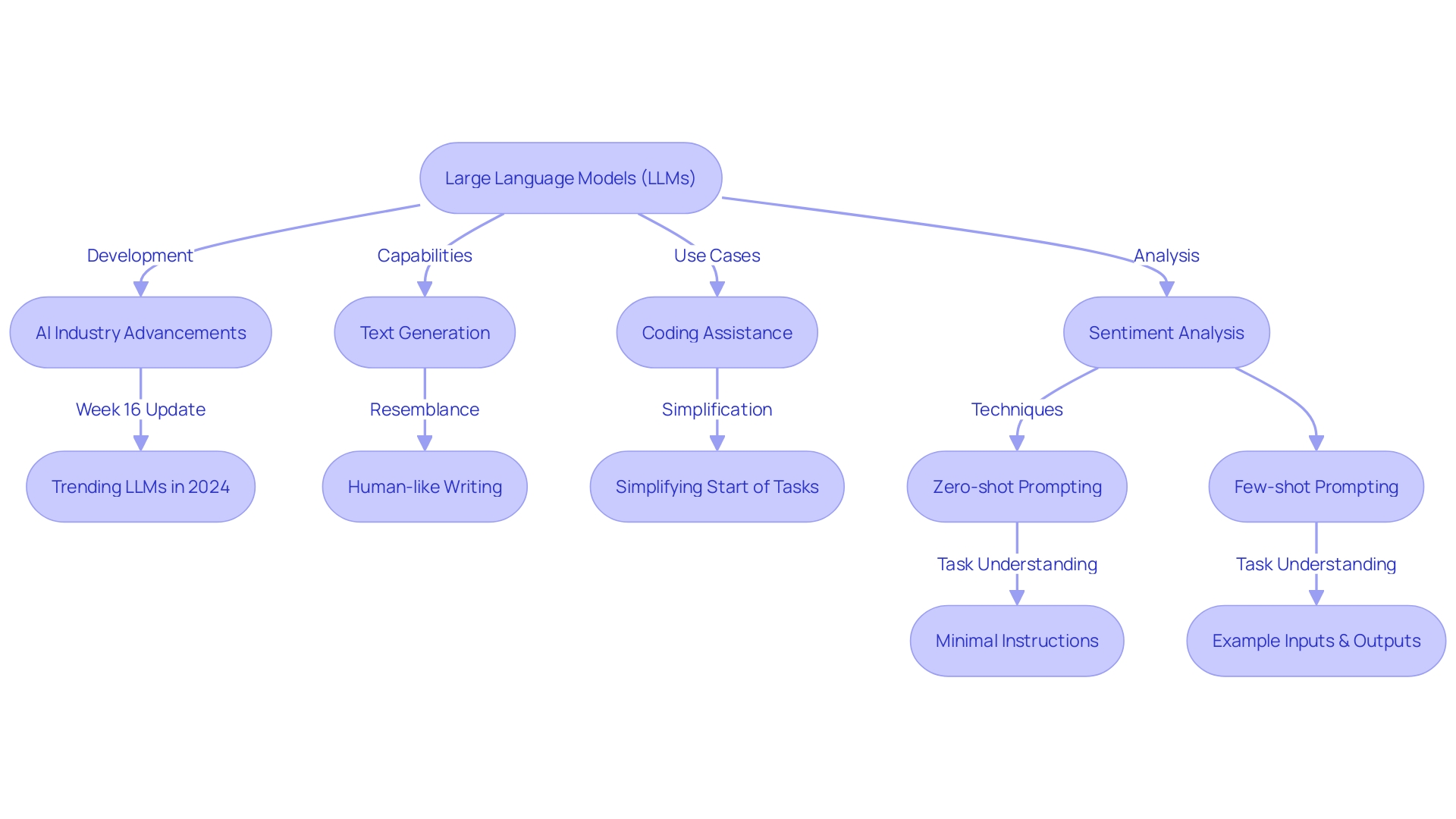
The Role of Transformers in LLMs
Transformers play a crucial role in enhancing the capabilities of natural language processing, acting as the foundation for Large Language Models. These mechanisms utilize transformers to process and learn from extensive datasets, interpreting and generating text resembling that produced by humans. Notably, transformers excel at understanding context, which is pivotal for tasks such as translation, summarization, and question-answering.
Recent advancements, like Infini-attention, have tackled constraints in the models’ context window—the range of text that can be taken into account at a given moment—by empowering LLMs such as Google’s to efficiently handle unlimited lengths of text without escalating memory or compute requirements. This innovation ensures that even extended interactions with entities, such as ChatGPT, remain coherent and contextually aware throughout.
In the domain of Retrieval-Augmented-Generation (RAG), transformers are further enhanced by integrating external knowledge bases, allowing responses to be both factual and nuanced. This approach not only grounds the system’s outputs in accurate information but also supplies domain-specific insights, showcasing the transformers’ adaptability.
The scalability of transformers is underpinned by their architecture, which provides meaning to individual tokens within large bodies of text. As mentioned in recent literature, transformers are essential for pre-trained language models, which can vary from models with 110 million parameters like Google’s Bert base to those with 340 billion parameters such as Google’s PaLM 2.
Despite their transformative impact, legal masters degrees and transformers are not without challenges. There are worries about the ethical consequences of AI, specifically concerning the utilization of artistic creations without permission for training. There is also the risk of perpetuating biases present in the training data, potentially leading to discriminatory language or content. Professionals have emphasized the possibility of information dangers, malevolent applications, and financial damages connected to LLMs.
Comprehending the two-fold characteristics of transformers—their impressive abilities and the obstacles they pose—is essential for the continuous advancement and conscientious utilization of language models. As the field evolves, so does the dialogue around the societal implications of these technologies, driving the need for continued research and thoughtful implementation.
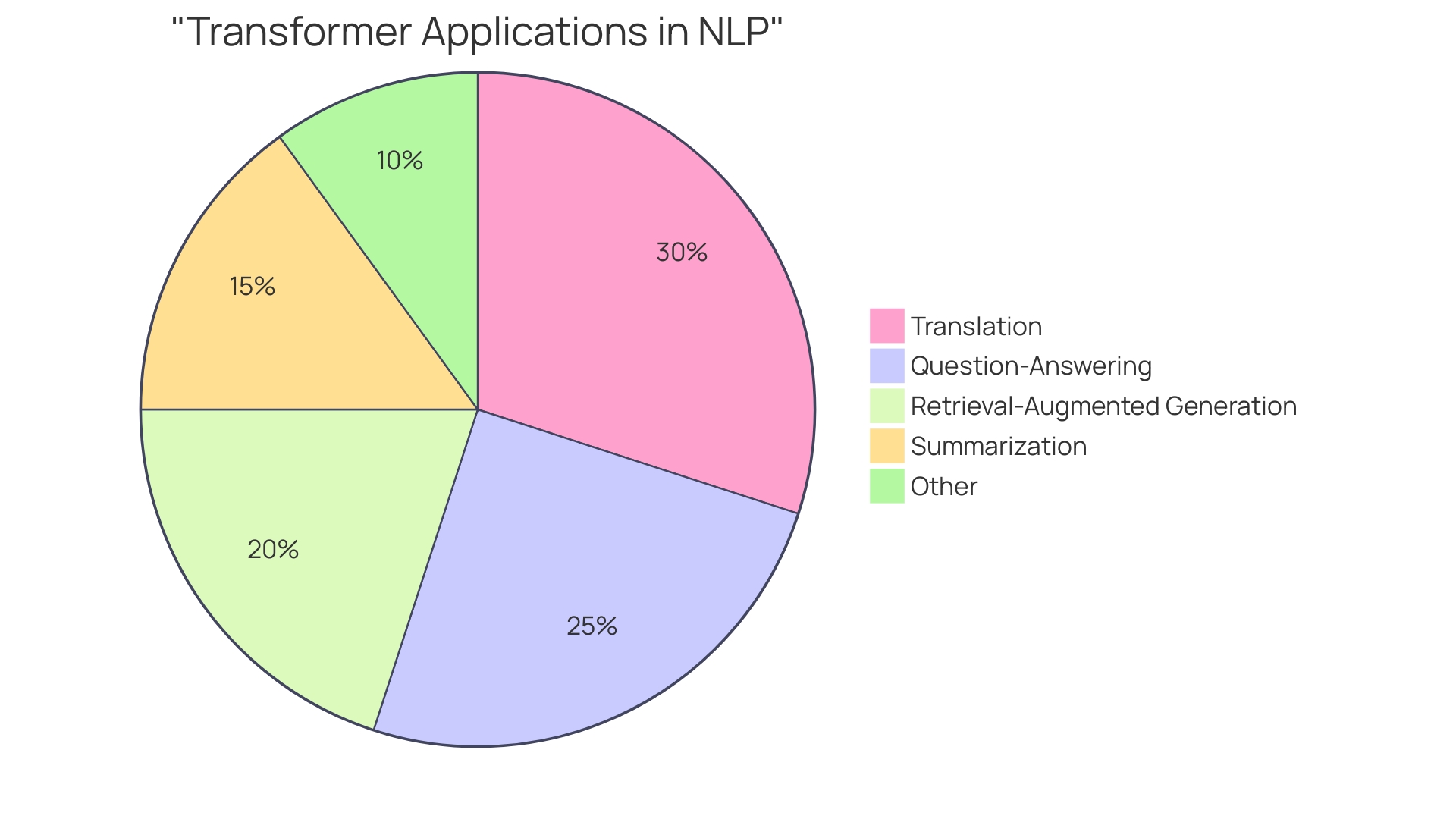
Embedding Layers and Attention Mechanisms
Embedding layers and attention mechanisms are not just jargon in the realm of large language structures (LLMs); they are the very foundation that gives these structures their remarkable ability to comprehend and produce language. Embeddings serve as a translation mechanism, converting words into numerical vectors that encapsulate their meaning in a way that machines can process. Imagine a vast library where each book represents a word, and embeddings are librarians that organize these books so efficiently that relationships and context are preserved across the shelves of this high-dimensional space.
At the same time, attention mechanisms function as discerning readers who precisely know which books to pull from the shelves in order to comprehend a sentence or create a response. They determine the importance of various words in a sentence, enabling the system to concentrate on the most informative sections when making predictions or producing text. This powerful combination of embedding layers and attention mechanisms forms the foundation of models such as Gemini, which pushes boundaries with improved processing and enhanced linguistic comprehension, and Meta Llama 3, renowned for its performance in a wide range of tasks from healthcare classification to multilingual translation.
The advancement of embedding layers and attention mechanisms is continuously documented in academic circles, as seen in papers from arXiv Labs, where researchers explore and optimize these components for enhanced language understanding. For example, the RDR method, an innovation detailed in one of these papers, demonstrates the ongoing evolution of attention mechanisms that aim to recap, deliberate, and respond more effectively to complex linguistic data.
These technological advancements are not merely theoretical exercises but have real-world consequences in different domains, such as public health, where similar language learning models evaluated in Joshua Harris’s research aid in categorization and extraction tasks. The adaptability and efficiency of language models are exactly why they are at the forefront of AI advancements, underpinning applications that range from the everyday, such as search and recommendation systems, to the extraordinary, such as aiding legal professionals, as discussed in the paper ‘Better Call GPT’
Fine-Tuning and Prompt-Tuning Techniques
Customizing Large Language Models (LLMs) to perform exceptionally in specific domains and tasks involves advanced techniques like fine-tuning and prompt-tuning. The complexity of fine-tuning involves adjusting the parameters of the system to align with domain-specific data, which improves its proficiency in generating high-quality, relevant content. Prompt-tuning, on the other hand, focuses on crafting inputs that guide the model towards generating text that aligns with a desired outcome or style, essentially instructing the model on how to approach a task.
A noteworthy example of the power of fine-tuning is encapsulated in the paper titled ‘Bitune: Bidirectional Instruction-Tuning’ available on arXivLabs, which underscores the commitment to advancing research through collaboration and open science. This paper illustrates the meticulous process of refining LLMs for enhanced performance.
Prompt-tuning also has had its share of the spotlight, with innovative approaches like the ‘Chain Of Thought’ (Cot) prompting. This technique, which may begin with a simple addition such as ‘Let’s take this step by step,’ can significantly improve the model’s reasoning capabilities. It’s a testament to the subtle yet potent art of prompt engineering, which is rapidly becoming an indispensable skill for those working closely with specialized legal professionals.
Recent news from the field includes insights from experts like Hanna Hajishirzi, who shared the latest advancements in language models during a luncheon keynote. Her remarks emphasized the fluency of the structures and their expanding role in diverse applications, highlighting both their societal impact and economic implications.
As we keep investigating the boundaries of language models, it’s evident that the combined utilization of fine-tuning and prompt-tuning techniques is essential for unleashing the complete capability of these systems in specialized tasks. Through ongoing research and experimentation, the future of legal language models is poised to be as dynamic and exciting as the systems themselves.
Evaluating LLMs: NLU and NLG Tasks
To leverage the complete capabilities of Large Language Models (LLMs), a thorough evaluation process is essential. This involves not only assessing the core abilities of the model itself but also examining its performance within specific applications and in response to user interactions. For instance, cutting-edge platforms such as Yoodli employ language models for speech analysis and feedback generation, emphasizing the significance of upholding top-notch, pertinent, and reliable language model responses to guarantee a favorable user experience. Similarly, monitoring AI systems, such as those applied in healthcare, is crucial for ensuring reliability, compliance, and patient safety. The evaluation criteria must include metrics that cover response completeness and conciseness, and the system’s ability to adapt to new experiments and user prompts.
A robust set of metrics is essential for scoring an LLM’s outputs, which act as a barometer for its effectiveness in understanding and generating natural language. These metrics should effectively identify any anomalies and enable the comparison of output quality across various LLM configurations. As the technology evolves and user expectations increase, it becomes even more critical to have these evaluation tools in place. For example, recent research has emphasized the convincing ability of language learning models, particularly when provided with customized information – a factor that can greatly impact their effectiveness. Therefore, ongoing monitoring and organized assessment are crucial for the responsible implementation of language models in any field, ensuring they stay efficient, secure, and in line with user requirements.
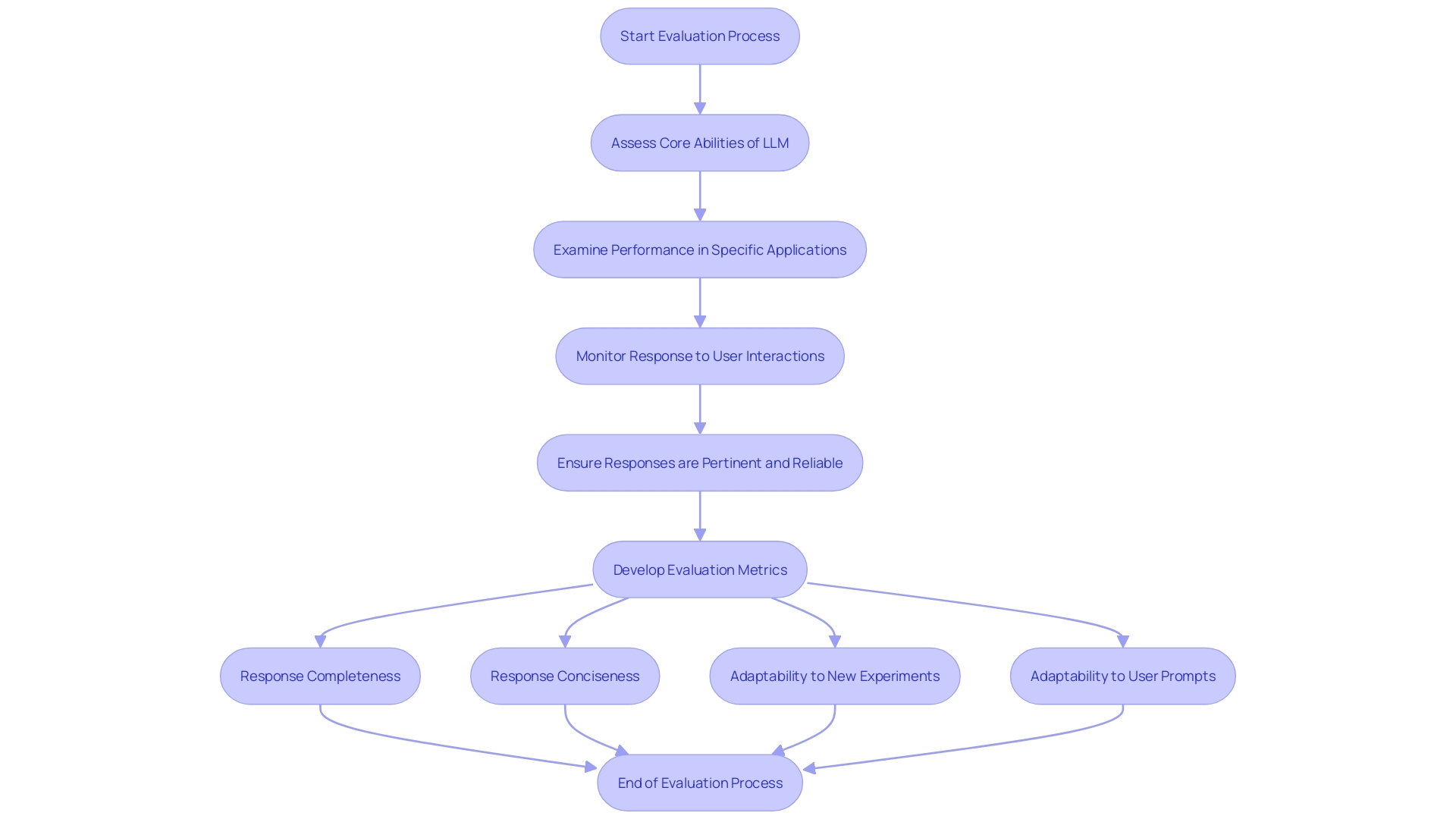
Challenges and Ethical Considerations in LLMs
Powerful language models have made a significant impact in the digital realm with their capacity to comprehend and produce text that resembles human language, influencing various industries ranging from online retail to customer support. However, with great power comes great responsibility, and the implementation of language models is not without its challenges and ethical considerations. One of the key issues is the potential for bias within these models, which can be a reflection of biased training data. This bias can have far-reaching consequences, influencing decisions and perpetuating stereotypes in sensitive applications.
As emphasized in a survey on the fairness of legal master’s degrees in e-commerce, bias is not just a theoretical concern but a practical challenge that needs to be addressed. The study highlights the significance of transparency throughout the entire process of legal information management, from the initial data gathering to the final utilization. To minimize the risks associated with bias in language models, recent studies suggest various strategies, such as knowledge editing, which involves adjusting the knowledge base of a language model to reduce biased outputs.
Moreover, the potential for malicious use of LLMs cannot be ignored. The flexibility of these options means they could be utilized to create deceptive information or even cyber threats. Addressing these challenges necessitates a comprehensive approach, encompassing strong data analysis techniques, diligent monitoring of algorithms, and ethical principles for utilization.
Insights from practical case studies, such as those presented by LaPlume on large-scale web-based data analysis, provide valuable lessons for handling large language models. These include data cleaning, analysis, and visualization techniques that are essential for ensuring the integrity of the models. Moreover, showcased research and innovations in the field from esteemed conferences such as EMNLP (Empirical Methods in Natural Language Processing) demonstrate a community committed to responsibly advancing language models.
With the right combination of research, ethics, and technical safeguards, the challenges posed by LLMs can be effectively managed, ensuring these powerful tools are used for the betterment of society while minimizing harm.
Conclusion
In conclusion, Large Language Models (LLMs) have revolutionized natural language processing and business problem-solving. These models possess intricate components that enable them to understand and generate human language accurately. The architecture of LLMs, built upon layers that process and produce language patterns, is a foundational element.
Training data and fine-tuning techniques, such as prompt engineering and retrieval-augmented generation, further refine the models’ capabilities.
By dissecting these components, we enhance our comprehension of LLMs and pave the way for more effective and safe applications. LLMs excel in tasks such as natural language understanding, generation, and facilitating dynamic interactions. Their wide range of applications includes areas like smart education, cybersecurity, and public health.
Embedding layers and attention mechanisms form the foundation of LLMs, allowing them to understand and generate language effectively. The fine-tuning and prompt-tuning techniques further customize LLMs for specific domains and tasks. Evaluating LLMs is crucial to ensure high-quality and relevant outputs, with metrics covering response completeness, conciseness, and adaptability.
However, challenges and ethical considerations, such as bias and malicious use, must be addressed. Transparency, bias mitigation strategies, and robust safeguards are necessary to responsibly deploy LLMs. Continuous experimentation and staying up-to-date with the latest developments are essential for leveraging the potential of LLMs effectively and responsibly.
In summary, LLMs are powerful tools that have practical applications across various domains. Understanding their components, training techniques, architecture, and evaluation processes is key to harnessing their full potential. By addressing challenges and ethical considerations, we can ensure the responsible deployment of LLMs for the benefit of society.
Introduction
The landscape of virtual assistants has been revolutionized by the emergence of sophisticated Large Language Models (LLMs). These AI-driven assistants, such as Siri, Alexa, and Google Assistant, have the ability to process natural language with unprecedented precision, delivering responses that are not only human-like but also highly relevant and useful. This article explores the diverse applications of LLMs, from translation and localization to question answering, market research, and consumer insights.
We will also delve into real-world examples showcasing how LLMs are transforming industries and enhancing customer experiences. Get ready to discover the immense potential of LLMs in empowering businesses and revolutionizing the way we access and utilize knowledge.
LLMs in Virtual Assistants
The virtual assistants’ landscape has been profoundly changed by the emergence of advanced Large Language Models (LLMs), like the ones that support Siri, Alexa, and Google Assistant. These AI-driven assistants can now process natural language with a level of precision that was once unattainable, thanks to their training on extensive textual datasets. As a result, they can deliver responses that not only seem human but are also highly relevant and useful for the end-user.
The development of these frameworks has been propelled by neural network architectures called transformers, which signify a noteworthy advancement from previous frameworks that could only anticipate the subsequent word in a sequence without comprehending context. Now, these transformers enable language models to understand the complete extent of a query, taking into account the different meanings and implications of words within the provided context. This progress has resulted in a surge of curiosity, as demonstrated by the lively public debates regarding open versus closed source models in 2023.
Additionally, the possible uses of language learning models go far beyond only virtual assistants; they are demonstrating their worth in the area of coding, assisting in code creation and conversation, thereby making the start of new projects more accessible and efficient. In the midst of the advancements, issues regarding privacy are being dealt with through innovations like Apple’s on-device AI, which ensures improved privacy safeguarding while upholding the advantages of language learning models.
OpenAI has recently made headlines with its GPT-4 Turbo, which showcases improved capabilities and accessibility for developers. Meanwhile, Mistral Ai’s Mistral-7B-Instruct-v0.3 introduces function calling in a medium-sized version, and the Technology Innovation Institute’s Falcon 2 brings advanced LLM features to a broader audience. These advancements are a sign of the increasing flexibility and expandability of language models, opening up opportunities for their integration into various practical uses.
LLMs in Translation and Localization
Advanced Language Models (ALMs), like the multimodal Gemini from Google DeepMind, are transforming the domain of translation and localization with their profound comprehension of language subtleties. These advanced models are trained on extensive datasets and are capable of producing translations that closely mirror human-quality text. For instance, Meta Ai’s Seamless Communication project is pushing the boundaries by merging multiple neural networks to enable real-time, authentic translation across over 100 languages, preserving the original voice and emotion of the speaker.
Significant progress in large language models has enabled high-quality simultaneous translation, as emphasized in the paper ‘Simul-LLM: A Framework for Exploring High-Quality Simultaneous Translation with Large Language Models’ by Victor Agostinelli and his colleagues. This study highlights the possibility of supporting not only multilingual communication but also low/no-resource languages, as demonstrated in the work ‘LLM-Assisted Rule Based Machine Translation for Low/No-Resource Languages‘ by Jared Coleman and his team. These developments are crucial for businesses aiming to reach a global audience and for communities in need of reliable healthcare information, such as those in LMICs, where platforms like WhatsApp facilitate access to expert advice and support.
LLMs in Question Answering
As the field of information retrieval progresses, Large Language Models (LLMs) are leading the way in transforming question answering systems. By drawing on extensive databases, these models are not limited to a single domain but can traverse multiple fields, providing precise answers to queries across various sectors such as education, customer support, and research. Innovative studies, such as the one led by Zhiwei Huang and colleagues, have demonstrated the potential of advanced language models in academic conference settings, validating their capacity to analyze large amounts of semi-structured data to support researchers in keeping up with the most recent advancements.
Moreover, advancements such as MEDITRON, directed by Professor Mary-Anne Hartley, demonstrate the incorporation of medical learning modules into medical knowledge, emphasizing the significance of reliable, research-driven information for making clinical decisions. This intersection of technology and domain-specific expertise highlights the adaptability and relevance of specialized language models in addressing specific requests, thereby democratizing access to information.
The significant influence of postgraduate law degrees is also apparent in the educational sector, where their integration has become a global strategic priority. Advanced technologies, such as deep learning and reinforcement learning, are used to enhance the learning experience. This aligns with the values of arXivLabs, which emphasizes openness and community collaboration in the development of innovative educational tools.
As we navigate an era where generative AI exhibits human-like linguistic capabilities, the importance of language models in question answering systems becomes increasingly clear. Whether it’s for academic investigation or providing customer support, legal masters’ degrees are redefining the efficiency and reliability of information retrieval, embodying a monumental shift in the way we access and utilize knowledge.
LLMs in Market Research and Consumer Insights
In the dynamic sphere of market research and consumer insights, Large Language Models are emerging as pivotal tools for businesses. These advanced AI systems, which are built on millions or even billions of parameters, are skilled at analyzing extensive volumes of text information to uncover patterns, grammar, and semantics. Helen Toner observes that the information produced by language models is a compilation of pre existing elements, showcasing the inherent prejudices and constraints of the instructional material. With the ability to analyze over 3 billion pages of online content, as mentioned by the European Data Protection Supervisor, these advanced language models provide a detailed comprehension of consumer behavior, preferences, and market trends.
Applying advanced language models for market analysis involves a thorough analysis process, starting from cleaning the information to visualizing it. This approach mirrors the ten-step procedure recommended by LaPlume for investigative cases, which emphasizes the significance of comprehending investigation approaches and analytics, especially in the context of web-based data. These steps are not only instructive but also adaptable for various applications, ensuring that businesses can tailor the process to meet their unique needs.
Moreover, the incorporation of language models into market investigation acts as a type of supplementary investigation, enhancing primary approaches like surveys and interviews. By effectively processing and interpreting large datasets, these models provide structured insights that assist businesses in strategizing and targeting their audience more efficiently. The result is a powerful combination of exploratory and specific research, leading to informed decision-making and robust marketing strategies that resonate with consumers.
Real-World Examples of LLM Applications
Advanced language models, with their advanced capabilities, are increasingly becoming integral to diverse industries, transforming operations, and enhancing customer experiences. In customer support, automation is being used to optimize interactions and provide real-time support, thereby personalizing the customer journey. The e-commerce and retail industries use advanced algorithms to improve product recommendations and streamline search capabilities, resulting in more efficient customer service. Cybersecurity professionals utilize advanced tools to proactively detect and address cyber risks, while also examining security information to identify weaknesses. Healthcare and biomedicine have benefited from the use of advanced machine learning models in diagnostics, drug development, and the curation of tailored treatment plans by analyzing comprehensive patient data.
Content creation and advertising have also been transformed by language models, which now aid in creating captivating stories, developing strategic marketing campaigns, and overseeing social media presence. Educational tools, powered by artificial intelligence models, are providing customized learning experiences and assisting in the development of educational content. Furthermore, advanced legal degrees are becoming more and more important in financial services for automating repetitive tasks, detecting fraudulent behavior, and offering customized financial guidance. Each application demonstrates the transformative power of LLMs across sectors, indicating a shift towards more intelligent, efficient operations and a heightened focus on customer-centric experiences.
Conclusion
In conclusion, Large Language Models (LLMs) have revolutionized virtual assistants by delivering human-like and relevant responses. LLMs have diverse applications in translation, question answering, market research, and more. They enhance the educational sector and provide valuable insights for businesses.
LLMs have transformed translation and localization with their understanding of language nuances. They enable real-time, authentic translation and preserve the speaker’s voice. In question answering systems, LLMs provide precise answers across sectors and democratize access to information.
They also enhance the learning experience in education.
In market research and consumer insights, LLMs analyze text data to understand consumer behavior and market trends. They complement primary research methods and provide structured insights for effective targeting. LLMs have practical applications in customer support, e-commerce, cybersecurity, healthcare, content generation, marketing, education, and financial services.
Overall, LLMs empower businesses and revolutionize knowledge access and utilization. They drive intelligent and efficient operations, as well as customer-centric experiences. With their advanced capabilities, LLMs shape the future of AI-driven technology and drive innovation across industries.
Unlock the power of LLMs to gain valuable insights into consumer behavior and market trends.
Introduction
Embarking on the integration of a chatbot into your business requires careful planning and analysis of your customer base and their challenges. By taking a strategic approach and leveraging AI, you can streamline tasks, enhance user engagement, and drive operational efficiency. In this article, we will explore key factors to consider when choosing a chatbot development company, evaluating chatbot development platforms, assessing integration capabilities, ensuring scalability and customization, understanding cost considerations, and learning from successful chatbot implementations.
By understanding these aspects, you can make an informed decision and develop a chatbot that exceeds user expectations and contributes to your company’s success.
Understanding Your Business Needs
Starting the incorporation of an AI assistant into your enterprise starts with a thorough examination of your client base, identifying their difficulties, and determining the operations you want to simplify or enhance with artificial intelligence. By adopting this strategic approach, you’re laying the foundation for an automated conversational agent that not only fulfills your goals but also allows for expansion and creativity. Similar to Uber leveraging AI to fine-tune interactions in real-time, the implementation of a conversational interface should aim to enhance engagement and satisfaction.
To ensure a seamless integration, start with a plan that resonates with your specific needs. Customizing the Ai’s learning by providing it with top-notch datasets, like website content and customer dialogue, can greatly enhance the response accuracy of the conversational agent. Embrace the iterative process of AI development: early versions may not be perfect, but through user acceptance testing and continuous feedback, the AI will evolve, much like a child learning from conversation.
The journey of AI integration is one of incremental innovation. By quickly deploying an initial version and allowing your team to test its efficacy, you can build upon a solid foundation, introducing new and unforeseen functionalities that could give your company a competitive edge. As you weave this technology into your operations, it’s crucial to consider the long-term ROI, the alignment with your product strategy, and the maintenance processes that will ensure the chatbot’s relevance and effectiveness over time.
With AI-powered chatbots, the opportunity to automate onboarding, provide instant support, and collect valuable insights is immense. Recent studies have shown that, besides lead generation, chatbots can provide immediate support, with many companies strategically placing them on main and pricing pages to address FAQs and enhance the experience of individuals.
To summarize, careful strategizing, accurate information input, and a willingness to continually improve are the essential elements in creating a conversational AI system that not only fulfills but surpasses the expectations of individuals, consequently enhancing operational effectiveness and customer contentment.
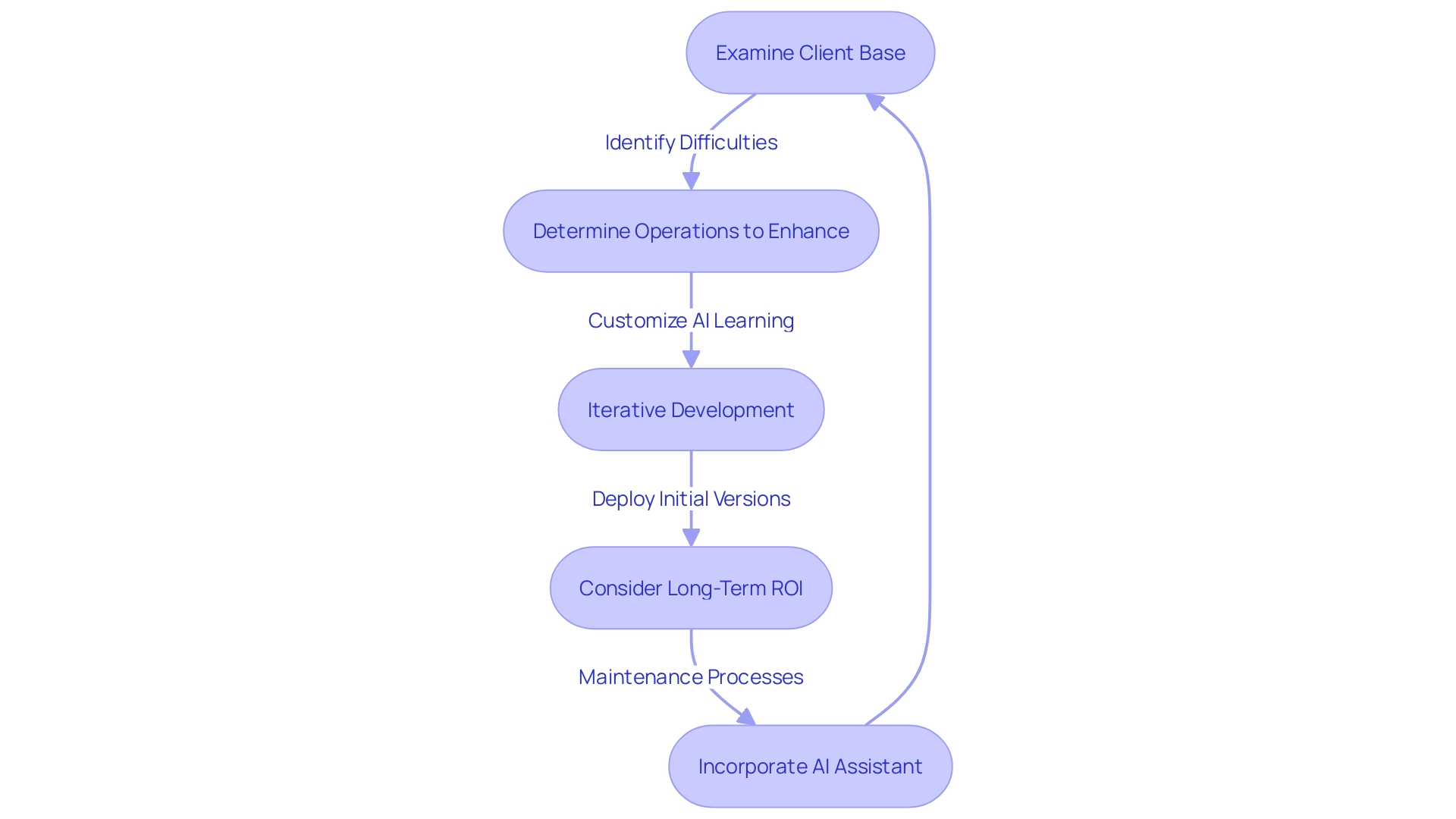
Types of Chatbots: Rule-Based, Intent-Based, AI-Powered, and Hybrid Models
Selecting a chatbot development partner necessitates an understanding of the diverse range of chatbots they can build. Rule-based chatbots follow predefined responses, while intent-based chatbots interpret user intents to provide answers. AI-powered chatbots utilize machine learning to continuously improve interactions. Hybrid models combine these approaches for a more tailored experience. The right partner should match your business goals, whether it’s improving customer support, like FlowSavvy’s experience with rapid query resolution, or enabling a company like ProspectSoft to enhance their reporting capabilities. As the digital landscape evolves, with companies like OPPO integrating AI across their phone lines, the importance of aligning artificial intelligence functionality with your strategic objectives grows. Considerations for ROI, long-term AI integration, and ongoing updates are essential. With Gartner’s forecast of more than 50% of organizations implementing conversational AI agents, and the investment in AI agent creation surpassing conventional application creation, the emphasis on efficient AI agent solutions is evident. Your choice should not only solve immediate user problems but also contribute to a seamless customer journey, leveraging automation to achieve significant operational outcomes.
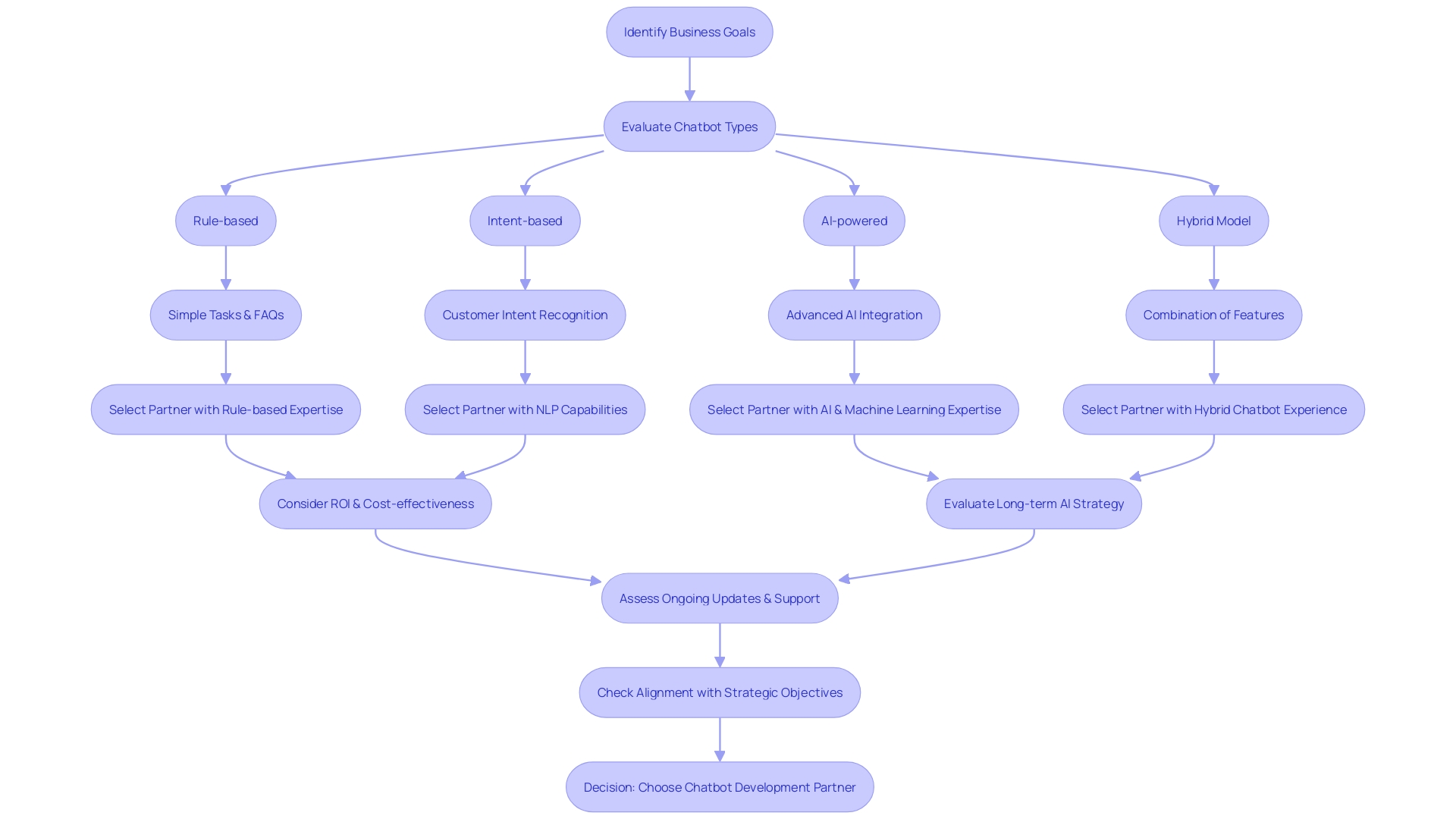
Key Factors to Consider When Choosing a Chatbot Development Company
Choosing a company that specializes in building conversational AI solutions, which aligns with your operational goals, is a crucial decision. Seek out a team with a demonstrated history in AI development and a talent for comprehending and resolving distinct business requirements. The company should provide strong integration capabilities, ensuring that the conversational AI system works seamlessly with existing systems, much like the approach seen in healthcare where digital service teams assess technology for compliance and alignment with current solutions. It’s important to select a partner dedicated to providing a user-friendly and efficient conversational AI experience, as well as continuous support to adjust to evolving user interactions.
Opt for a company that follows a clear, agile development methodology, with transparent pricing structures, and emphasizes quality assurance. They should have a dedicated team that employs both manual and automated testing to ensure the AI assistant operates without hitches. Security is paramount; the company must have stringent data protection policies, employing the latest encryption technologies to safeguard sensitive information. By taking into account these factors, you can establish the foundation for an automated conversational system that not only improves interaction but also adds to operational effectiveness and a favorable return on investment.
Evaluating Chatbot Development Platforms: Ease of Use, Features, and Channels Supported
Selecting the right chatbot development company involves more than just looking at their portfolio; it’s about the technology and platforms they utilize. Ideal platforms are not only user-friendly but also rich in features, supporting a multitude of channels including websites, mobile applications, and various messaging platforms. Scalability and customization are critical as well, allowing for the growth and evolution of business needs over time.
-
LLMChat stands out as a premier all-in-one AI chat interface, distinguished by its intuitive design. Without the need for extensive tutorials, users can navigate its clean interface and access powerful features effortlessly.
-
AI chatbots are not just a trend but a strategic investment, with an impressive capacity to act as sophisticated “co-pilots” for both personal and professional tasks. By 2027, chatbots are expected to become the main service channel for one in four businesses, emphasizing their growing significance (Gartner).
-
The integration of AI into chatbot platforms is proving to be a boon for efficiency. Chatbots are the leaders in lead qualification, gathering vital information from individuals which can then be used to customize the most appropriate offerings. They’re especially effective on main and pricing pages, addressing FAQs and aiding in lead collection.
Statistics indicate that 37% of chatbots also offer user support, highlighting their dual function in both lead generation and client service. The swift response times and elimination of repetitive inquiries not only enhance customer experience but also relieve the customer service team, enabling them to focus on more complex issues.
- When evaluating the long-term ROI of AI integration, one must consider strategic alignment with the product strategy, the processes required for ongoing maintenance and updates, and the opportunity costs involved.
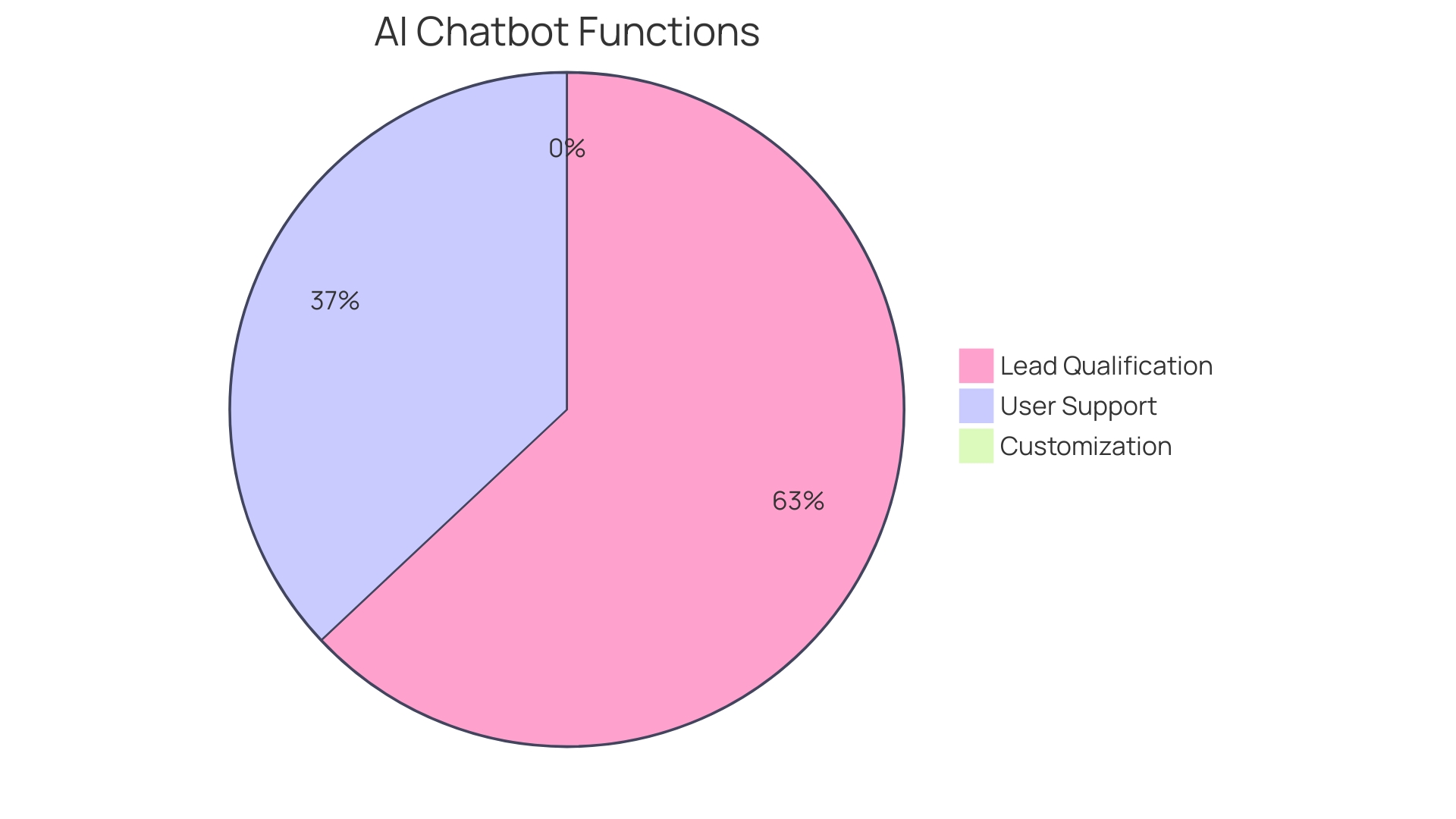
Assessing Integration Capabilities: CRM, Support Desk, and Backend Systems
Choosing a development service for conversational AI involves more than just considering its ability to engage in conversation. Integration with existing systems, such as CRMs, support desks, and backend infrastructures, is vital for creating a cohesive user experience. A chatbot’s capability is enhanced when it can access a wealth of user data, enabling it to provide personalized guidance and expedite support tasks. Consider the success of Open Dialog Ai’s Insurance AI Co-Pilot, which demonstrates how seamlessly integrated AI can enhance interactions without requiring an overhaul of current systems. Moreover, with generative AI techniques, the transition from imperative actions to a more natural, declarative experience is becoming a reality, simplifying complex tasks like querying CRM databases, as seen in the case of a large enterprise client who benefited from a chat-like interface for data access. The integration of AI can automate up to 70% of customer requests, with over half of retail companies already leveraging this technology to boost customer service. Therefore, when assessing potential developers of conversational agents, it’s crucial to verify that they can provide a solution that corresponds to your operational environment and effectively employs generative artificial intelligence and natural language processing to offer an instinctive, productive service to your customers.

Scalability and Customization: Future-Proofing Your Chatbot Solution
As the demand for enhanced interaction grows, organizations are recognizing the importance of developing AI chatbots that are not only scalable but also highly customizable. With a focus on the financial services industry, where the influx of data from market trends to regulatory updates is relentless, an AI-powered virtual assistant can serve as a Knowledge Assistant, streamlining the flow of information. Such an AI conversational agent, particularly one constructed on powerful platforms like AWS, exemplifies how scalability and adaptability are crucial for any solution to effectively handle growing demands and business evolution.
The foresight to select a company specializing in creating scalable solutions with a proven track record is crucial. These solutions must not only manage the volume of interactions but also deliver precise, relevant responses, ensuring financial professionals can access the right information at the right moment, thus avoiding delays and inaccuracies. Furthermore, customization features are integral, allowing the chatbot to be finely tuned to the unique operational needs and user expectations, providing a seamless experience that resonates with both the brand and its clientele.
With statistics indicating a significant pivot towards bots, where over 50% of medium to large enterprises have already integrated chatbots, surpassing traditional mobile app development, the trend is clear. The adoption of AI chatbots is a strategic move that aligns with the digital transformation agenda, driving operational efficiency and enhancing client engagement. The emergence of Large Language Models (LLMs) like ChatGPT and GPT-4 has further propelled the capabilities of conversational AI, despite the concerns over the environmental impact and cost-effectiveness of these technologies.
In conclusion, the integration of AI chatbots into customer communications and internal knowledge management systems is a testament to the value they bring. They are a pivotal tool for the modern enterprise, not only in terms of automation and efficiency but also as a strategic asset that can adapt and scale with the business, ensuring long-term relevance and competitive edge.
Cost Considerations: Total Cost of Ownership and Ongoing Maintenance
Choosing a partner for building a conversational AI requires a thorough understanding of the expenses involved. This goes beyond just the initial outlay for development; it encompasses the total cost of ownership, which includes licensing, hosting, and ongoing support and maintenance. It’s crucial to not only compare the pricing models of various providers but to also delve into the specifics of their fee structures. For an accurate cost assessment, consider the frequency of end-user engagement with the conversational AI system and determine the most suitable unit of measure for your cost analysis, such as the cost per conversation. Recent developments in AI, like GPT-4 Turbo, have shown cost reductions, indicating a trend towards more affordable AI solutions. However, a meticulous evaluation of direct and potential ancillary expenses remains paramount. As the industry advances, with upgrades like GPT-4 Turbo’s improved abilities and cost-effectiveness, it’s crucial to stay updated about the most recent advancements that could impact the economics of your conversational AI project.
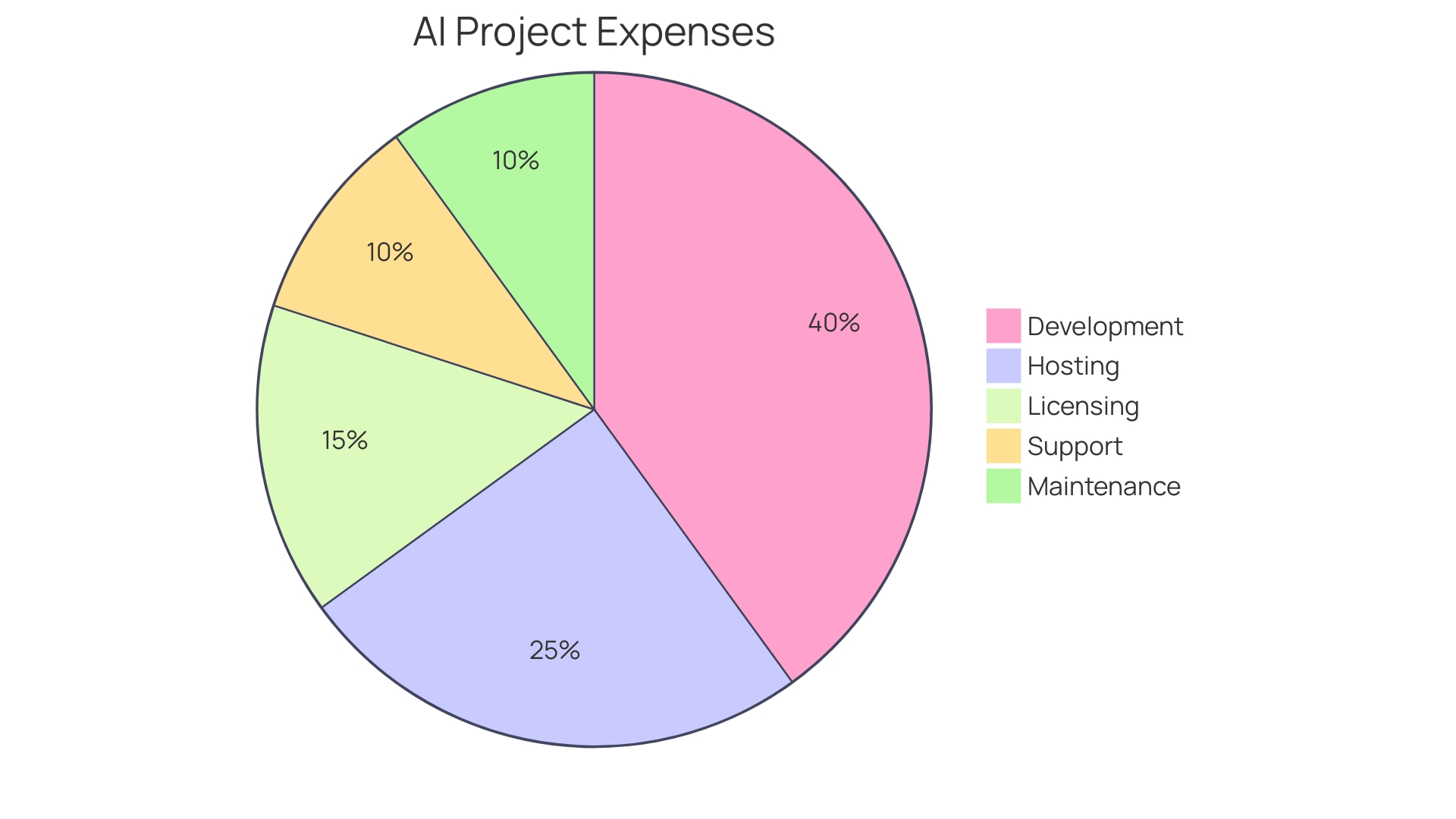
Case Studies: Successful Chatbot Implementations and Lessons Learned
Choosing the appropriate development service for conversational AI can be crucial for improving user interactions in different sectors. To make an informed decision, scrutinize the case studies of potential providers. These documents are a treasure trove of insights, revealing a company’s technical acumen, strategic approach, and the tangible benefits they delivered to clients. For instance, a healthcare organization could deploy an AI conversational agent to optimize operations and address staffing gaps, directly influencing patient care. Similarly, a travel company like Holiday Extras utilized AI to overcome language barriers and promote data fluency among employees, showcasing the versatility of conversational AI applications.
When reviewing case studies, pay attention to the specific challenges that were addressed and how the automated messaging system contributed to overcoming them. Evaluate the metrics employed to measure the impact of the automated conversational agent on operational effectiveness and client contentment. For instance, the adoption of chatbots in retail has led to the automation of up to 70% of customer requests, indicating a significant enhancement in user interaction and service quality.
Additionally, pay attention to any current digital solutions within a company that may coincide with the suggested automated messaging system. This due diligence ensures that resources are efficiently allocated and that the AI assistant delivers novel capabilities rather than duplicating existing tools.
Ultimately, a successful chatbot development company will not only provide a robust technological solution but also offer strategic insights that align with your long-term digital transformation goals. By examining their case studies with a critical eye, you can ascertain whether they have the expertise to tailor their services to your unique industry challenges and user interaction needs.

Conclusion
In conclusion, integrating a chatbot into your business requires careful planning and analysis. By leveraging AI and taking a strategic approach, you can streamline tasks, enhance user engagement, and drive operational efficiency. When choosing a chatbot development company, consider their track record, robust integration capabilities, user-friendly experiences, and ongoing support.
Evaluate chatbot development platforms based on ease of use, features, and scalability. Assess integration capabilities to ensure seamless integration with existing systems. Scalability and customization are essential for future-proofing your chatbot solution.
Consider the total cost of ownership and ongoing maintenance. Review case studies of successful chatbot implementations to gain insights into a company’s expertise. By considering these factors and making an informed decision, you can develop a chatbot that enhances user interactions, drives operational efficiency, and contributes to your company’s success.
Introduction
The insurance industry is undergoing a transformative shift, driven by the integration of automation and advanced technologies. This shift is not just a buzzword; it’s a reality that is reshaping the way insurers process claims, underwrite policies, and provide customer service. With the implementation of AI, machine learning, and business rules engines, insurers are now able to process vast amounts of data with unparalleled efficiency.
This automation not only reduces manual workload but also enhances accuracy, streamlines operations, and improves customer satisfaction. In this article, we will explore the benefits of automation in insurance, its impact on underwriting, claims processing, risk management, and customer service. We will also discuss the challenges and considerations in implementing automation and highlight successful case studies.
Furthermore, we will delve into the evolving role of automation in the insurance industry and its future outlook, emphasizing the opportunities it presents for insurers to distinguish themselves in a competitive market. So, let’s dive into the transformative potential of automation in the insurance industry.
Benefits of Automation in Insurance
The revolution of claims and underwriting through mechanization is not only a visionary concept; it is the current actuality reshaping the sector. With the integration of advanced technologies like AI and machine learning, insurers are now able to process vast amounts of data with unparalleled efficiency. For instance, the implementation of business rules engines has significantly reduced the manual workload for underwriters, allowing them to focus on more strategic aspects of risk assessment. Automation in the insurance realm goes beyond mere buzzwords, fostering a new era of accuracy and expedited service that benefits both the providers and their clients.
Recent advancements have seen a worldwide deployment of around 3.5 million industrial robots, marking a new era in the field of mechanization, particularly within the automotive and electronics sectors. The service industry is not far behind with the rise of chatbots and IoT devices, signifying a broader adoption of these transformative solutions. This surge in automation aligns with reports showing that a majority of senior executives, about 77%, are now embracing AI, reflecting a significant increase from prior years.
The effect of these changes on the coverage sector is significant. Traditional methods of underwriting, once bogged down by manual data entry and the potential for human error, are now streamlined by automated systems, ensuring consistency and reducing operational costs. The once arduous task of manually reviewing claims and policy risks is now supported by sophisticated algorithms that enhance the underwriting process. These innovations not only drive efficiency but also open doors to new levels of operational excellence and client satisfaction, thus securing a competitive edge in the dynamic landscape of risk coverage services.
Automation in Underwriting: Precision and Speed
Automation is revolutionizing the underwriting process of the industry by replacing the traditional, manual approach with advanced algorithms and data analytics. This digital transformation is enhancing the precision and velocity of risk evaluation, which is crucial in determining the terms of coverage policies. By automating the underwriting process, insurers can now process data with unprecedented quickness, reducing the likelihood of human error and operational costs associated with manual data entry. With 77% of senior executives reporting the adoption of AI in their operations, it’s evident that technology is becoming an integral part of the industry. This shift is not just about efficiency; it’s about the evolution of the sector, as insurers embrace new technologies to stay competitive and meet the growing demands of the digital age. Moreover, the introduction of AI and business rules engines is allowing underwriters to focus on more strategic tasks, transforming their role to one that leverages human expertise with machine efficiency.
Automation in Claims Processing: Efficiency and Accuracy
Automation has notably transformed the industry, particularly in the realm of processing. By integrating advanced technologies, companies in the insurance sector can now expedite the intake, evaluation, and settlement phases of claims. This evolution has led to more streamlined operations, diminished manual inaccuracies, and swifter resolutions for claimants.
In the complex procedure of insurance adjustment, the assessment and resolution of demands are crucial. Adjusters, particularly in the context of fire-related claims, are relying more and more on visual documentation provided by images to evaluate the damage. These images are essential for assessing the extent of structural and personal property damage, acting as undeniable evidence throughout the process of making a case. The visual records aid in verifying assertions and establishing equitable remuneration, thereby improving assertion validation.
The emergence of generative artificial intelligence (GenAI) has further propelled the sector into the future. GenAI aids in modernizing the claims process in several ways, including improving customer experience during the First Notice of Loss intake. It enables a more efficient assessment of policy coverage and aids in identifying missing information, summarizing key points, and highlighting areas requiring clarification.
Despite the promising applications of AI in the field of risk management, a significant number of companies continue exploring how to fully harness its potential. While 91% of financial services and risk protection leaders acknowledge launching AI proofs of concept, only 36% report widespread application across business functions. This suggests a terrain ready for expansion and creativity, with a critical requirement for a fail-fast strategy and cultural consciousness within the sector.
The market for insuring is at a crossroads, faced with deciding whether to lead or follow in the GenAI revolution. A strong ethical framework and transparency about the performance of digital tools are essential to navigating this new terrain. Indeed, as the sector transitions from traditional practices to digital channels, the role of AI in risk assessment and underwriting has become increasingly important. With 87% of carriers and TPAs acknowledging the necessity for creative services in processing, the utilization of AI to back underwriting has turned into an inventive approach to technology used for risk evaluation.
In general, the operational change of the insurance sector towards digital solutions, combined with the strategic use of artificial intelligence, is shaping a new model in claims processing and underwriting. The transformative potential of AI is propelling the sector towards more efficient, accurate, and customer-centric operations.
Automation in Customer Service: Personalized and Responsive
The integration of generative artificial intelligence (GenAI) into the industry has been transformative, especially in enhancing customer service. With over 91% of leaders in the financial services and insurance industry initiating AI proofs of concept, the shift towards using technology is evident, particularly in the handling of insurance claims and the assessment of risk. In fact, a study shows that only 36% are using AI extensively, highlighting a significant opportunity for growth.
Property and casualty insurers have been pioneers, leveraging GenAI to meet customer expectations for rapid response and personalized service. Jack Martin from The General, an American Family Insurance company, underscores this trend by deploying technology to meet customers where they are, like with their mobile app.
Moreover, customer service statistics reveal a telling demand for immediacy: 45% of consumers expect their issues resolved in the first interaction, and almost half demand responses in under four hours. This sense of urgency is especially evident in processing of claims, where a survey conducted by Sollers Consulting and Ipsos revealed that 52% to 63% of customers give high importance to rapid response, with the highest expectation in the UK at 63%.
The drive for mechanization in assertions is additionally bolstered by the understanding that prompt assertions handling surpasses even the remuneration sum for client fulfillment. The financial services sector has seen operational improvements and technology enhancements become as critical as customer experience, a dramatic shift from seven years prior. This convergence of priorities sets a new bar for customer care functions to excel across the board, blending efficiency with exceptional service.
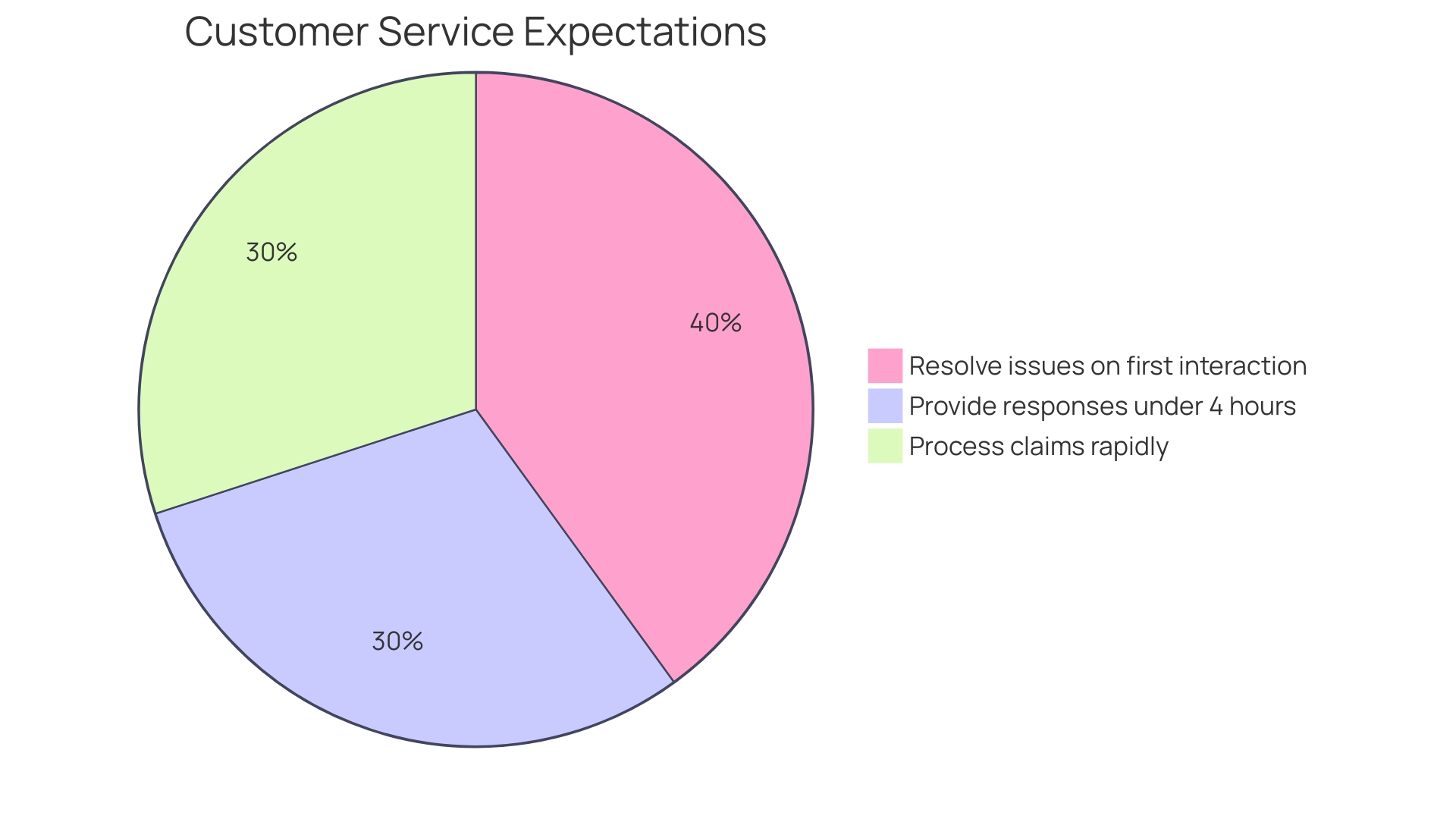
Automation in Risk Management: Enhanced Risk Assessment
Automation and intelligent solutions are quickly creating a new path in the industry, especially in the areas of risk management, underwriting, and claims processing. The traditional methods of underwriting, with their manual data entries and time-consuming processes, are being replaced by innovative technologies that streamline operations and provide more accurate risk assessments. For instance, the integration of predictive modeling and advanced data analytics enables a more precise evaluation of policyholder risks, transforming the landscape of risk management.
The transition to automation is emphasized by a significant movement among executives in the insurance sector, with a survey indicating a 16 percentage point increase in AI adoption over the previous year. This showcases an increasing acknowledgment of the value provided by AI and other technologies in enhancing efficiency and accuracy in the sector of risk coverage. The use of AI not only accelerates underwriting and claims processes but also offers personalized coverage options by analyzing vast amounts of data, which significantly aids in fraud detection and loss prevention.
Furthermore, the current economic scenery, with its increasing expenses and changing consumer behaviors, underscores the necessity for the auto coverage sector to adopt technological advancements. Automation is not just a trend but a necessity to future-proof organizations against the evolving demands of the business world. For example, AI and business rules engines are reducing routine tasks, thus enabling underwriters to focus on strategic challenges that require their expertise.
As the industry continues to move away from conservative perceptions and towards a tech-forward future, it’s clear that technology, which has been the backbone of the industry since the 1960s, will play an even more critical role. Underwriters are now empowered to manage data more efficiently, communicate with stakeholders, and apply sophisticated risk analyses with the assistance of AI, leading to a more streamlined and effective risk management practice.
Challenges and Considerations in Implementing Automation
Implementing mechanization in the sector involves a multifaceted approach to enhance the underwriting process, traditionally known for its meticulous, manual methods. The integration of automation propels this cornerstone of risk management into the digital age, streamlining workflows, improving productivity, and elevating operational efficiency. Automating underwriting allows for rapid analysis and processing of data, cutting down the time-consuming tasks of human underwriters. However, it’s not without challenges, such as navigating the complexity of mixed structured and unstructured data, which can block the efficient processing of applications across various coverage lines. AI and machine learning stand out as powerful tools to overcome these obstacles, enabling effective data management and prioritization.
The insurance sector is also dealing with the rapid pace of technological advancements. Leaders play a critical role in guiding transformation, ensuring the adoption of AI is meaningful and aligns with established rules and regulations. For example, New York’s recent regulatory guidance emphasizes the responsible use of AI, underscoring the need for ethical applications that avoid unfair practices. Meanwhile, insurers are tapping into Ai’s potential to expedite underwriting and claims processing, leveraging historical data for risk evaluation, detecting fraud, and producing precise loss reports. The rise of large-language-models (LLMs) in the business world is evidence of the transformative potential of AI, which is currently being utilized to analyze the extensive and complex data that insurers deal with on a daily basis.
Although the field of insuring has historically progressed at a leisurely pace, there is an increasing need to adopt AI and mechanization due to their evident advantages in productivity and customer contentment. Nonetheless, the transition brings forth considerations regarding the interplay between technology, employment, and the requisite skills for a changing workforce. As we explore further into the technology revolution, it’s vital to tackle the ethical and employment implications of AI and mechanization, ensuring that the workforce is ready and that there is equitable opportunity for all to participate in this new era of work.
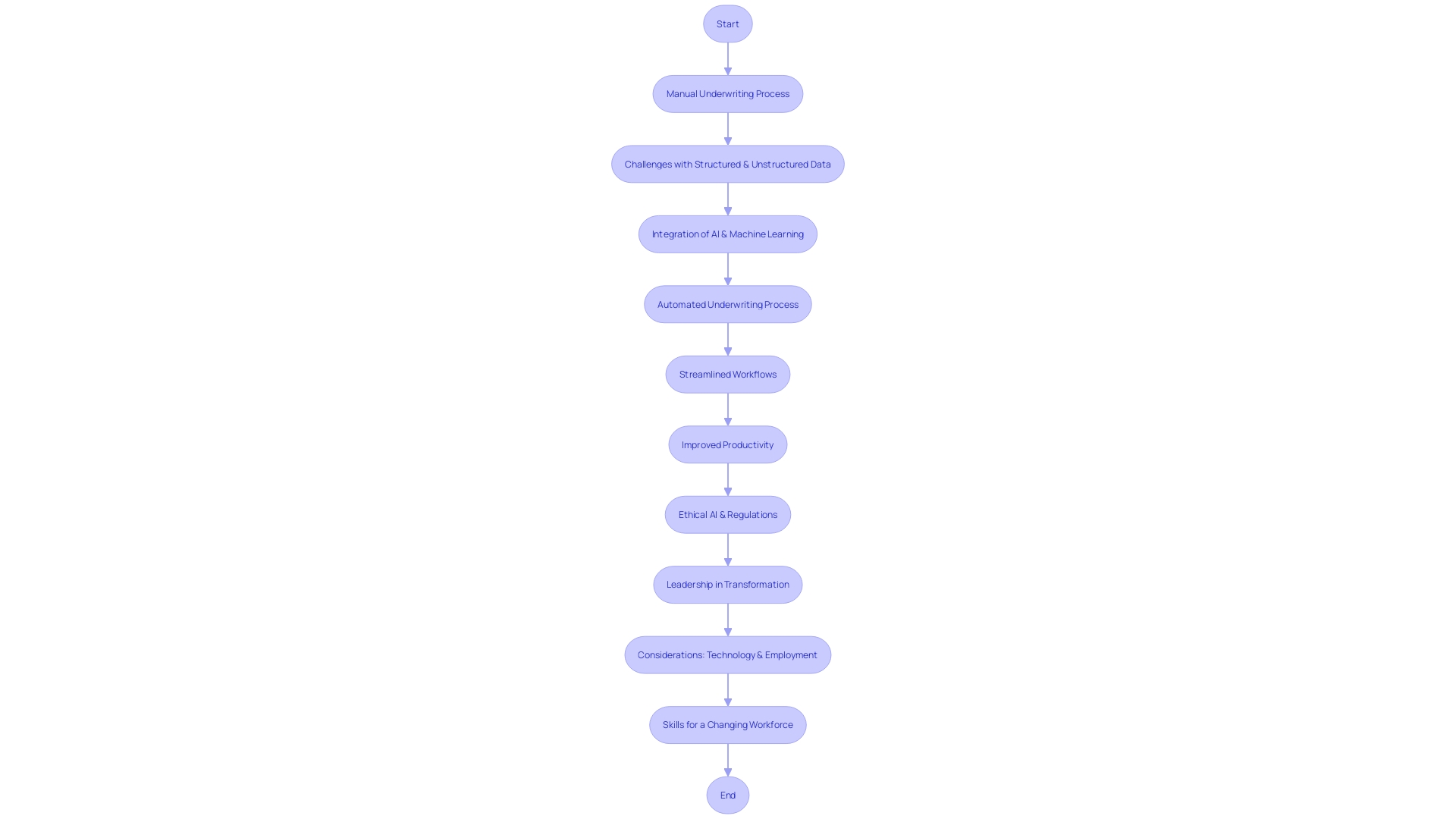
Case Studies: Successful Automation in Insurance
The incorporation of mechanization into the industry of assurance is transforming the scenery of claims and underwriting, greatly improving the client experience and streamlining operational efficiency. For instance, Alm. Brand Group, a notable Danish insurer, has started a new endeavor with Cognizant to automate a range of business procedures, including the management of policies and routine administrative tasks. This strategic move is aimed at bolstering the company’s competitive edge by refining efficiency and elevating the customer experience.
Similarly, Mutua Madrileña, the top insurer in Spain, has addressed the intricacy of its IT system by adopting technology solutions to accelerate incident resolution and lower operational expenses, resulting in enhanced overall efficiency and user satisfaction. These real-world deployments highlight the transformative potential of mechanization in the insurance sector.
A recent survey by Sollers Consulting and Ipsos unveils an important trend: customers prioritize speedy processing of insurance requests, with a significant percentage across various countries citing prompt response times as a top expectation. This feedback is pushing insurers to expedite their claims efforts to meet customer demands for speed and efficiency.
Further highlighting the move towards AI technologies, a comprehensive survey highlights that a marked increase of 16 percentage points has occurred in the number of senior executives adopting AI technologies within the year. This adoption signals a departure from the traditional perception of the insurance field as slow to embrace change, showcasing instead its history of integrating new technologies to support its operations.
As we delve into the future of risk and innovation, it becomes clear that AI and business rules engines are playing a pivotal role in reducing mundane tasks, allowing underwriters to focus on more strategic aspects of their roles. The ever-changing aspect of underwriting, marked by intricate data management and risk analysis, is being transformed by the use of technology, resulting in enhanced and mistake-free processes.
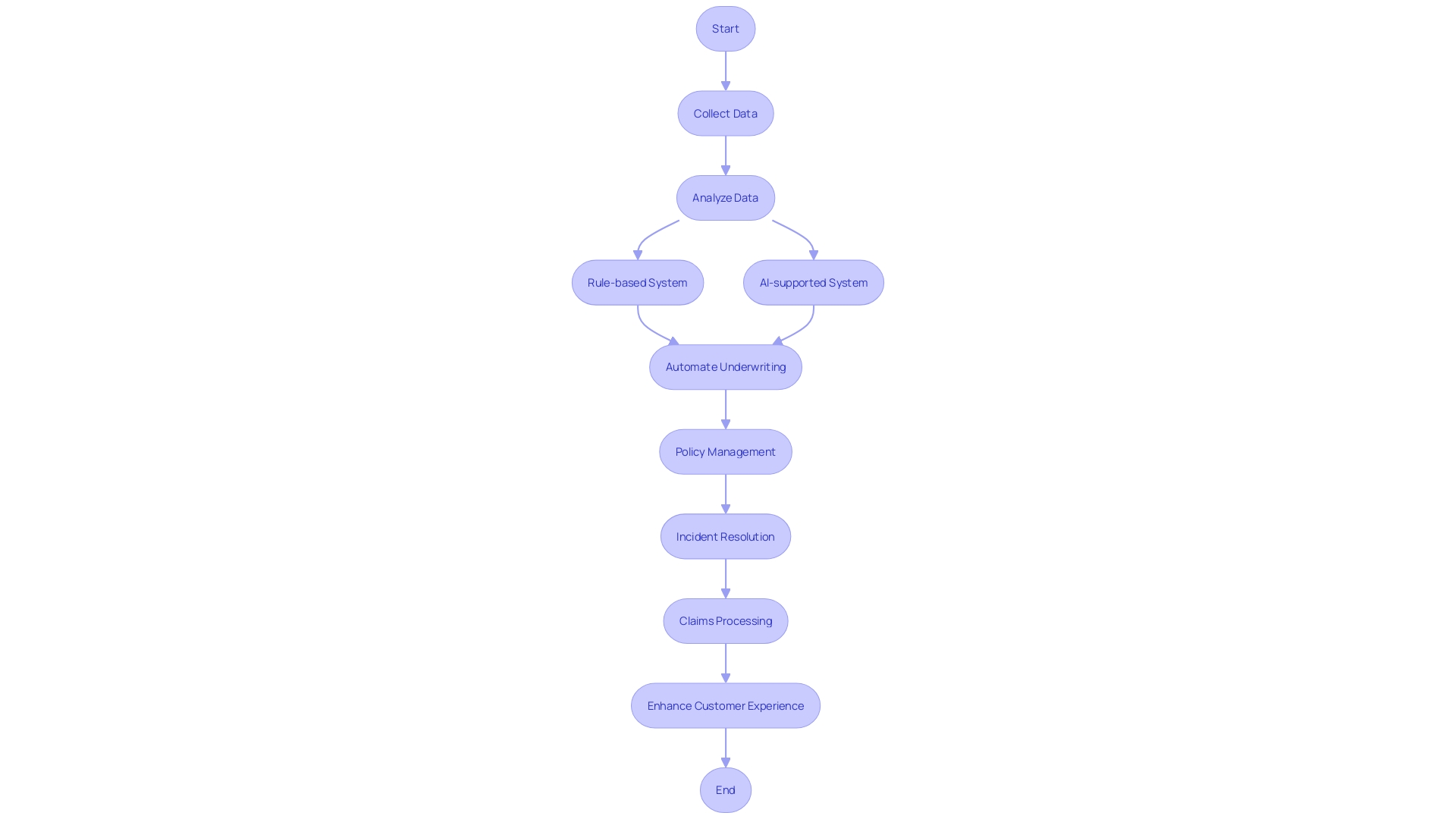
Future Outlook: The Evolving Role of Automation in Insurance
As technology progresses, its influence on the insurance industry is becoming more and more significant. Introducing mechanization into the underwriting process, for instance, has marked a significant shift from traditional methods that were slow and error-prone. Now, insurers are utilizing the power of mechanization to analyze and process data with unparalleled speed, enabling them to bypass the burdensome manual work that once weighed down human underwriters.
The transformative effects of automation are not limited to underwriting alone. AI and business rules engines are streamlining various tasks, freeing up underwriters to focus on more complex, strategic issues. The introduction of AI, which has been adopted in some form by 77% of senior executives, reflects a dynamic shift in a sector often misperceived as resistant to change. In reality, the insurance sector has a long history of embracing new technologies, from the early days of punch cards to the current era of tablets and mobile devices.
Despite these advances, the demands on underwriters remain high. A typical day involves sifting through copious emails and performing meticulous data entry into multiple systems—all while conducting sophisticated risk analysis. However, the future holds promise, as advancements such as Generative AI have the potential to revolutionize the field. By leveraging large-language-models (LLMs) to analyze the vast troves of data generated daily, insurers stand on the cusp of a revolution in data processing and risk assessment.
Furthermore, as the field maneuvers through a terrain characterized by economic changes and increasing consumer demands, the implementation of mechanization technologies is not only about keeping up—it’s about spearheading the advancement into a future where operational effectiveness and forward-thinking are crucial for achieving success. The necessity for insurers to actively adjust is emphasized by the fact that macroeconomic factors such as inflation and the possibility of recession are imminent threats to business growth, according to insights from leaders in the field.
In essence, the ongoing integration of automation into insurance claims and underwriting is not just reshaping workflows—it’s redefining the industry’s future, presenting opportunities for insurers to distinguish themselves in a competitive market.
Conclusion
In conclusion, automation is revolutionizing the insurance industry. It improves efficiency, accuracy, and customer satisfaction across claims processing, underwriting, risk management, and customer service. With advanced technologies like AI and machine learning, insurers can process data efficiently, reduce manual workload, and streamline operations.
This provides a competitive advantage in a rapidly evolving market.
Automation in underwriting replaces manual approaches with advanced algorithms, enhancing the speed and accuracy of risk evaluation. It allows insurers to process data quickly, reducing human error and operational costs. Underwriters can focus on strategic tasks, combining human expertise with machine efficiency.
In claims processing, automation expedites the entire process, resulting in streamlined operations and faster resolutions for claimants. Generative AI improves customer experience, assesses policy coverage, and identifies missing information, enhancing efficiency and accuracy.
Automation also transforms customer service, meeting expectations for rapid response and personalized service. By leveraging AI, insurers can provide efficient and immediate support to customers, enhancing overall satisfaction.
In risk management, automation streamlines operations and provides accurate risk assessments. Predictive modeling and advanced data analytics enable precise evaluation of policyholder risks, aiding in fraud detection and loss prevention.
Implementing automation comes with challenges, such as managing mixed data and ensuring ethical use of AI. However, the benefits in efficiency and client satisfaction make it a necessary transition. Addressing ethical and employment implications is crucial for a smooth transition.
Successful case studies highlight the transformative potential of automation in the insurance industry. These examples demonstrate improved efficiency, customer experience, and operational effectiveness. The future outlook for automation in insurance is promising, with advancements revolutionizing underwriting, claims processing, and risk assessment.
Automation presents opportunities for insurers to stand out in a competitive market.
In summary, automation is reshaping the insurance industry, offering practical solutions to improve efficiency, accuracy, and customer-centric operations. It is a vital tool for insurers to stay competitive, adapt to evolving demands, and provide exceptional service in a rapidly changing landscape.
Take advantage of automation to stand out in the competitive insurance market!
Introduction
CRM and sales automation are revolutionizing the way businesses operate, offering practical solutions to the Director of Operations Efficiency’s challenges. These technologies are streamlining sales and marketing processes, reducing time spent on repetitive tasks, and enhancing productivity. With the integration of AI, businesses are leveraging predictive analytics and machine learning to deepen customer relationships and personalize engagements.
Small businesses are embracing sales automation software to enhance sales strategy and drive revenue. Real-world case studies demonstrate the tangible benefits of CRM and sales automation across various industries. In the manufacturing sector, automation is tackling the complexity of product portfolios and improving customer satisfaction.
Integrating CRM with marketing automation is vital for seamless lead transition and personalized marketing campaigns. CRM automation enhances efficiency by automating tasks and workflows, freeing up time for strategic initiatives. It also ensures data accuracy, unlocks valuable insights, and supports informed decision-making.
Implementing CRM and sales automation requires evaluating business needs, selecting the right tools, migrating data, and providing comprehensive training. By following best practices, businesses can fully harness the power of CRM and sales automation, optimize efficiency, and drive business growth.
Benefits of CRM and Sales Automation
CRM and sales automation are revolutionizing the landscape of company operations, delivering a potent impact of efficiency and scalability. With the right tools in place, companies are tapping into streamlined sales and marketing processes, reducing the time spent on repetitive tasks, and enhancing productivity across the board. A unified CRM system not only improves internal workflows but also elevates the customer experience by ensuring consistent, high-quality interactions across all touchpoints. The significance of a seamless customer journey becomes clear when considering that 62% of customers might share a negative experience with others, while a staggering 66% of millennials demand real-time interactions. Additionally, 40% of consumers will avoid enterprises that don’t support their preferred communication channels, emphasizing the need for a CRM that can capture and respond to these diverse consumer preferences.
The incorporation of AI in CRM is propelling enterprises into a new era of market strategy, with predictive analytics and machine learning leading the charge in customer data utilization. These advancements are not only streamlining operations but are also cultivating deeper customer relationships through more personalized and timely engagements. Small enterprises, especially, are adopting AI tools, with 42% of micro-enterprises utilizing this technology to remain competitive. Software for streamlining sales has become an essential resource for small businesses looking to enhance their sales strategy and boost revenue.
The tangible effect of customer relationship management and sales streamlining is apparent in documented examples from different sectors. For instance, the AFL experienced the transformative power of data consolidation in boosting grassroots participation, while Delivery Hero overcame the challenge of account lockouts, which had previously led to significant downtime for its large workforce. These examples demonstrate the concrete advantages of adopting CRM and sales streamlining: from enhanced grassroots involvement to enhanced IT service delivery, the benefits reach across a wide range.
In the manufacturing industry, the use of technology is addressing the intricacy of product portfolios, aiding sales representatives in providing accurate quotes and handling multiple manual tasks with improved efficiency. This change is crucial as manufacturing representatives struggle to manage multiple clients, product catalogs, and manual processes, often resulting in errors and customer dissatisfaction. By automating these tasks, companies are witnessing fewer delays, chargebacks, returns, and, most importantly, happier customers. Moreover, recognition for user-friendly sales management platforms like Salesflare underscore the industry’s acknowledgement of tools that provide simplicity, rapid configuration, helpful customer support, and substantial ROI.
Ultimately, CRM and sales optimization serve as foundations for contemporary enterprises seeking success in a competitive environment. By adopting these technologies, companies are not only streamlining their operations but are also setting the stage for sustained growth and customer satisfaction.
Key Features of CRM Automation
CRM is transforming the way businesses manage their operations and engage with customers. At the heart of this transformation are key features like lead management, which streamlines the process of tracking and nurturing potential clients. This not only saves precious time but also enhances the accuracy of your sales funnel. Likewise, contact management becomes effortless with CRM technology, as it carefully captures and organizes every detail about your contacts, ensuring that all interactions are personalized and timely.
The effectiveness of CRM shines in opportunity tracking, enabling companies to pinpoint and pursue promising leads with precision. This targeted approach is supported by the latest AI-driven tools that offer deep insights into customer behavior and market trends, driving strategic decision-making. Furthermore, sales forecasting is enhanced through CRM technology, providing a clear vision of future sales and helping businesses to prepare effectively.
These features are not just theoretical benefits; they are practical solutions to real-world problems. For example, the use of technology has proven its value in the email outreach process, where it has significantly reduced the time and resources required to obtain new contacts. Moreover, companies such as Delivery Hero have utilized technology to minimize the downtime caused by locked-out accounts, saving numerous hours every month that were previously wasted in manual recovery procedures.
The implementation of CRM automation is not just a fad; it is a strategic decision that is shaping the future of marketing and efficiency. The insights provided by Pipedrive CEO Dominic Allon highlight the industry’s transition towards AI-driven innovations that enhance the crucial human interaction in commerce. With tools that facilitate improved management and a more effective sales process, businesses are positioned to flourish in an increasingly competitive landscape.
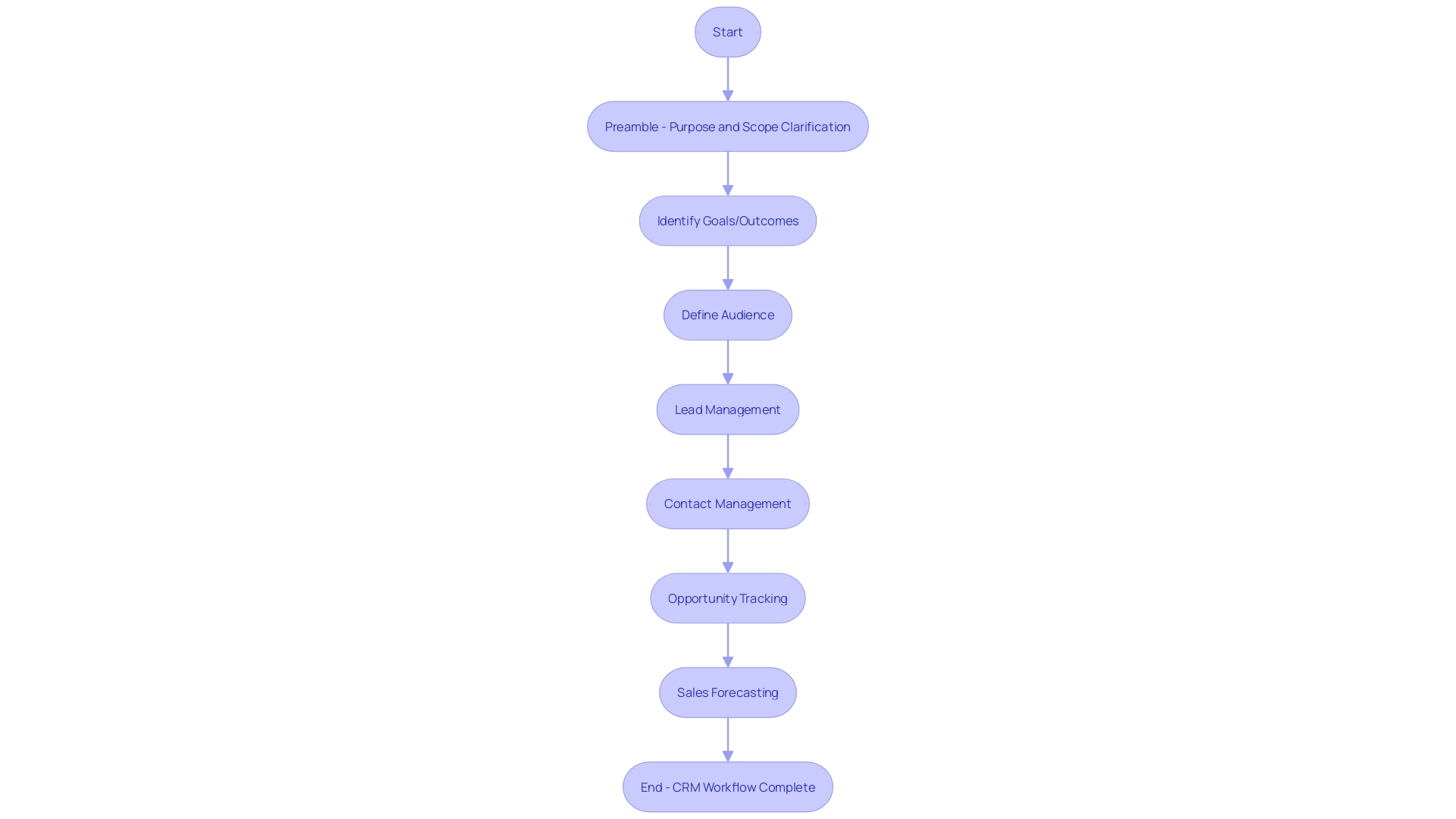
How CRM and Sales Automation Enhance Efficiency
CRM and sales management are increasingly becoming the key components of sales and marketing efficiency. By automating repetitive tasks, these tools free up time for teams to focus on more strategic initiatives. For example, the history of Centroplan, a part of the Pohlen Gruppe with a legacy spanning over 125 years, emphasizes the profound effect of sales streamlining. The company faced a significant challenge with time-consuming manual work, particularly in creating offer documents. Implementing document automation within their Salesforce ecosystem allowed them to expedite the sales cycle and enhance their sales team’s productivity.
Furthermore, embracing CRM platforms like Salesforce’s Customer 360 can lead to interconnected data across systems and devices, forming a comprehensive customer view. This integration is not just about technology; it’s about creating a seamless and consistent customer experience across various communication channels, such as phone, email, and social media. Customization options within these platforms enable organizations to tailor workflows and interfaces that best fit their operational needs, thereby streamlining processes and improving efficiency.
As highlighted by Pipedrive CEO Dominic Allon, the advent of AI-driven innovations has brought about remarkable growth and efficiency in business operations. In spite of this technological advancement, the human factor remains indispensable in marketing and advertising. The strategic use of sales enablement resources, as advised by industry leaders, can significantly accelerate the process by equipping teams with the right tools and information. In the end, incorporating CRM and sales management into organizational processes not only enhances operational effectiveness but also promotes the flexibility and durability of sales teams in a changing market environment.
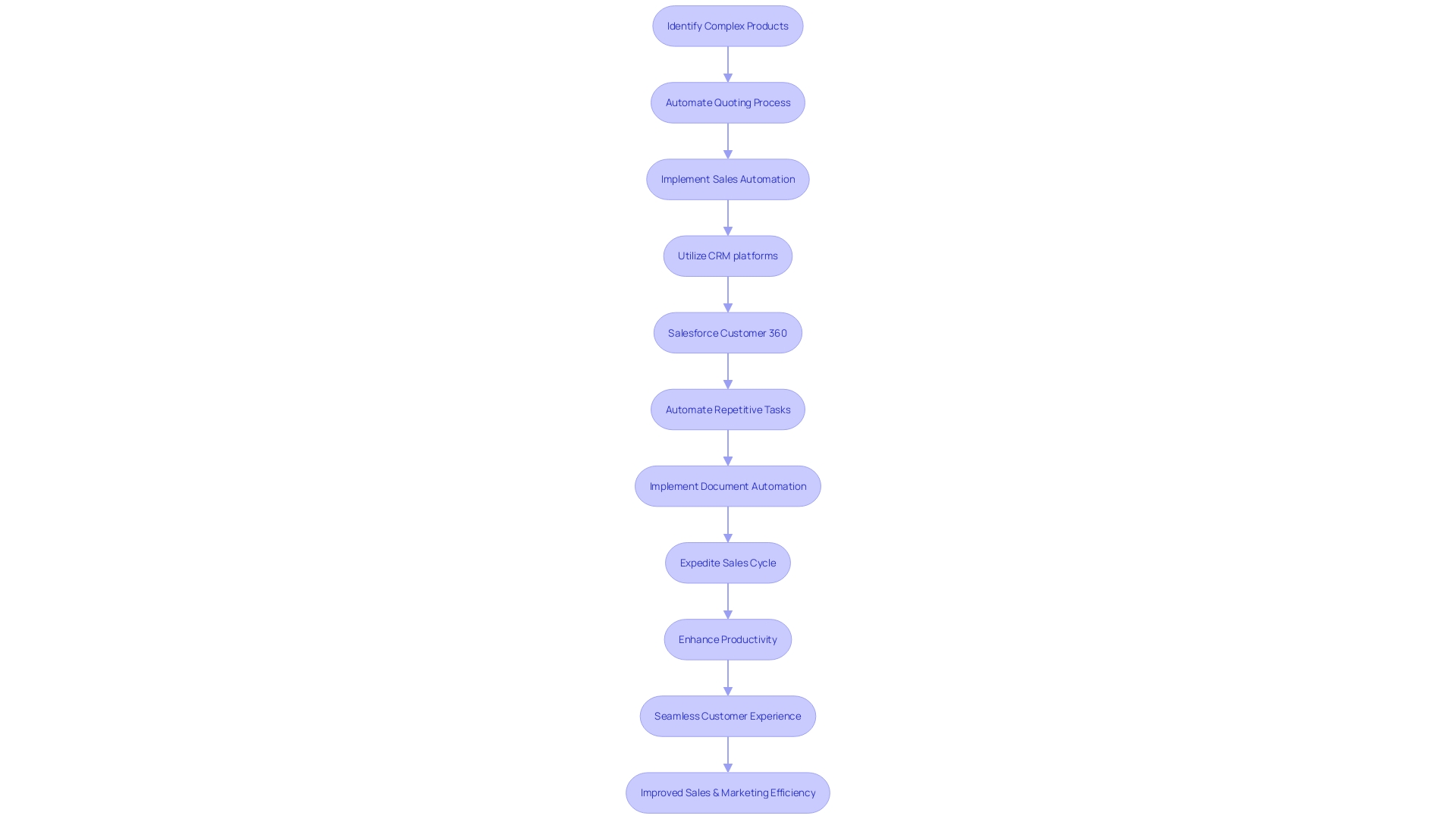
Streamlining Sales Processes with CRM
Customer relationship management (CRM) has become an essential tool for manufacturing enterprises and businesses with intricate sales procedures. By utilizing the capabilities of automation, companies can efficiently handle their extensive product portfolios and minimize the risk of human error in pricing and marketing duties. Automation streamlines lead management, ensuring that follow-ups are scheduled and executed without manual intervention, thus enhancing the overall pipeline management.
Manufacturers frequently manage numerous customers, extensive catalogs, and a variety of manual selling activities, which can result in expensive errors such as delays and chargebacks. Customer relationship management (CRM) addresses these difficulties by offering a systematic approach to selling that reduces mistakes and enhances customer contentment. For instance, SugarCRM’s solutions concentrate on aiding businesses in enhancing their process efficiency through strategic sales.
Recent trends in the Australian manufacturing sector highlight the importance of integrating CRM systems across supply chains for improved efficiency. Companies such as Speedpanel have embraced these advancements to revolutionize their industry. Furthermore, data shows a notable change towards workflow mechanization, with an astonishing 94% of business leaders preferring a consolidated system for application integration and process mechanization.
The implementation of CRM is not just about the technology but also about the strategy that accompanies it. As Clate Mask, CEO of Keap, puts it, “You can throw a piece of software at a problem; that’s not going to solve it. You need the strategy and the services to go with it.” This comprehensive approach to streamlining empowers small businesses to harness the full potential of CRM tools across all operations, driving growth and efficiency.

Integrating CRM with Marketing Automation
To excel in the current data-centric setting, it is essential for marketing and sales teams to combine customer relationship management (CRM) and marketing technology. The synergy between these two systems enables a smoother transition of leads from marketing to sales, ensuring no opportunity is missed. Parkhotel Adler, a historic hotel with a legacy of 16 generations, found that their outdated technology stack was impeding their ability to engage in modern marketing strategies. By adopting CRM technology, they could have streamlined their processes for segmentation and personalization without the system crashes that plagued their legacy database tool.
Utilizing CRM technology enables more personalized marketing campaigns by leveraging a rich repository of customer data. This targeted approach creates a cohesive journey for the customer, exemplified by Apple’s integrated marketing communications strategy, which maintains a consistent look and feel across all platforms. The result is a seamless customer experience from the first online ad they see to the follow-up email after a purchase, reflecting the kind of integrated strategy that modern businesses need.
Furthermore, CRM mechanization offers a organized selling procedure that can be effortlessly pursued and duplicated. A solid sales process, supported by CRM, involves stages from lead generation to contact, qualification, proposal, and finally, winning the deal. Data migration into a singular CRM platform is a crucial first step in achieving a unified view of customer information, which is essential for security and efficient lead management.
Businesses must confront the challenge of managing and making sense of vast amounts of data. Investing in powerful CRM and marketing tools, as well as bringing in data experts or upskilling current teams, can help convert overwhelming data into actionable insights. With a well-integrated system, companies can expect to see improved productivity, lower costs, and a more customer-centric approach to their business operations, driving growth and productivity across the board.
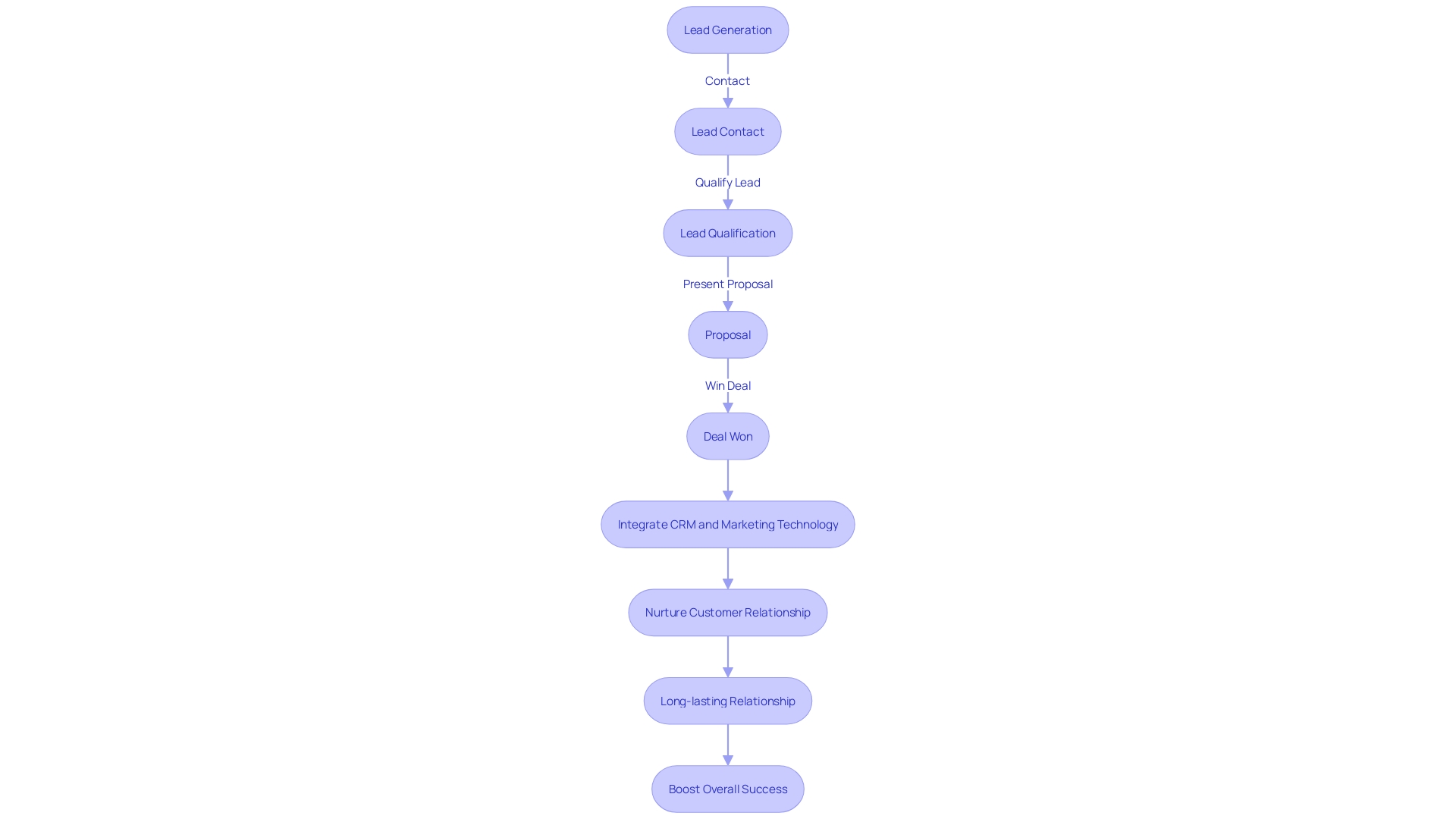
Automating Sales Tasks and Workflows
Customer relationship management streamlines tasks and workflows, resulting in significant improvements in productivity. For manufacturing enterprises with complex product portfolios, where sales representatives manage multiple clients and extensive catalogs, automation is crucial. It reduces human error and delays, preventing chargebacks, returns, and customer dissatisfaction. By automating repetitive tasks such as email campaigns, task management, and overall workflow, companies can ensure a more efficient process.
Recent developments in CRM technology, such as Microsoft Dynamics 365’s 2024 release, offer promising enhancements for businesses. These tools come equipped with capabilities that include automated lead scoring, personalized email marketing, and seamless integration with other software. This is particularly relevant given that, according to Pipedrive’s Annual State of Sales and Marketing report, small companies are increasingly adopting AI tools to bolster their sales and marketing efforts.
Furthermore, statistics show a widespread tendency to adopt workflow streamlining across industries. An overwhelming 94% of executives prefer a unified platform for integrating apps and automating processes. The push for mechanization is further emphasized by findings that over one-third of businesses have mechanized at least five divisions, and 45% have corporate teams engaged in the mechanization process.
Implementing CRM platforms for sales is not only focused on effectiveness; it involves creating accurate, customer-centric approaches. Ai’s role in account planning allows for the analysis of historical data, revealing insights that inform tailored strategies. Likewise, the challenging process of lead generation is transformed through the use of technology, which can rapidly identify leads with greater conversion potential, saving time and enhancing the chances of successful engagements.
In order to stay competitive and develop strong customer relationships, it is now essential to incorporate CRM integration into sales and marketing strategies as we progress. The time of manual, mistake-prone sales processes is being overshadowed by an automated, data-driven approach that guarantees to reshape the way organizations interact with their clientele.

Data Accuracy and Analytics with CRM Automation
Utilizing CRM technology is crucial for ensuring accuracy in data and unlocking valuable insights that drive efficiency and growth. It starts with evaluating current data management practices; for instance, Truthset works with organizations to diagnose and validate their data’s precision for improved outcomes. Scott McKinley of Truthset highlights that more accurate data drives financial and other results, emphasizing its transformative potential.
CRM automation addresses the concern of data accuracy head-on. Techniques such as data cleansing in Salesforce, which entails correcting or removing corrupt records, are fundamental to maintaining data integrity. This process not only rectifies inaccuracies but also enriches data, ensuring that the database supports effective decision-making and enhances customer relationships.
Moreover, a study revealing significant variations in data accuracy across providers, with match rates ranging from 32% to 69%, underscores the necessity for a reliable data cleansing process. Inaccurate data is costly, wasting billions annually and leading to poor decision-making.
But it’s not just about cleaning data; it’s about what you do with it. Analytics and data science news indicates that companies are leveraging advanced CRM analytics for a competitive edge. For instance, Alteryx was acquired for $4.4 billion, demonstrating the high value placed on analytics tools.
Moreover, services like Portera’s Green Tick offer a symbol of reassurance for data quality, ensuring that data is accurate at every reporting stage and paving the way for improved organizational decisions. With a focus on validation and management, such services prevent the costly consequences of poor data quality, such as lower revenue and higher operational costs.
Ultimately, the integration of AI-powered insights into CRM systems empowers organizations with the analytics needed for informed decision-making. By ensuring data accuracy and providing comprehensive analytics, CRM streamlining is a cornerstone of operational efficiency and strategic growth.
Implementing CRM and Sales Automation for Business Growth
Choosing and deploying the appropriate CRM and sales automation tools can be transformative, driving your company’s growth by improving efficiency. This entails multiple essential steps, beginning with assessing your needs to ensure that the CRM system aligns with your objectives. Reflect on the goals you wish to achieve, be it expanding your product lines or increasing revenue, and consider how CRM can support these ambitions. Engage with department heads and team members to understand their requirements and anticipate how a CRM system could enhance their performance.
Once you’ve assessed your needs, the selection process begins. Survey the market for CRM software that serves companies of your size, with an emphasis on solutions that provide adaptability and the capacity to customize your platform. Tools like NetSuite CRM, Creatio customer relationship management (CRM), and Act! CRM are designed to foster lasting customer relationships and streamline day-to-day tasks efficiently, often supporting multiple languages and catering to small to mid-size businesses.
The data migration phase is critical; it involves transferring your data from siloed sources like emails and spreadsheets to a unified CRM system. This step was pivotal for organizations like the AFL, which sought to work more effectively with schools and community organizations to increase grassroots participation. By centralizing data, the AFL improved its ability to track and understand program effectiveness.
Training your team is essential for successful implementation. Provide comprehensive training to ensure a smooth transition and encourage adoption. Evaluate the effectiveness of tools for enhancing sales processes, focusing on capabilities that enhance productivity and expansion, such as anticipatory data analysis and lead administration.
Finally, change management is a vital aspect of the process. As with the case of Ty, a soft toy manufacturer, replacing a 15-year-old communication system with a modern, cloud-based solution required careful planning and execution. The shift to a new customer relationship management and sales process enhancement platform will require a comparable level of dedication to enhance data analytics and adaptability for your teams.
By adhering to this manual, which is influenced by practical instances and specialist perspectives, you can successfully execute CRM and sales mechanization to fulfill the changing requirements of eco-friendly production and stimulate business expansion.
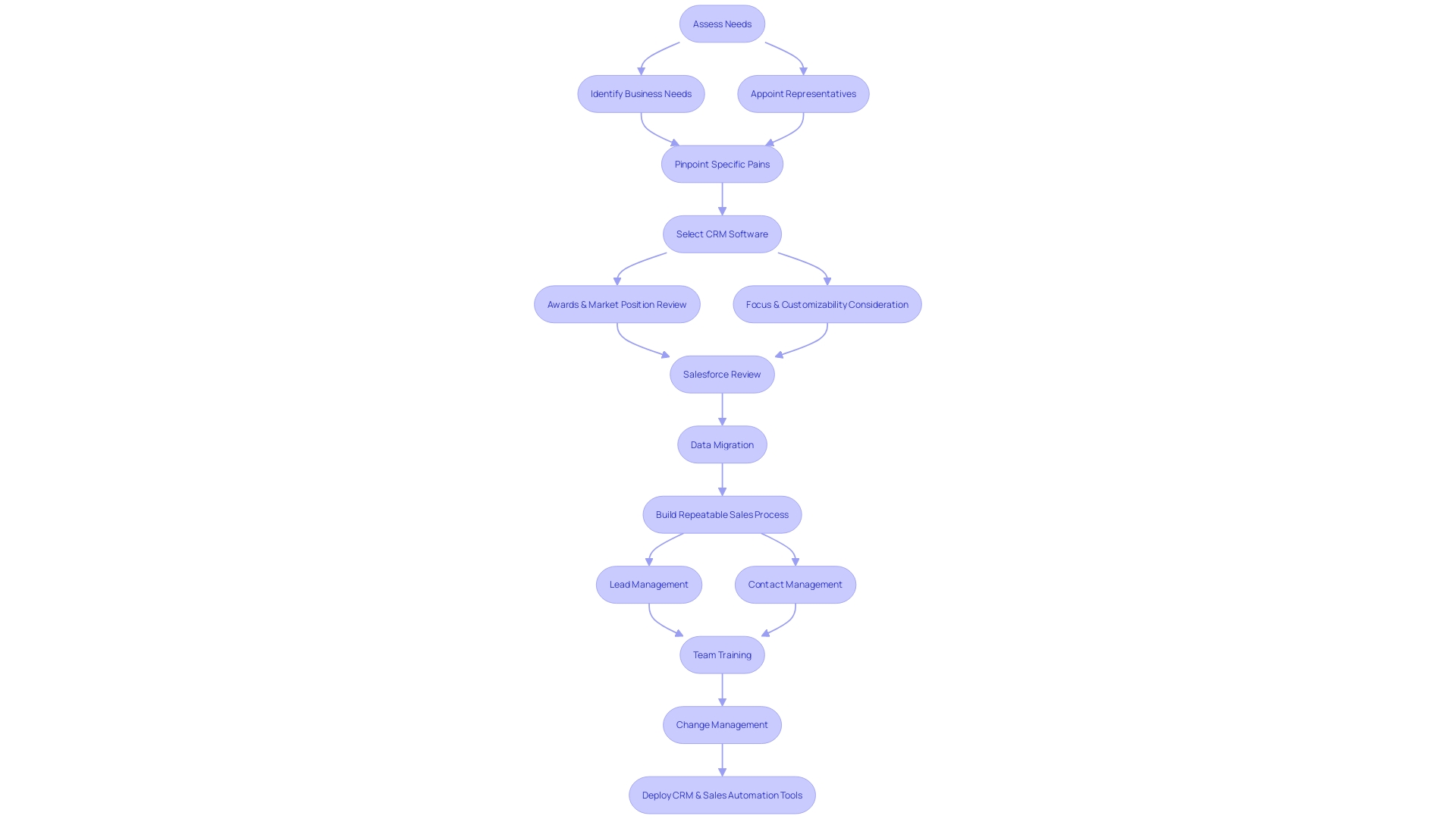
Best Practices for CRM and Sales Automation Adoption
To fully utilize the potential of CRM and automation in customer relationship management, a strategic approach is vital. It starts with creating a transparent sales procedure that directs leads from the first expression of interest to completed agreements, covering stages like contact, evaluation, and proposal. By incorporating CRM tools, organizations can effectively manage customer relationships and stimulate revenue growth. For example, outlining your business process could follow a path from recognizing potential leads to effectively closing them as customers. Creating a roadmap that aligns with this process, while also engaging key stakeholders, is vital for fostering user adoption and ensuring a smooth implementation. Additionally, it is crucial to continuously refine these processes, taking cues from successful examples like the AFL’s initiative to increase grassroots participation by efficiently coordinating with schools and community organizations using a unified data system. Furthermore, embracing AI technology can provide predictive analytics and customer insights, transforming the way companies interact with their clients and manage leads. These top practices not only optimize operations but also contribute to a substantial boost in productivity, as emphasized in a recent report by Pipedrive CEO Dominic Allon, highlighting that AI innovations have been instrumental in propelling growth. By prioritizing a well-defined sales process, involving stakeholders, and leveraging AI, businesses can optimize their CRM and sales automation efforts to achieve greater efficiency and profitability.
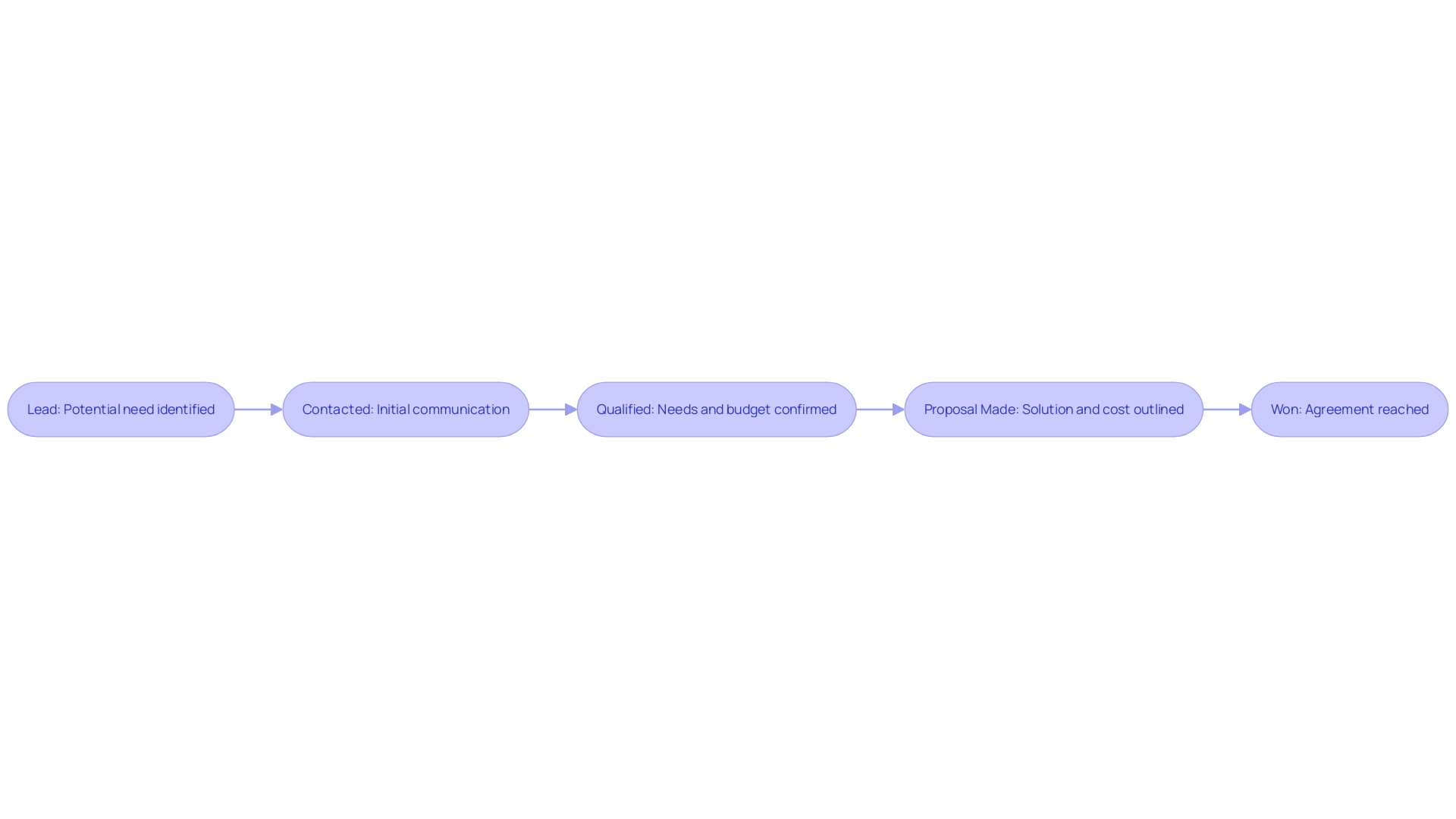
Conclusion
In conclusion, CRM and sales automation offer practical solutions to streamline sales and marketing processes, reduce repetitive tasks, and enhance productivity. By integrating AI, businesses deepen customer relationships and personalize engagements. Real-world case studies across various industries demonstrate the tangible benefits of CRM and sales automation.
Implementing CRM and sales automation requires evaluating business needs, selecting the right tools, migrating data, and providing comprehensive training. By following best practices, businesses can optimize efficiency and drive growth.
Key features of CRM automation, such as lead management, contact management, opportunity tracking, and sales forecasting, streamline processes and drive strategic decision-making. Integrating CRM with marketing automation ensures a seamless transition of leads and personalized campaigns.
CRM automation transforms sales processes, reducing human error and improving customer satisfaction. It streamlines tasks and workflows, freeing up time for strategic initiatives. The adoption of CRM automation is a strategic move that shapes the future of sales and marketing efficiency.
Integrating CRM with marketing automation is crucial for personalized marketing campaigns and a cohesive customer journey. A well-integrated system improves productivity, lowers costs, and fosters a customer-centric approach.
CRM automation streamlines tasks and workflows, leading to significant productivity gains. Recent developments in CRM technology offer promising enhancements, including AI-driven tools for deep insights and efficient sales processes.
Harnessing CRM automation ensures data accuracy and unlocks valuable insights. Data cleansing and enrichment are crucial for maintaining data integrity. Analytics tools provide a competitive edge and support informed decision-making.
Selecting and implementing the right CRM and sales automation tools is transformative for business growth. It involves evaluating business needs, selecting flexible platforms, migrating data, providing comprehensive training, and managing change effectively.
By adopting CRM and sales automation, businesses thrive in a competitive landscape, streamline operations, and drive growth and customer satisfaction.
